

The Saint University Announces New Partnership with Art UK
THURSDAY 27 FEBRUARY 2025 | WWW.THESAINT.SCOT | ISSUE 287
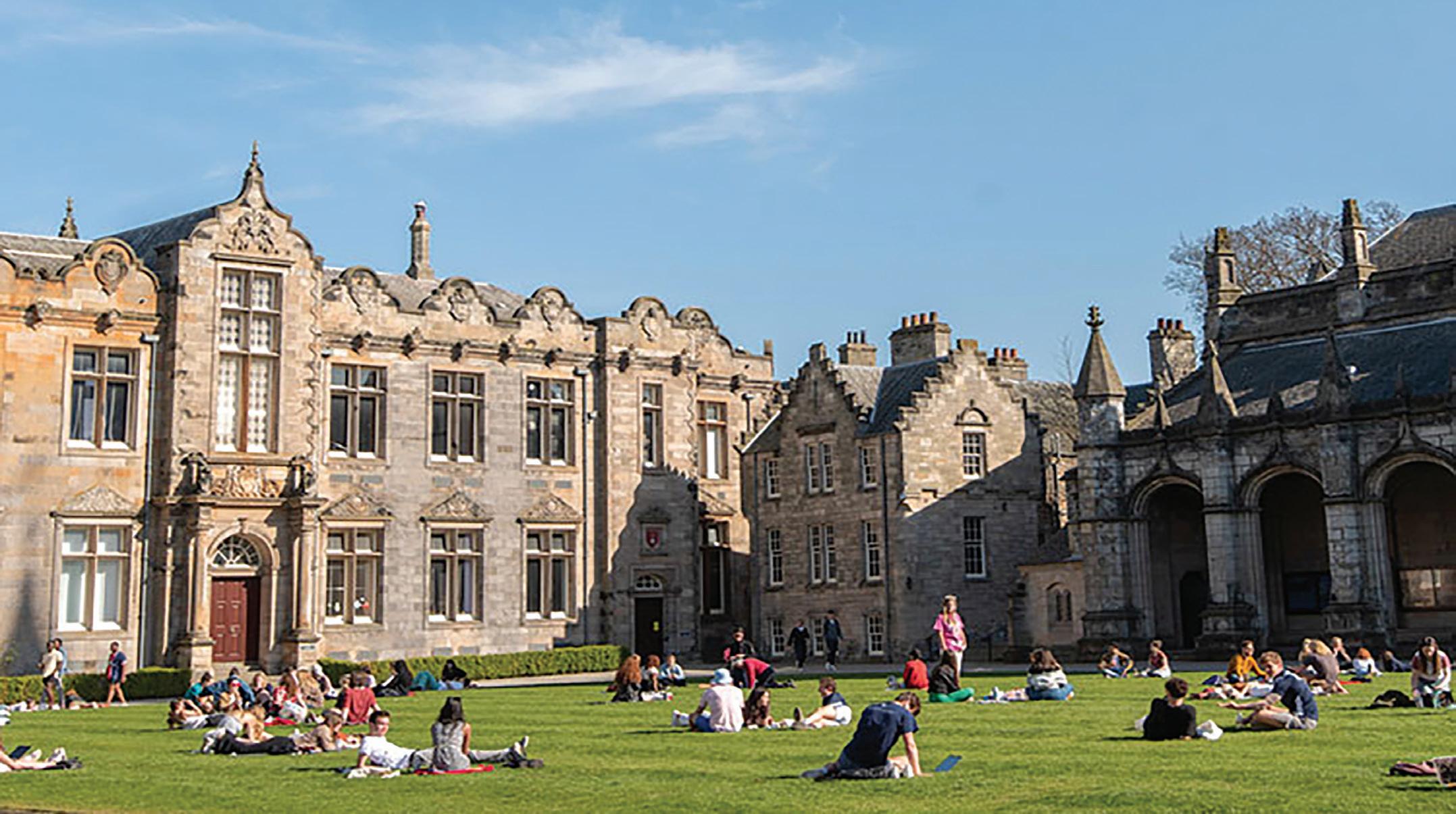
The School of Art History at the University of St Andrews has announced a new partnership with Art UK, a leading education charity, to research and share the stories behind the nation’s publicly owned art. The partnership will enable academics from the School of Art History to publish content and develop learning resources accessible to Art UK’s extensive audience of 5.5 million annual users. Art UK currently showcases more than 400,000 works by over 55,000 artists. It continues to expand its digital platform, increasing public engagement with art collections across the United Kingdom.
The initiative aligns with the School of Art History’s broader commitment to advancing Digital Art History and exploring digital-born art. In addition to the partnership, the School has launched new online
short courses and an MLitt program in Digital Art History. Furthermore, the partnership directly supports two strategic goals outlined in the School’s 2021-2026 plan: expanding the reach of its scholarship beyond academia and strengthening alliances with museums and research collaborators at local, national, and international levels.
Dr Emily Savage, co-ordinator of the School’s fully online postgraduate program in Digital Art History, played a key role in establishing this partnership and is spearheading efforts to develop publication opportunities through Art UK. She emphasised the importance of increasing access to lesser-known public art collections across the country.
“When people think of public art collections, they probably think of big-name institutions like the National Gallery. Less appreciated, but no less significant, are local authority collections or collections held by libraries, heritage bodies, or even hospi-
tals. These institutions are often important pillars of their communities, but don’t have the digital infrastructure to make their collections more accessible or widely known,” Savage explained. “Digital tools, like those offered on Art UK’s platform, can foster creativity and support well-being, but they can also encourage in-person engagement too.”
The partnership has already begun to influence academic curricula at the University, particularly within the MLitt in Digital Art History program. Students utilise data from Art UK’s extensive database to explore various research topics. In one module, for instance, students explore data from Art UK’s database relating to the representation of women artists in public collections, visualise the data and analyse their findings, and situate their conclusions within wider scholarship on women’s artistic education, the histories of collecting by public institutions, and femi-
Continued on Page 4
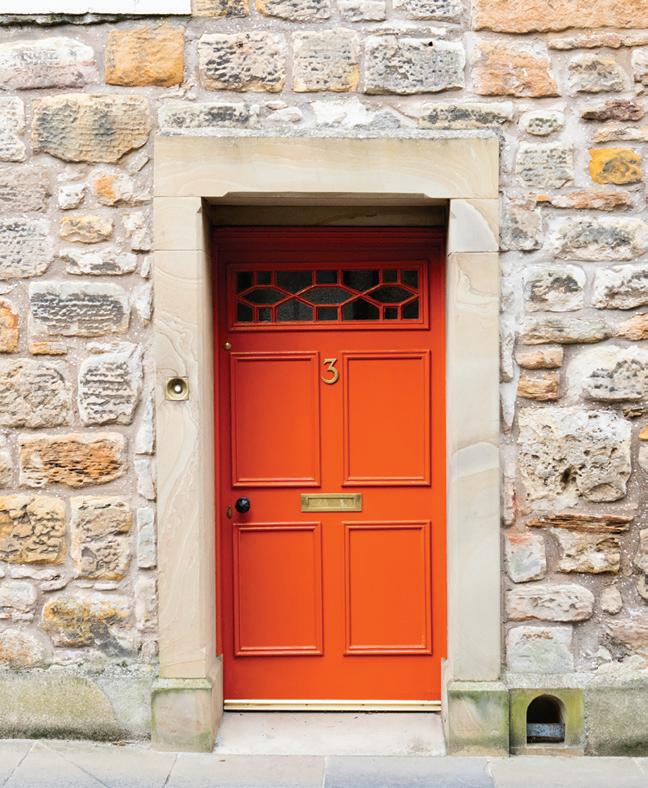
Houses of Colour: The Doors of St Andrews by
Tricia Merone
Read on Page 17.
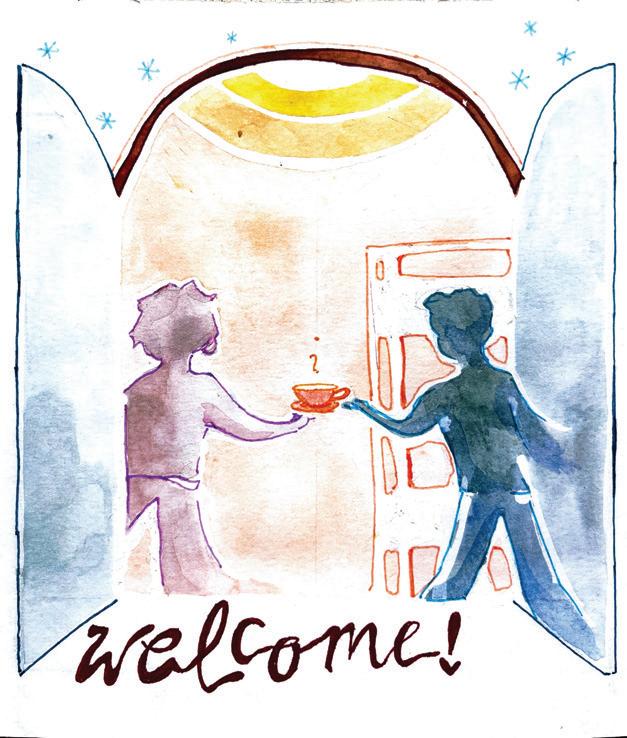
“They’re Not ‘The Other’” by
Hannah Heilman
Off of Market Street sits a man in his 60s with a grey beard, a winter puffer, and boots he says have left his toes numb. He has a pot with a few coins that passersby have tossed in, a handwritten sign detailing his time in “Her Majesty’s troops,” and two teddies that have brought him “luck and good people.” Read on Page 13.
ROWAN HOOVER News Writer
What’s Inside?
In this issue, Sandy Walls has reported on research showing how whales have some sort of language system. The largest mammals, inhabiting huge oceans, learn and teach each other songs. Please stay with me as I reflect on this groundbreaking discovery. My British flatmate’s friend from home visited a few weeks ago and laughed when my friend used the American “practice” instead of the British “training”. Last weekend, one of my fellow Americans used “tomeight-toe” instead of the British “tom-atoe”. Even I, a native of the American South, caught myself recently with the classic “jumper” misnomer. For years, I have attempted to ignore differences in accent. I am a proud proponent of the idea that if you only talk about the correct way to pronounce “crayon” or “garage” when you meet someone with a different accent, you will never get to the conversation topics that build connections and relationships. It’s a fine conversation opener, but too often I’ve seen (and experienced) the subject taken too far. I’d rather talk about our similarities than our differences. So, for three years now, I have ignored accents. I haven’t attempted to learn the regional accents of the UK, I barely notice international accents when I meet someone new. I have convinced myself that accents don’t matter — that is until my sister asked why I sounded so British over Christmas. She wasn’t necessarily right, I definitely don’t sound British, but

she wasn’t wrong — I did sound different. Maybe it was the one or two pieces of slang or the way I was telling her to take the exit to Target. My voice had changed.
As an English Literature student, I have known language to be a powerful connector that ties us together, but I have realised recently this is especially true in St Andrews. The international student voice congeals based on who you spend time with, but so does your behaviour. Your music tastes broaden when someone new has the aux, a random word said at the pub as a joke makes its way into your everyday vocabulary, and your coffee order changes when your friend makes you try a London Fog. Although the sentiment may not be as dramatic as I am a mosaic of everyone I have ever loved, perhaps, in St Andrews, it is pretty close.
My accent isn’t British now, but St Andrews has changed it. Most of us have learned some words here or there and we may say these words for years just because our paths cross in this small town. Call us whales singing to each other through the deep blue, but I like the thought of saying herb the way you do because of all the times we’ve cooked together. Have a great week, St Andrews, and enjoy this week’s issue. Take a break from the library to go outside with a friend to try out the puzzles page, if weather and deadlines permit, and have a (well-deserved) break next week. Riley.
“Quote of the Issue: “Love the life you live. Live the life you love.” - Bob Dylan
David Buchan Editor-in-Chief
Riley Raab Editor-in-Chief
Pietro Barbini Business Manager
Mary Henderson News Editor
Georges Toulouse Viewpoint Editor
Simon Ezra-Jackson Features Editor
Alex Le Sage Puzzles Editor
Alden Arnold Photography Editor
Arnaz Mallick Arts & Culture Editor
Ilaria Freccia Deputy Editor-in-Chief
Hannah Shiblaq Deputy Editor-in-Chief
Alex Barnard Events Editor
Ana-Lucia Chalmers Science & Technology Editor
Mahaley Wise Sport Editor
Isabelle Holloway Head of Illustration
Armaan Madanmohan Senior Copy Editor
Natalie Olofsson Podcast Editor
Maria Ebrahim Head of Web & Social Media

EDITOR: MARY HENDERSON
New Research Reveals Language-Like Structure in Whale Song
SANDY WALLS News Writer
New research from an interdisciplinary group of academics, including Dr Ellen Garland from the University of St Andrews, has discovered a new structure in whale song, a structure shared in human languages. The study highlights how certain aspects of our own languages, previously thought to be unique to our species, are present elsewhere in the natural world. Significantly, the team discovered that whale song is a culturally transmitted communication system and is therefore not an instinctive behaviour. Like human language, whales must learn their song from each other.
The team used an innovative method inspired by the way babies learn languages to
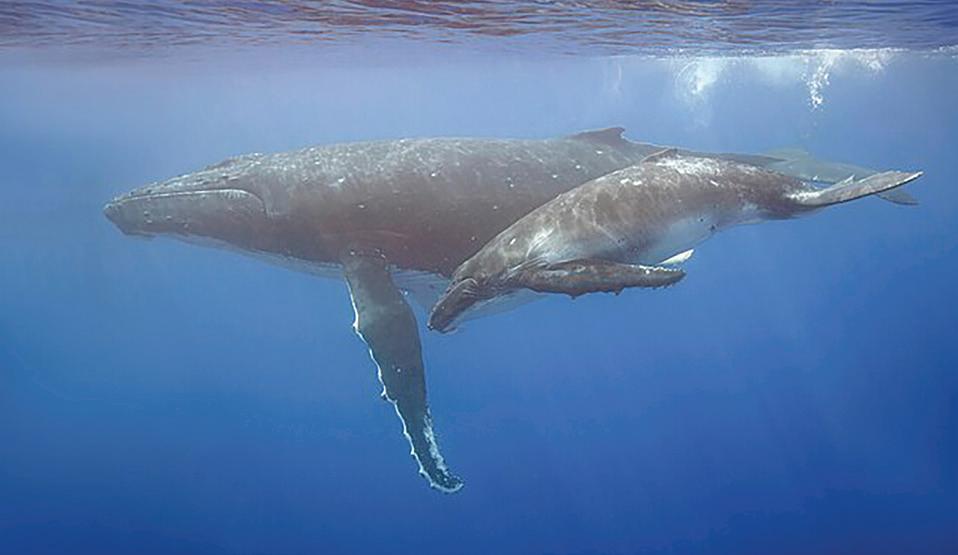
uncover the hidden structure of whale song. Dr Garland expanded on this process, “There are no pauses between words, so infants have to discover word boundaries.” The process characterises the key challenge of learning a language: knowing where one word ends and another begins. Just as infants use “lowlevel statistical information” to understand these boundaries, so did the research team use the statistical structure of whale song to divide its distinct elements. “We used the exact same cue that infants use to segment the whale song,” explained Dr Garland. This process was applied to eight years’ worth of humpback whale songs recorded in New Caledonia. Researchers “calculated the transitional probabilities between each two consecutive sound elements,” according to Dr Garland, and marked divides “when the next sound element was surprising given the previous one.” Through this technique, the whale song was successfully cut into sub-sequences. After analysing this dataset, it was discovered that “they follow the same distribution found across all human languages.”
Dr Inbal Arnon, who works for the Language Learning and Processing
Lab at the Hebrew University, noted that whale song data followed “a particular power law distribution found in all human languages.” This refers to ‘Zipf’s Law’, an empirical principle that has notably been applied to languages. In this context, it reveals that the most common word in a language appears twice as frequently as the second most common, and so on. While this law has been known to be true for most human languages, its relevance for whale song is a novel revelation.
Dr Arnon spoke on the implications of this finding, “Language is the way it is […] because of the way it is learned and transmitted over generations. This process creates learnability pressures […] which shape its structure.” By studying the communication style of these aquatic animals, the research has resulted in an increased understanding of the evolution of language itself. However, whale song is not considered a language; Dr Garland made the important distinction that whale song “lacks semantic meaning.” Instead, she structurally compared it to music, “a culturally transmitted behaviour where individual ‘units’ do not have explicit expressive meaning and nevertheless show a good fit to a Zipfian distribution.” The meaning of whale song, as it were, relates to its function. Whale song is a male-only practice and is
believed to be used for finding mates. The structure of this song “is suggested to aid in learning such a long, complex display.”
Both Dr Garland and Dr Arnon have stressed the importance of working with academics from a variety of fields in this project. “These novel findings could only have been discovered by a team of scientists from very different disciplines working together,” affirmed Dr Garland. Such a sentiment was echoed by Dr Arnon, who attested that “by integrating insights and methods from three very different fields: child language learning, language evolution, and whale song research,” the new structure in whale song was able to be discovered.
The findings of the study demand further investigation into the statistical structures of culturally transmitted communication systems. Dr Garland and Dr Arnon both suggest that songbirds likely display similar patterns of communication, and the investigation into whale song “opens up new research directions for investigating other species,” as Garland stated.
The study has enriched the appreciation and knowledge of humpback whales and their communication methods, alongside expanding understanding of the nature of languages.
National Focus Stories from Scotland
SAFIRA SCHIOWITZ News Writer
74-year-old protester arrested at anti-abortion protest in Glasgow clinic
Police arrested a 74-year-old woman for breaching an exclusion zone around an abortion clinic in Glasgow. The Scottish government’s 2024 Abortion Services Act prohibits protests within 200 metres of clinics offering abortion services. This arrest follows recent statements by US Vice President JD Vance inaccurately claiming that people who live within these safe access zones have been sent letters banning them from praying at home by the Scottish Government. Vance’s comments, made at the Munich Security Conference, sparked a wave of protests planned by anti-abortion group ‘40 Days for Life’. The group, funded by a Texas-based organisation, intends to hold
daily demonstrations outside the Queen Elizabeth Hospital in Glasgow from next month, despite the ban. MSP Gillian Mackay condemned the misinformation, stressing the importance of protecting reproductive rights. Police Scotland confirmed the woman’s arrest on 19 February for violating the exclusion zone, making her the first person to be arrested and charged under this law.
Council tax rise across Scotland confirmed Five Scottish local authorities are confirming the largest council tax increases in twenty years. An eight per cent increase is expected in both Fife and Edinburgh. The Scottish Borders Council has voted for a ten per cent rise, while Glasgow will implement a 7.5 per cent hike, with part of the increase designated for street cleaning. Funding for councils primarily comes from the Scottish Government, with council tax and business rates contributing smaller portions of the
“Recent polls [...] suggest that the SNP would comfortably with the election.”
budget. Councils argue that higher taxes are needed due to years of limited funding, despite increased Scottish Government support. These increases come after a freeze that ends in April, with the Government providing an extra £1 billion for councils in 2025-26. While reforms to council tax are promised, changes are unlikely before the 2026 Scottish Parliamentary elections.
Scottish Labour grapples with tough odds for Holyrood elections
Anas Sarwar, leader of Scottish Labour, acknowledged that his party faces a significant challenge ahead of the 2026 Holyrood elections after a drop in support, particularly among over-55s. Recent polls show a surge in support for Reform UK and the Scottish Greens, and suggest that the SNP would comfortably win the election in May of next year, which would be its fifth win in a row since 2007. Sarwar emphasised the need for a strong conference speech and a shift towards better public services, especially for younger people. Despite polling behind the SNP, Labour remains focused on making the NHS more efficient and confronting issues that have led to dissatisfaction with mainstream politics. Sarwar also rejected any potential cooperation with Reform UK, vowing to tackle the root causes of voter disillusionment and champion intergenerational equity.
Photo from Wikimedia Commons
nist interventions in the art historical canon.
“We anticipate there will be further opportunities for utilising the Art UK platform and database in the curriculum, including for our in-person students,” Savage noted.
Beyond curriculum development, the long-term vision for this collaboration extends to benefiting both institutions as well as the general public, researchers, and students. Savage highlighted the reciprocal na-
ture of the partnership, calling it a “knowledge-sharing opportunity” that aligns with the University’s commitment to accessibility and inclusion. By leveraging Art UK’s resources, research publications from the University will reach a broader and more diverse global audience than traditional academic outputs typically do. Additionally, the partnership is designed with students’ professional development in mind.
“Writing for a nonspecialist audience requires a specific skill set, something that’s not usually taught at the undergraduate or even postgraduate level,” Savage stated. “This partnership will create opportunities both within and outside the curriculum that will arm students with critical skills sought by employers.”
As this partnership progresses, both the University of St Andrews and Art UK look
Women in Politics Founded
SAVANNAH ABBEY News Writer
The newly formed St Andrews Women In Politics (WIP) society was forced to cancel one of its weekly discussion events after being inundated with forty applications for only five spots on its committee.
While the society gained affiliation with the St Andrews Student Union in January 2025, Claire Waskow and Petra Pender, co-founders of WIP, started generating the idea for the society much earlier in the academic year. However, it was the United States presidential election that ultimately catalysed the creation of the society.
Pender commented: “Claire texted me after the election, I think it was a day after or two days after, being like, ‘let’s kick this up a bit, let’s found Women in Politics right now. I think this is the time for it; let’s put our anger and sadness to good use.’”
“St Andrews is such a large school for International Relations. It’s internationally renowned for that, and even apart from that, there are so many people that are interested
“I think this is the time for it; let’s put our anger and sadness to good use.”
forward to further expanding public access to art, fostering interdisciplinary research, and enhancing the ‘career readiness’ of students. The initiative marks a significant step toward making the nation’s art collections more accessible and strengthening the relationship between digital platforms and the arts sector.
in Wake of US Election
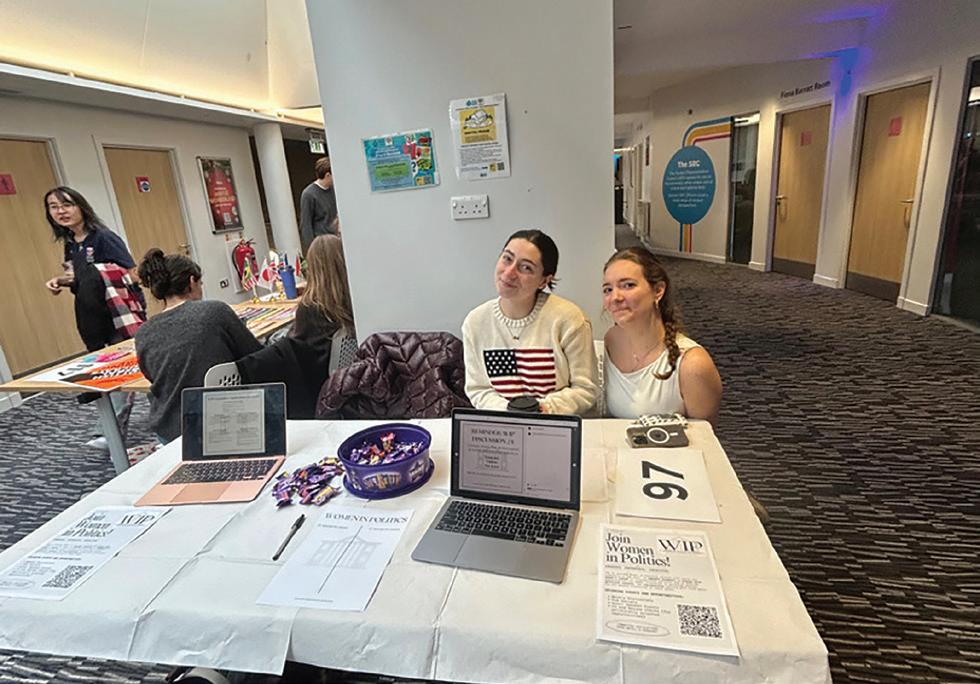
in politics. We really admired Women In Business, but we felt that there needed to be a similar space for women in politics. They [Women In Business] have hosted an event for politics, which is great, but we just felt it was so distinct that it needed its own space.”
The society has a variety of aims designed to foster a political space for not just cis-gender women, but also trans and non-binary students.
“The idea for Women In Politics is both a safe space for open forum discussion where women can get together and discuss politics, and also pre-professional development. There’s so many people in St Andrews, myself and the other two execs included, that want to get into politics professionally; and it’s difficult to get your foot in the door, particularly when you’re a member of a marginalised community.”
WIP commended the University for the aid they offer female-identifying students studying politics, specifically mentioning the strength of career services and the School of International Relations itself. However, they acknowledge that there is always more that can be done, and that is the vacuum this society is trying to fill.
When asked about general reception of the society, Pender commented, “Everyone’s been very positive, enthusiastic, and excited. What’s been said a lot — which I totally agree with — is, ‘Why did this not exist before?’”
WIP is looking forward to providing a variety of opportunities and activities for those who choose to purchase the membership.
“Right now, being a member of Women In Politics looks like attending open forum discussions every week where we discuss pre-professional development and issues that women face within politics. Two weeks ago, it was about AI and advancements in women’s health; and this week, a CV and LinkedIn workshop. We’re arranging for some members of Parliament and local councillors to come do a panel about pre-professional development and getting into politics as a woman.”
“What’s been said a lot [...] is ‘Why did this not exist before?’”
WIP hopes to continue to bring in guest speakers for members of the society, including University staff members and collaborations with other societies.
“We’re hoping to do a mixer with Pool Society soon because they want to encourage more women and non-binary people into pool, which is a very male-dominated sport. We also want to collaborate with Feminist Society and EmpowerHer; all the female-oriented societies, and we’re thinking of maybe even things that are less politically oriented. We’re aware that people may be put off by politics because that’s not everyone’s forte, so just attracting women who might not even be aware that they want to discuss things like this in an open forum,” commented Pender.
In response to the amount of committee applications received, Pender stated: “We were thrilled; we were so happy that we got such an enthusiastic response […] We’re encouraging people, even if they didn’t get it this time, to reapply next semester when there will be more spaces.”
Photo provided by Women in Politics
Plans for New Golf Resort Given Green Light
MORVEN BOYD News Writer
Plans have been approved to develop a new golf resort on the outskirts of St Andrews.
The accepted proposal from Alvarez and Marsal Golf will see an 18-hole golf course built on the Feddinch Mains site, just a few miles south of St Andrews. The plans also include a short Par 3 course, a practice range, a clubhouse, and a golfer’s hotel, as well as a restaurant, cottages, a greenkeeper’s service yard, and a halfway house.
Despite numerous attempts, the Feddinch Mains site remained
undeveloped for years before the plans from A&M Golf were approved.
A&M Golf have taken into consideration local desires, stating on their project website that they had updated their development design following “feedback received from neighbours and the local community.”
Some of these key design changes include the scaling back of the clubhouse to be “more appropriate for the setting.”
There has also been a considerable effort to ensure that the resort does not change its surrounding landscape, instead following the natural contours of the land “to seamlessly integrate the development
into the environment.” According to their website, A&M Golf are “refining the idea of structures being ‘of the land’ rather than ‘on the land’.” These new design changes “align the development more closely with its natural surroundings, delivering a project that is both visually and environmentally considerate.”
The golf resort will also benefit locals by offering numerous job opportunities. The website promises “approximately 200 full-time equivalent jobs during the construction phase and over 100 jobs once operational.” These jobs will offer opportunities to increase golf, tourism, and hospitality skills, in either seasonal or
full-time positions. Local companies have also joined the project, with Alvarez and Marsal hiring local design and development teams, as well as a local sustainability engineering firm. By collaborating with local businesses, the Alvarez and Marsal website claims that “much of the economic benefit stays within Fife and Scotland, helping to support local enterprises and create job opportunities for the community.”
A&M Golf states they are developing the project as quickly as possible, but no confirmed completion has been announced yet.
New Seaside Sauna Opens in St Andrews
SOFIA PANEK News Writer
A new relaxation and wellness establishment has officially opened its doors. The custombuilt St Andrews Seaside Sauna is situated across from East Sands beach and features a large glass window offering visitors views of the sea. The new sauna is one of several locations on the East Coast of Scotland operated by Scottish Seaside Saunas. Founder Judith Dunlop was inspired to establish Scottish Seaside Saunas due to her passion for the East Neuk’s tradition of sea swimming, which has been practised in Judith’s family for generations. Having spent her childhood swimming on the shores of St Andrews, the new location is especially nostalgic for Judith. The East Sands location was attractive to Judith for its accessibility and proximity to the Leisure
Centre and Fife Coastal Path. The sauna’s adjacency with the sea is a key component of the sauna experience for Judith, who maintains that alternating between coldwater swimming and sauna lounging provides maximum health benefits.
Judith anticipates instructing various classes in the sauna, including yoga, traditional Lithuanian leaf-whisking, and ‘Aufguss’, a multi-sensory sauna ritual involving scent, music, storytelling, and manipulation of airflow. Judith told The Saint: “There are lots of different groups that can benefit from saunas in different ways […] everyone should be able to access the physical and mental health benefits of saunas.” After three years of working with Fife Council for permission to open the sauna, Judith is excited to share the tradition and bring fellow sauna-experts from her international network to St Andrews.
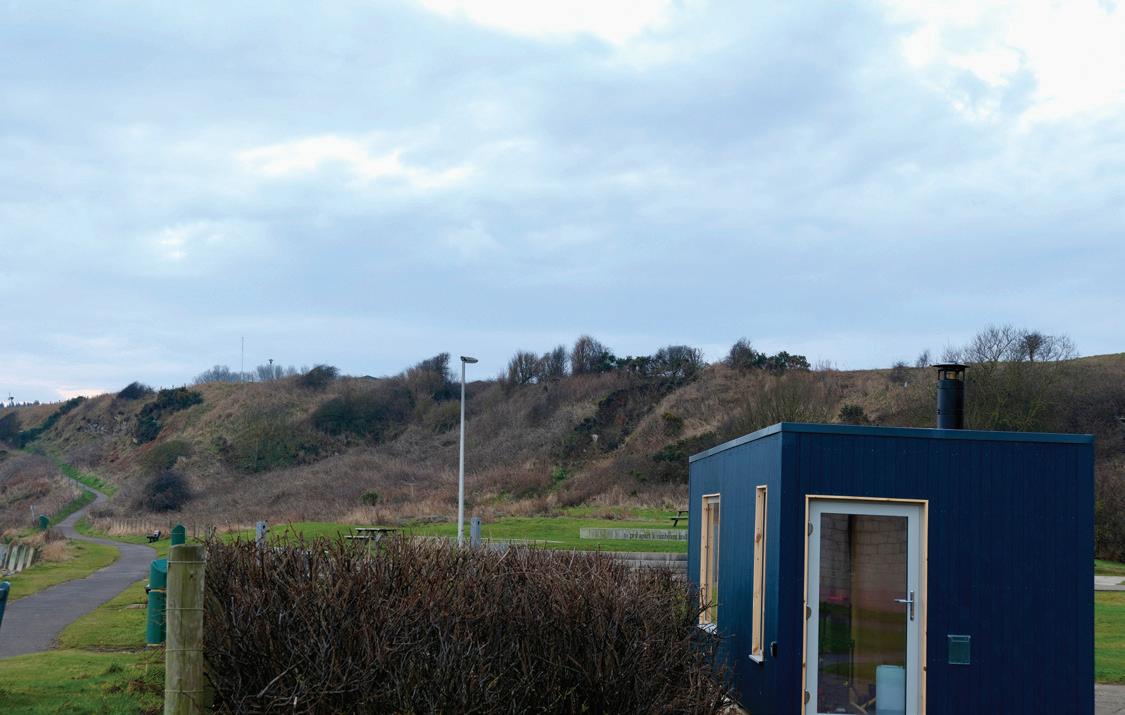
Actors Julie Wilson Nimmo and Greg Hemphill partnered with Judith to open the new sauna. The married couple’s passion for cold-water swimming was documented throughout summer 2023 in their BBC television series Jules and Greg’s Wild Swim. The series covered
Jules and Greg’s visit to the Elie Seaside Sauna, and Judith even travelled with Jules and Greg to Oslo, Norway to introduce them to traditional Scandinavian sauna culture.
In the sauna community, outdoor saunas are widely regarded as a holistic experience, featuring components of environmental appreciation, immersion in nature, and opportunity for socialisation, all centred around the focal point of health and wellbeing. The Seaside Sauna aims to create this experience by implementing environmentally-conscious technology, including a Narvi black stove, the lowestemission stove on the market. For Judith, a crucial element of saunas is the “communitybuilding” aspect. With the St Andrews Sauna able to seat sixteen visitors at a time, Judith hopes that visitors will enjoy socialising with friends and meeting new people. “Saunas build social networks,” she explained, “It’s an alternative to going to the pub.”
Outdoor saunas, commonly referred to as ‘wild saunas’, are on the rise in Scotland. Distinguished from indoor saunas typically found at spas, ‘wild’ saunas specifically intend to create an experience focused on their natural surroundings and connection to the outdoors. Many wild saunas are situated near beaches and lochs, designed to offer cold plungers the opportunity to quickly warm themselves before or after their swims. These saunas complement the active, outdoor lifestyle popular in Scottish recreational culture. Since the first of its kind opened in Scotland in 2021, over fifty wild saunas have opened across the country.
Explaining the growing popularity of
“Everyone should be able to access the physical and mental health benefits of saunas.”
wild saunas, Judith Dunlop observed that “coming out of the COVID-19 pandemic, we were all receptive to different means of taking care of ourselves.” She also acknowledged that social media has played a significant role in spurring the momentum of the ‘sauna movement’, as it has helped introduce people to the benefits of saunas. Judith explained that in her experience, saunas can present a “latent need”. She stated, “I see [saunas] as a means of changing society […] a way of empowering yourself.”
The Scottish sauna surge has been accompanied by a growing demand for wellness centres among tourists, according to a report by VisitScotland. Their research has revealed that tourists frequently choose Scotland as a destination to “get away from it all”, seeking to unwind in natural settings. With Scotland becoming an increasingly popular tourist destination, the wild sauna trend is expected to contribute to rising tourism.
Photo by Liora Berg
Business School Launches New Executive Education Courses
IONA CARRUTH News Writer
On Tuesday 11 February, the University of St Andrews Business School launched its new Executive Education courses. According to the Executive Education website, these courses will “prepare professionals to excel in a rapidly evolving business landscape.” The programme was introduced by Dr Marcel Lukas, the Director of Executive Education and Senior Lecturer in Banking and Finance, in a short video on YouTube. Dr Marcel Lukas will be joined by his colleagues from across the University in operating the Executive Education programmes. Some of the academics involved include Professor Anna Brattsröm, Dr Anna Brown, Professor Phillips O’Brien, and many more experts in this field from across the University, spanning over thirty years of experience. According to the Executive Education website, those
who are alumni of the University will enjoy a 50 per cent discount on these courses.
In a University press release published on 11 February, Professor Mark Brewer, Dean of the University of St Andrews Business School said, “Our vision is to establish the University of St Andrews as a world-leading centre for Executive Education. By combining interdisciplinary academic excellence with real-world insights, we will enable individuals and organisations to become more effective and responsible leaders in their fields.”
Short courses, consortia programmes, and custom programmes are the three different types of programmes that are going to be available to organisations interested in Executive Education at the University of St Andrews.
Short courses will last between three and four days and cover a variety of subject matter. The short courses available are:
Generative AI in Business and Finance, Leading for the Future, Investing in Net Zero for Executives, Conflict Unlocked, Sustainable Finance, The Leadership Leap, Contemporary Issues in Banking and Finance, and Value-Based Healthcare. On the Executive Education website, each course has a day-by-day breakdown detailing its content as well as for whom the course is intended. The website also outlines the benefits of the short courses as well as why organisations should choose to be educated at the University of St Andrews, citing its six centuries-long history of academic success and unique sense of identity.
Customised programmes are also available. According to the University, custom programmes are “tailored to the unique needs of the organisations [and] designed in partnership with clients to address industry specific challenges and strategic priorities.”
The Executive Education Programme
is “developed in collaboration with industry associations, businesses, and academic partners,” and consortia programmes will “focus on sectorspecific challenges and solutions”.
The Executive Education Programme will also offer different types of memberships for organisations. The three tiers of memberships are gold, silver, and bronze. Those who opt for the gold membership will have 22 places on any of the short courses, save fifteen per cent on standard design and delivery fees on customised programmes, alongside six complimentary places at executive education events.
The University stated, “Executive Education participants will benefit from a distinctive blend of rigorous research-led teaching, collaborative peer engagement, and immersive experiences that foster leadership, strategic thinking, and impact.”
InFocus
Rod,
Clova,
and Mia
Rod Stoddart on how he and his two dogs, Clova and Mia, serve students and locals in St Andrews and beyond
PARIE DESAI News Writer
“It’s about bringing people together. It’s about reducing isolation and stress,” said Rod Stoddart when asked to describe his work alongside his two therapy and search & rescue dogs, Clova and Mia.
Stoddart’s journey can be traced back to when he joined the Royal Air Force aged only sixteen, before moving on to work for the Ministry of Defense. In an interview with The Saint, he described that his interest in working with dogs did not stem from his childhood, but rather a day in 1977 when a search dog handler showed him the ropes whilst out in the mountains. Since then, his desire to learn more only accelerated, and in 1980 he got his first dog to train for the Search & Rescue Dog Association (Scotland). 48 years on from this initial spark of interest, Stoddart is now part of Specialist Search Dogs, a charitable organisation offering 24-hour call-out support for missing person scenarios, through means of search dogs.
As a volunteer, Stoddart works tirelessly with his two dogs Clova (aged eleven) and Mia (aged ten) to carry out this work. Clova has spent her whole life with Stoddart, whereas Mia was rescued by him at the age of two. Both have the unique trait of having been trained as both therapy and search & rescue dogs. Stoddart shared the very special relationship he has with both of them: “We’re very, very close, [...] we’ve got a good rapport, [...] a very, very close bond which you expect to have.”
The trio provide therapy, and have proved themselves integral to the St Andrews community since they started ten years ago. Often at the most critical of times, they provide support to students and locals both within St Andrews and beyond. Stoddart emphasises that, above all, he could relate to the uncertainties and stresses that university
“I realised that therapy dogs were the way forward in reducing stress.”
life could bring to students, sharing that he felt the same when starting with the RAF: “People coming from home for the first time […] making new friends, a strange area to live in [...] all that can be stressful and I realised that therapy dogs were the way forward in reducing stress.” One example is that Clova can sense when individuals have PTSD, autism, or are experiencing general stress. She goes up to people, “licking the backs of their hands [...] and by her action, [she changes] the endorphins under the skin layers and reduc[es] that stress.”
When asked
elderly, those who are suffering illnesses.”
By moving away from the student community, Stoddart describes that much of their day-to-day work is centred around working with the elderly in care homes. Amongst many examples, Stoddart outlines the vital role Clova has played over the years in waking up people with dementia.


He also highlights the
“[Clova and Mia] also know what to do, as they’re experienced enough now.”
Given the nature of the job, especially the callouts, Stoddart explains: “We rest when we can [...] some of the days can be 14 hours.” Similarly, he expressed that the hours vary each day, but, “That’s been my life since 1977, so I’m quite used to it now.”

with the town, the local community; [...] it’s associated with everybody that needs help, so I’m all over the place.” The rich diversity and breadth of their work allow the three of them to work with people of all ages and walks of life. Stoddart continued, “[his] dogs go in amongst every different type of person that there is: the young, the
vulnerable people, such as keeping the dogs “at certain levels so they don’t injure the residents”. Moreover, he expresses that the obedience of dogs working in such an environment must be quite high as they are not allowed food in these places. To tie this all together, Stoddart reflected on the unique and very special relationship that he shares with both Clova and Mia, saying, “If you get a good bond with the dog, as I have with both of them, then they will do exactly as I want, but they also know what to do, as they’re experienced enough now.”
Stoddart has been recognised with several honours for his relentless voluntary dedication to serving the community and going the extra mile. Within the military, he received the Chief Constable’s Commendation and went on to receive a similar award within Fife. Most notably, in July 2010, he was presented with an MBE at the Palace of Holyroodhouse for his services to mountain rescue and search & rescue within Tayside. Recently, to thank him for the work he did during the COVID-19 pandemic — including helping the elderly with their shopping, medical runs, and taking their dogs for a walk — Stoddart received commendations from the local council. Likewise, in June 2022, the Students Association awarded an honorary field membership to Clova for her work in enhancing the student experience. The award was all the more prestigious given she was the first dog to ever receive it. In response to this, Stoddart described feeling “very proud of that [...] and she’s got the certificate and the folder that you guys get on graduation [...] so that’s amazing.” Looking to the future, describing that he will be reaching his milestone 70th birthday in May, Stoddart hopes to continue his work with Clova and Mia for as long as he possibly can. The story of Rod Stoddart, Clova, and Mia portrays the sheer power that volunteering and small acts of kindness have in uplifting a community through difficult times.
Photos Provided by Rod Stoddart

Viewpoint
EDITOR: GEORGES TOULOUSE
Hereditary Success
Nepotism, internships, and the myth of merit
STELLA PAK-GUÉNETTE Viewpoint Writer
The line between networking and nepotism is becoming thinner than we would all like to admit. As I figured out my plans for this summer, I realised that opportunities often hinge more on ‘who you know’ than what you bring to the table. Networking and nepotism are almost indistinguishable when connections are passed down like family heirlooms, and in industries where competition is fierce, access is often the real currency.
For those who don’t benefit from convenient connections, the likelihood of getting an internship is somewhat bleak. It depends entirely on a packed one-page CV, a painfully over-optimised LinkedIn profile (complete with a ‘#OpentoWork’ banner and a bio desperately trying to make “passionate about finance” sound original), and the ability to make an impression over Zoom, if they’re lucky enough to impress the automated screening system. At what point does ‘networking’ shift from being about initiative and start being about inherited advantage?
The best-case scenario? Having parents already in the industry you’re trying to break into. For those following in their parents’ footsteps, there’s an endless list of connections and names to know through them. Summer after summer, you can lean into what’s available to you and break into a competitive industry almost with ease. And by the time fourth year rolls around, you have opportunities lined up for you. Yet, this sort of nepotism doesn’t usually announce itself as such. Instead, it’s often brushed off as simply making the most of your resources, as if
everyone’s resources are identical.
I can’t count how many times I’ve been told that networking is an essential skill, something anyone can develop with enough effort. But how much of this networking is really about skill, and how much is simply about being born with an invitation?
Nepotism in hiring is no new phenomenon. It has shaped industries for centuries. In finance, family legacy hiring is so ingrained that some of the biggest banks, like Goldman Sachs and Morgan Stanley, have had formal “referral programmes” for employees’ children. These programmes gave applicants a built-in leg up, adding the credibility boost that comes from having an insider vouch for you. With that endorsement, your application basically skips the line. Some industries are more blatant about this than others. Fashion, politics, entertainment — these are fields where networking isn’t just helpful, it’s practically required. To call internships in these fields competitive

comes with an unshakeable label: nepo baby. Lily-Rose Depp, whose family tree is practically littered with Golden Globes, has had to address it time and time again. Sure, she had industry connections — agents, directors, and actors who already knew her — but attributing her entire career to nepotism overlooks her own artistry. The public expects nepo babies to acknowledge their privilege, to prove they truly ‘deserve’ their careers. In other industries, the conversation is quieter but the pattern isn’t all that different. No matter the industry, a well-placed last name often translates to early opportunities — only in finance, it’s framed as a ‘referral’ rather than an inherited advantage. The reality is the same: talent still matters, but having the right ties is what first opens the door. The uncomfortable truth is that I’m a part of the problem. This summer, I’ll be interning at a private equity firm in Toronto. On paper, I went through the standard hiring process — submitted my CV, completed a series of interviews, and showed my interest in the field. But the truth is, I got the opportunity because my dad’s friend is in charge of the company. It’s clearly not a success story based on an overwhelming amount of experience, and I won’t pretend otherwise. That connection got my foot in the door, and without it, my application would have likely been just another one in the pile, leading to an inevitable rejection. I didn’t just witness nepotism at work — I directly benefited from it. It’s uncomfortable to admit you’ve played right into something you’re criticising. It’s easy to call out the unfairness of it all, but when the opportunity landed in front of me, I didn’t turn it down. And why would I? We all want to believe our success is earned, that our achievements are our doing. But when doors open for us that remain shut for others, it’s worth asking: if given the same advantage, would anyone really say no?
While I still had to put in the effort, I know that without that personal connection, I wouldn’t have been considered. As a first year with minimal experience in
finance, I had assumed I’d have to work my way up through unanswered applications, rejections, and maybe another summer at my camp job. But this process forced me to see how different the playing field really is. Summer internships in competitive industries don’t go to the “best” candidates. They go to the ones who are in the right circles.
“Summer internships [...] don’t go to the ‘best’ candidates. They go for the ones in the right circles.”
When someone lands an internship at a top firm because of a ‘family friend’, they’re not necessarily more qualified — they were just already on their radar. Meanwhile, others are left sending out applications in bulk, receiving rejection upon rejection, and hoping that sheer persistence will compensate for their lack of an inside introduction. For students without built-in connections, the cold email pipeline is a repetitive and often demoralising process. It’s an engrained routine: tailoring cover letters, attaching resumes, and sending messages into the large, dark void of some HR department, hoping for a response. Even if you do everything ‘right’ — researching the company, crafting the perfect email, following up strategically — your message is probably sitting unread in someone’s inbox while the CEO’s niece is already picking out business-casual outfits for her first day.
So, is networking just nepotism with better branding? In many ways, yes. Everything still depends on access, which is never distributed equally. Merit alone isn’t always enough, and as frustrating as that is, it’s key to recognise the systems at play rather than internalising every rejection as a personal failure. I think meritocracy has always been more of a comforting myth than a reality. And if networking is just nepotism with extra steps, then success isn’t just about what you bring to the table, but whether you were invited to the dinner in the first place.
Illustration
by Magdalena Yiacoumi
Devil’s Advocate
Is it possible to balance academics, extracurriculars, and social life adequately? NO 45%

Overwhelmed is an understatement to describe how I felt as a first-year student with all the opportunities that were presented to me. This feeling came not only from the sense of excessive choice but also from the fear that I would make the wrong decisions or not do enough. FOMO is universal and intensified during our stage of life. , and things like the Freshers’ Fayre, one of our first interactions with university life, only breed it.
At university, academics are, of course, vital — this degree, in many ways, is your gateway to the world, to your career, to your skills, and to developing your academic and practical mind. Extracurriculars are also important — and not just as a means to bolster your CV. They’re often where you make friends and meet like-minded people. They allow you to pursue your interests, develop your skills, and do what you enjoy.
As time passes and you grow into your university experience, routines are set, passions are identified, and self-images are created and then recreated over and over again. Constantly feeling like we’re failing at maintaining that balance makes it that much harder. I’ve felt this, and I’m sure you have too.
So, I’d like to propose a new way of looking at it. Balance is a fluid concept; it doesn’t have to mean that you divide and slice your days up like a pie, committing yourself to scheduling a bit of everything into each day. ‘Balancing’ all three is pretty much impossible to sustain in the long term. Say you have a couple of deadlines all concentrated in the next few weeks. Devoting more time to your academics during those few weeks is likely the most effective and productive use of your time. Devoting less time, but still some, to the gym, for example — enough that your academics remain your focus, but you can still get that quick workout in to clear your mind — is the kind of intentional balance you need when working toward that particular goal. If you take a quick break from pretending you have it all figured out, a 20-minute break to further compromise your attention span on Instagram Reels,
and a subsequent 20 minutes’ pause for the stress-induced mental breakdown (you know, to get it out of your system), are perfectly legitimate ways to fill out a day.
When you’re finally over the deadline hump, go out! Free time should be spent on recreation, and I believe this to be absolutely essential to a healthy mind (which I definitely have). When there is mental space and time to do so, dedicating time to your friends and nurturing the relationships you hold close is completely important. Even when operating within a heavy schedule of extracurri-culars, such as society committee respon-sibilities, taking out an hour from your busy day for a coffee and a gossip with a mate may just inject that bit of energy you need to finish that reading or tutorial sheet.

Understanding that balance must take shifting priorities into account is key. Let’s be honest, no one expects you to get blackout drunk at Sinners and ace the class test the following Thursday, all while having your laundry folded and meal prep ready in the fridge. It can look a bit more like this: Thursday morning is reserved for the hangover, and the rest of the day is for laundry and cooking. The next day is focused on studying, with a lunch break to catch up with a friend. At times when there is no time for the hangover, maybe a civilised movie night with friends instead!

The Classical Greeks imagined a divine triad of Zeus, Athena, and Apollo. Post-classical university students have first-class grades, society AGMs, and dinner parties on the brain. And without offending any Greek pagans, I’m here to say both sets are noble fictions. Useful to work towards, the university trinity hovers too far above us to reach, and we would do well to realize our lives are often better off slightly unbalanced. The conflict between our various social and professional obligations is a good problem to have as First-World academics, but it nonetheless taxes the mind, body, and Google calendar. The problem is further complicated by social media and the heresiarchs associated with it, who push ridiculous ideas like waking up early and skipping pub nights in order to do more stuff. This efficiency rhetoric dominates our culture and pervades the way we think about our obligations as St Andreans. In order to be a hardworking student with and internship and a LinkedIn to post to show for it, we think we have to sacrifice our time in professional societies and late-night library hours. Or, we ought to prioritise ‘networking’ by consuming more than temperate quantities of ale (or worse, lager)!
The irony of pursuing the unholy trinity is that we lose ourselves to one in
the name of all of them. If one is satisfied with extracurriculars and social life, but not hitting firsts, there is a genuine danger of pursuing 19s to the detriment of our other obligations. The same is true of the other branches of the triad. Our insecurities with regard to our shortcomings, especially in comparison with the haloed tripartite student, can induce an obsession with the piece we lack. Such an obsession can make us feel like the time we spend on other aspects of our life — creativity, social life, societies that won’t go on the CV — is wasted, or at least not useful. Because we want to be perfectly well-rounded, we often distort our lives into asymmetry.
The truth, as the Greeks knew so well, is in moderation between extremes. Moderation between vices comprised virtue, and a virtuous life was one welllived. In this case, moderation is healthy ambition, located somewhere between laziness and unhealthy obsession. We ought to have an idea of our perfect threefold balance and work towards it piece by piece, while avoiding the mistake of assuming we must absolutely embody it.
The contemporary philosopher Oliver Burkeman, for many years an efficiency guru, writes about the paradox of wellroundedness. We might have a list of things we want to accomplish in life, he argues, but approaching them all at the same time will never result in attaining any of them. Instead, we ought to prioritise just two or three, dropping all the rest and recovering them only when we feel we have accomplished what really matters. After all, when we only have eight semesters here, knowing what exactly we want to do is paramount.
The way to balance the things we prize, be they grades, societies, or a pint of Landlord with the lads, is to recognise that they cannot be perfectly balanced. Student life is irregular and unorganised, and the sooner we mortals realise we can’t match the gods, the happier we’ll be.
Illustration by Aimee Robins
The opinions expressed in this publication are those of the authors. They do not purport to reflect the opinions or views of The Saint.
Down With the Fl-YOU! The ethics of infection
SAM SPENDLOVE Viewpoint Writer
For whatever reason, it’s only been over the course of these recent months that I’ve become able to appreciate how much of a cesspool this town really is. People cough in my face as I walk by. They cough in lectures. They cough in indistinct, mysterious rooms somewhere in the building I’m in — and against all odds I can still hear them. They cough so hard that my friends look at each other and whisper about whether or not we should go back to check on them. If someone isn’t coughing, it seems they are fated to eventually begin, as they make the mistake of going somewhere, anywhere, and then they’re coughing. We’re all sick; St Andreans are single-handedly abating the evolutionary concerns of whatever little bug has taken us all down — this germ is the fittest and it is definitely surviving.
Perhaps my sudden understanding of this town’s extraordinary microbial concentration has come from the fact that, this season, I was one of the infected. I was taken out. Assassinated by a truly lethal combination of mundane and inconvenient symptoms. On the leaderboards of all the colds I’ve had, this one has earned, at the very least, second place. And it’s off the back of this terrible, horrible, triumphant cold that I began to ask a question: who the f**k got me sick? Does it even matter? Would I blame them if I knew? I mean, I’ve been in their infectious shoes before. Recently I was walking with a friend who had a newly-arrived sore throat. I had just been to her birthday dinner the weekend before, still coughing away. It dawned on me that even though I was confident I wasn’t infectious anymore, she could’ve picked up the sore throat from me. “Oh no, it probably wasn’t you,” she said when I told her, “it doesn’t matter.”
to remove blame from the equation entirely. I’m not in the habit of scaling the buildings on Market Street, posturing to assassinate the pedestrian who decided to launch a drive-by cough into my face. It’s when it’s a bit unclear whether or not they even cared about the possibility of infecting me that things get complicated.
Sometimes, people I’m around — in close proximity, for dangerous amounts of time — will casually and guiltlessly mention a sore throat that just won’t quit them, or the cold
sitting two or three seats away from me?
Then, when you see them again, now fully ravaged by the gift they gave you, things get awkward. If you can remember the time they chose to expose you, then the continuity between action and consequence is too strong to remove blame entirely. You can clearly remember them coming to the pub with a fever that you now have — how can that not matter?
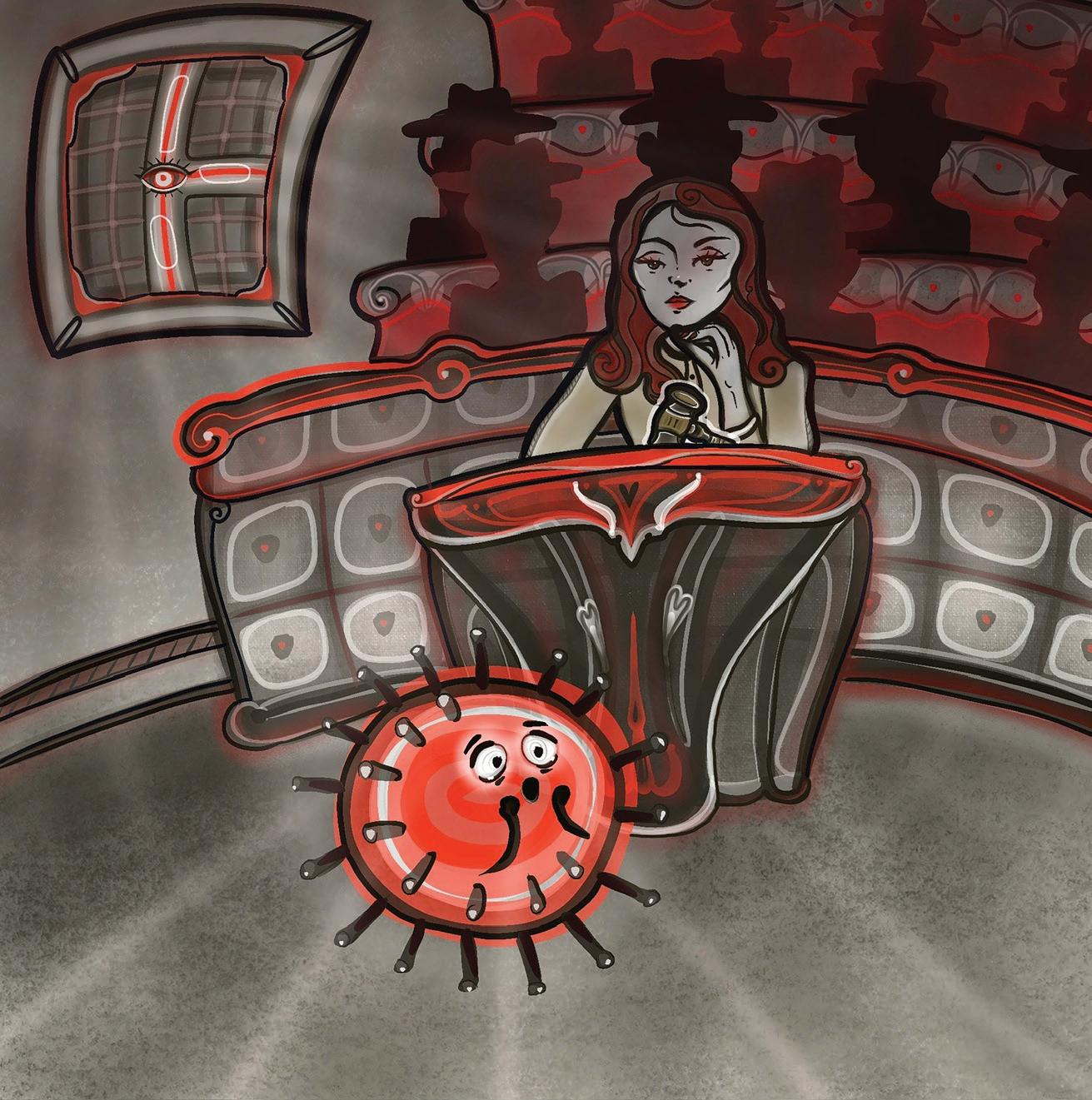
Serial Griever
by Natasha Currie, with Isabella Checkley
I can still hear the rhythmic ticking of his bicycles’ wheels, as he passed by the kitchen window.
I can still hear the obnoxious beeping of the smoke alarm, a Sunday morning ritual letting us know that breakfast was ready.
Whether or not I’d be as forgiving requires an examination of the problem. If somebody accidentally infects me with a cold, then it seems reasonable
they woke up with that morning. Everyone else around me smiles sympathetically and nods, cooing and commiserating. Not me. I’m seething, wide-eyed, in the corner. At the risk of seeming fundamentalist: what are you doing here? Leave! When did the comparatively low impact of certain illnesses make them appropriate to pass around? Suddenly I feel like it’s more my responsibility to accept the possibility of infection than it is theirs to try and avoid it. It becomes a game of maintaining nonchalant stoicism in the face of a threat: it feels weak, almost bourgeois, to be afraid of catching a cold. Sure, the optics of me suddenly getting up and leaving aren’t great. But, how is that where the wrongdoing lies? Is my sympathy meant to somehow override the very real possibility that in three to four days I’ll wake up with a cold my friend could’ve easily prevented just by
But then, I don’t really think about this all that often. At worst, a little flare-up of annoyance strikes me if I can somehow deduce that someone got me sick — but then I forget it. Probably because, with a bad enough cold, you stop caring about everybody else. Life revolves around when you can next reach your bed, how long you figure you have to sleep before symptoms improve, and what will actually happen if you take a dosage of paracetamol an hour or two earlier (no one can tell me). Hence the vicious cycle starts to take shape: when you’re the sick one, all that due ethical course doesn’t feel as essential as when you’re the one being exposed to illness. You just don’t have the energy for it — most of your time is spent just trying to negotiate all the pill-popping, soupsipping, and desperate convalescence.
I could split hairs forever in regards to what one should and shouldn’t do while sick — but sick people have to be able to go outside, even if they’re hacking up a lung. Having conducted a tiny focus group, I think my friend Eleanor put it best: “If you had to stay inside at uni every time you had a cough, you’d never go outside.”
So we’ll probably continue to be victims of other people’s microbes, and we’ll probably continue victimising others with our own. This town is an amusement park for the common germ, who will forever delight in hopping from host to host. My sore-throated friend was probably right: we’re better off just continually forgiving each other, and then waking up with a 40°C fever the next day.
Illustration by Isabelle Holloway
I can still hear the faint creaking of the garage door at night, as he stealthily returned his bike after work so as not to wake us.
I can still hear the gentle hum of Radio 5, his whistling accompaniment to Billy Bragg, Lily Allen, or George Ezra.
I can still hear the ‘punctured bicycle on a hillside’ of The Smiths’ ‘This Charming Man’.
I can still hear the sound of his flip-flops on the tiles — oh, how they flipped and they flopped!
I can still hear his laugh whenever I laugh, still hear his voice whenever I speak. I can still hear him everywhere.
I can still hear the sound of her car pulling into the pebbles on our driveway.
I can still hear the kettle beside her bed, which woke us up most mornings with the shrill crackling of boiling water.
I can still hear the yoga mat unfurling in the next room.
I can still hear the slight loving concern in her voice whenever I suggested making dinner.
I can still hear the gentle beat of a wooden rocking chair outside in mid-July when Scotland finally gets some sun.
I can still hear her telling me to wear a little sparkle, it just needs a little something!
I can still hear her cheering when I do something good, or something she would be proud of.
I can still hear her everywhere.
‘The term soundmark is derived from landmark and refers to a community sound which is unique or possesses qualities which make it specially regarded or noticed by the people in that community. Once a soundmark has been identified, it deserves to be protected, for soundmarks make the acoustic life of the community unique.” Murray R. Schafer
To read about the initative behind this week’s column, go online to www.thesaint.scot and search for Serial Griever.
It’s Murder on the Dancefloor!
POPPIENA HORSINGTON Viewpoint Writer
Everyone has their complaints about St Andrews nightlife — it’s underwhelming to say the least. At a certain point we all must accept a part of the blame. Yet, I shall not be accepting blame, but rather placing it. Placing it on a demographic that I think gets away with too much on nights out. That is the rowdy lads lads lads. And this is not a proclamation against all men attending the 601 — however, if you read this article, chortle along and think to yourself, “He did nothing wrong — Free my boy!”, then, I hate to tell you this, but you are the problem. The concept of a group of loud, boisterous, intoxicated men is no stranger to a night out. Their financial contributions have certainly saved many a small pub from going out of business, and their sense of community and camaraderie is mildly impressive. However, operating in the confines of 601 is not akin to the quaint pub, where it’s enough to stand and soak in the atmosphere. The crowd is not static, it’s huddled together in clusters of small groups of people, dancing. If you’re not dancing, your beanstalk body becomes a bollard. There are very few who possess the stature to go against these giants, BFG or Goliath. Thus, it is imperative that
these lads use their height for good. Why are you pushing against anyone shorter than you? You already know you’re going to win, your derrière awkwardly pushing against their back, making both of you unnecessarily uncomfortable. Don’t just stand there, my pal, looking disgruntled, make space! It is a near talent how these bored-looking boys end up in the middle of the crowd when they don’t
your streaks? Missing your nightly chat with MyAI? If the event is not fun, I implore you to leave. It’s torturing both of us –– you looking disappointedly around the venue, and me watching your unamused glances, as I bump into you repeatedly because some insanely long chain of people are rushing to find a friend they left behind twenty minutes ago. Furthermore, in the excitement of going
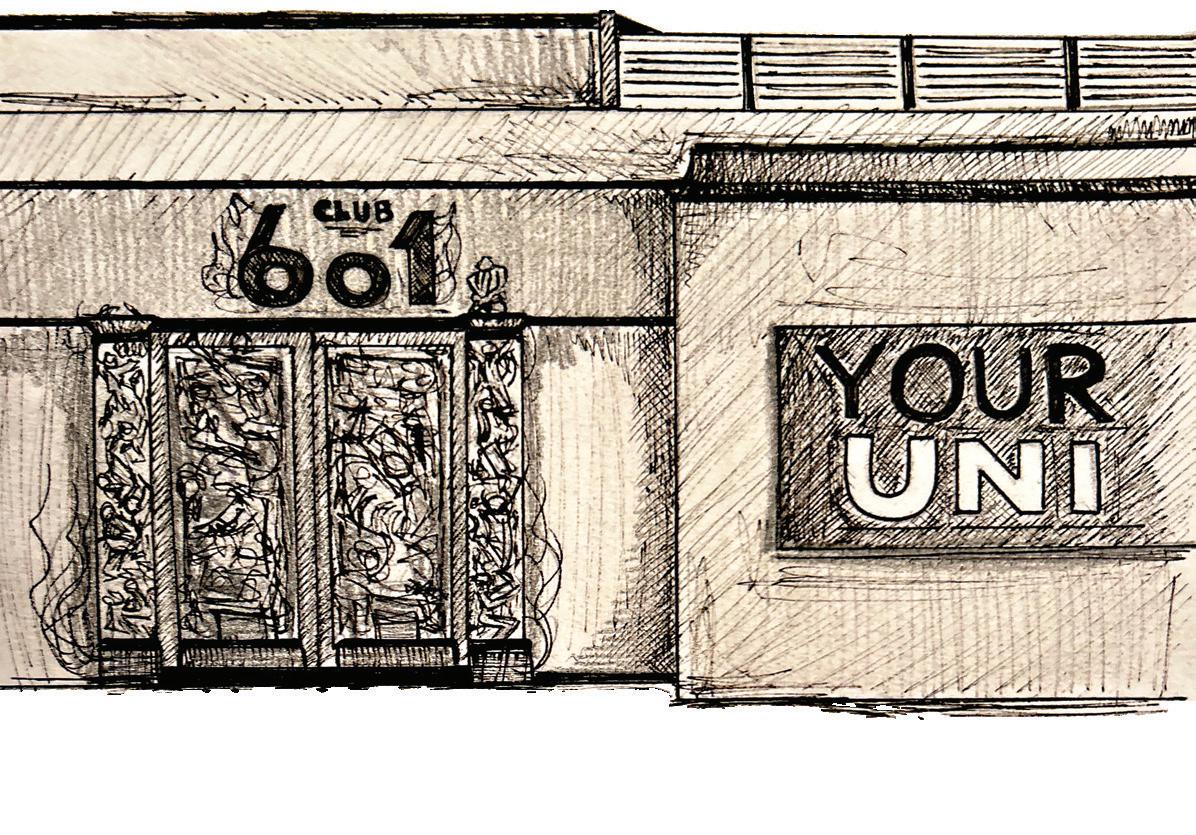
move at all, checking their phones every now and then. Adding to this point, the club is no place to reply to your daily correspondence. Under no circumstance should I turn my head while dancing and see that I’m featured in the background of some random man’s Snapchat. Are you worried you’re going to lose
drinking and the getting ready of it all, I ask that we do not miss one vital step: deodorant. The miasma of foul stench wafting ahead of your arrival is not the first impression you want to make. Everyone sweats inside the packed venue, but I fear that some of these lads
are showing up pre-stinky — a stink that’s built into the outfit somehow. I don’t want my Bop to smell like a middle school disco, and I know I’m not alone in this. Many other party-goers are nostril-level with your putrid pits and the crowd pushes them toward the source of your mysterious odour. Let’s avoid this embarrassing encounter by putting some front-line defence down. I am speaking from a place of party concern. If all groups cannot learn to coexist harmoniously on the dance floor, there will never be peace in 601. This opinion has been steadily brewing in my mind every time I go out to the Union and have a weird interaction with a devious partygoer. As I stood in 601 on ABBA night, being pushed around by much larger entities than myself while those authentically Swedish performers gave it their all, it hit me! Literally. Someone propelled their empty cup at my head, I assume with the intention of it landing at the bar. From this act, it became clear to me that something about the dimness of the room, the blast of the bass, and the cramp of the crowd incites something in these partygoers where all understanding of etiquette or decorum goes out the window. Ultimately, everyone is entitled to having a fun night out… but not at the expense of other people’s comfort, sense of smell, and safety.
by Magdalena Yiacoumi
Free Speech For Me, Not Thee
AGATA MALA Viewpoint Writer
Free speech is one of those ideas that virtually everyone claims to support. In theory, it is an almost sacred principle. In democratic societies, it is a hill that both the left and right pretend they are willing to die on. But in reality? No one actually wants free speech — not in its purest, most uncomfortable form. Supporting free speech has become the intellectual equivalent of saying “I recycle”, and yet it is treated in a manner comparable to tossing your takeaway container into the general waste bin. Just like people claim to love the environment until it means giving up their third overseas holiday of the year, people claim to love free speech until it means tolerating views they find repulsive. Then, suddenly, it’s “nuanced”. It’s a contradiction so blatant, yet so widely present, that it has become the status quo. If free speech were truly a universal value, everyone would be consistent in their defense of it. Instead, both ends of the political spectrum betray their own principles whenever it suits them. Rightwingers rage against so-called ‘cancel culture’ and claim that political correctness
is stifling open debate. Yet, they are often the first to advocate laws that limit the right to protests, the banning of books in schools, the shutting down of drag performances, or the exclusion of discussions on race and gender from classrooms.
On the left, the hypocrisy is just as glaring. Progressives champion open expression when it comes to radical ideas about social justice, yet they advocate for deplatforming speakers they label as bigots or reactionaries. Universities — supposedly bastions of free thought — have seen countless incidents where speakers are shouted down or disinvited because their views are deemed unacceptable. But who gets to decide that? And if hate speech is defined by the listener’s perception rather than objective criteria, then doesn’t speech cease to be free altogether?
One of the main issues with free speech is that no one seems to agree on what it actually means — people define it in several different ways. For instance, legal free speech that speech should only be legally restricted when it directly incites violence or breaks the law. However, determining what qualifies as incitement or a legal violation is often challenging. Consequentialist Free Speech holds that speech should be allowed
as long as it does not lead to real-world harm. The difficulty with this perspective lies in deciding what constitutes harm and who gets to make that determination. Platformed Free Speech is the belief that free speech includes not just the right to speak but also the right to be heard. According to this view, public institutions should provide platforms for controversial voices rather than excluding them. Absolute Free Speech argues that all speech, regardless of how offensive or inflammatory, should be protected, including hate speech.Each of these definitions serves a different agenda, which is why debates over free speech so often descend into chaos. The discussion is not just about what should be allowed but also about who holds the power to define the boundaries of acceptable discourse. Another hindrance to free speech debates is that a lot of people seem to confuse it with the idea that all opinions deserve equal respect, as though critical discussion is somehow oppressive. The phrase “respect everyone’s opinion” is plastered all over activist social media pages — a thought so shallow it hurts. Personally, I will always respect your right to voice an opinion, yet I will defend my right to call it f**king idiotic
equally vociferously. Why? Because there is a major difference between — reluctantly, for the greater good — supporting someone’s right to express, say, a blatantly false view (“Vaccines are a mere conspiracy led by Bill Gates to implant microchips in people!”) and supporting the view itself. Opinions are not immutable characteristics like race or gender, so we should have no moral qualms about challenging them. And if, perchance, that offends you, I refer you to my earlier point… The truth is, most people don’t want free speech — they want speech that aligns with their worldview while silencing dissent under the guise of protecting society. If we were all honest about this, perhaps the debate would become less hypocritical and more constructive. Instead of pretending to champion free speech, we should acknowledge our biases and grapple with the difficult question: how do we balance open discourse with the need for a functional, respectful society?
Until then, the next time someone proclaims their unwavering support for free speech, ask them: “For everyone, or just for the people who share the same core values as you?” Chances are, they won’t have a very good answer.
The opinions expressed in this publication are those of the authors. They do not purport to reflect the opinions or views of The Saint.
Illustration
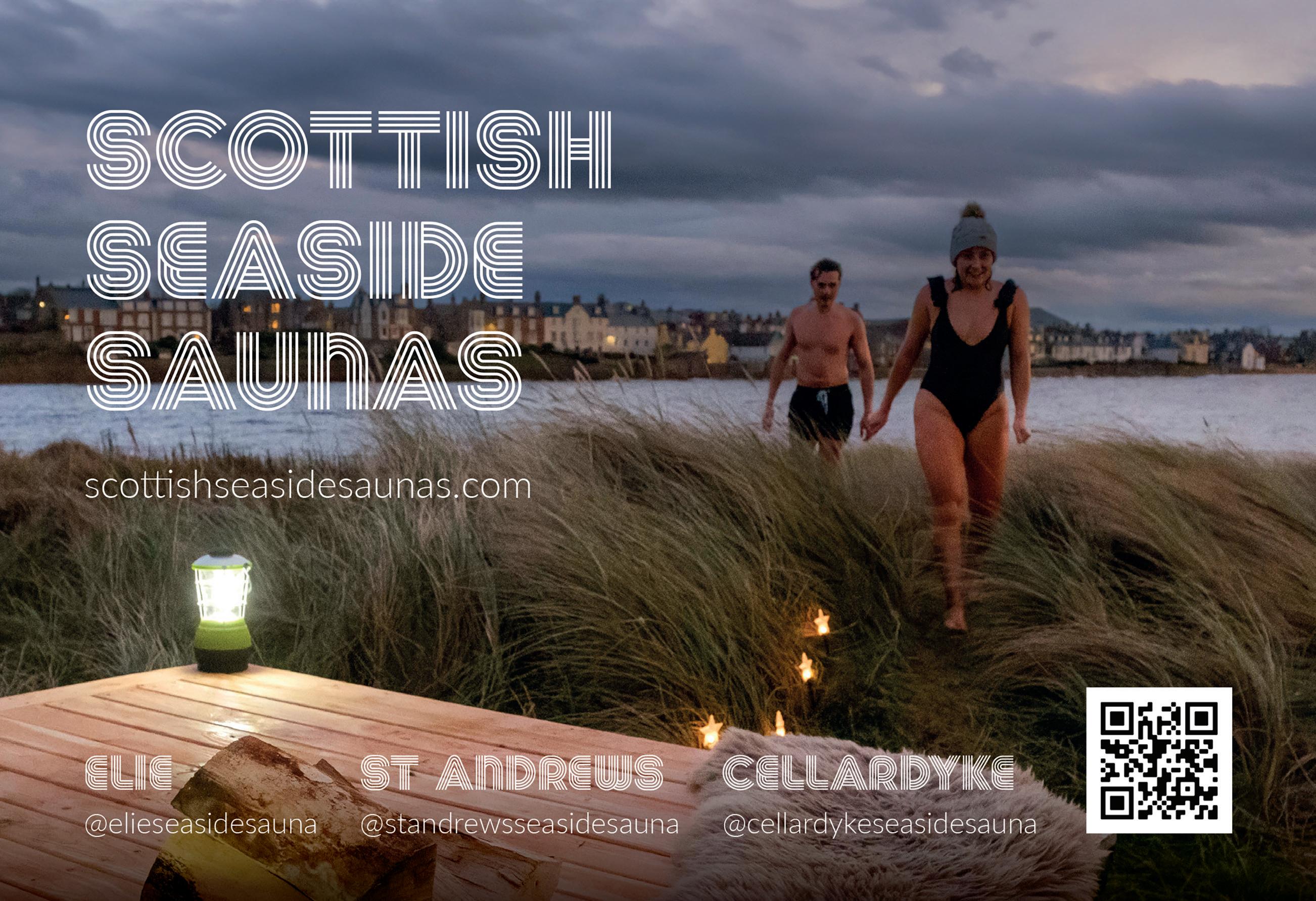
Vive le Québec Libre?
AVERY COHEN Viewpoint Writer
Following the mania provoked by US President Donald Trump around a potential annexation of Canada, veteran French polemicist, Jean-Luc Mélenchon, recently posted to X: “10 February 1763, the anniversary of the calamitous surrender of Quebec to the English. If Trump annexes Canada, that cannot include Quebec. Obviously.” The message here is unclear: is Mélenchon heralding a future in which Québec finally becomes free, or French? It could well be that three-time presidential failure Mélenchon is projecting a reality in which a possible 2026 secession-turnedFrench colony of a left-leaning Quebec happens just in time to get his party the votes to win the 2027 French presidential election. Though it’s been 30 years since the last sovereignty referendum, debates on the topic — especially among the young — remain as pertinent as ever. A quick glance at voting polls at the last federal election shows that 32 per cent of Quebecers voted for the sovereignist Bloc Québécois, only one percentage point less than the victorious Liberal Party. Surprisingly, though doubtless the result of some Ottawa-sponsored censorship, national polls haven’t yet considered the question of joining France, and official statistics regarding its popularity aren’t
available. Regardless, I have a sneaking suspicion that such a hope does, in fact, lie at the fact of the sovereignist movement, and it’s time we consider it as the viable option it is. After all, we share a common heritage, speak the same language (kind of) — why should an ocean get in the way of what is one nation? If the Québecers insist on calling themselves ‘French’, let them be French
But, what would a French Quebec even look like today? If we’ve learned anything from French political discourse in recent years, it’s that the word of the hour is integration. Diversity isn’t a term that’s made its way into the French language quite yet, and a quick look at history books suggests that one more overseas “territory” likely won’t change that. So here is the most likely course of events, in my view, inexorably leading Quebec into joining France.
As Trump withdraws from the Paris Agreement (again), millions cheer, gathering throughout the country to celebrate the policy with a fossil-fuelburning sacrifice. As methane ascends to the Heavens, a warm, grey cloud looms over Canada, piercing through the ozone layer. The home of snowmen and ice rinks quickly melts under an overcast skyline, transforming it into the murky continental
of Northern France we all cherish. With a little luck, the excess pollution might slip into the Québécois’ breathing patterns,

damage to their vocal cords to make them intelligible to their continental cousins, while giving them the signature raspy French voice. With the end of the limitless USMCA potato supply, following the latest battery of American tariffs, the greatly feared poutine famine would strike, forcing a muchneeded culinary redirection of Quebec towards wine, cheese, and hunger-stifling tobacco smoking. Who does the barren land now have to turn to for inspiration and trade, but their estranged brothers on the European continent? The remaining points in need of rectifying are much less contentious: why have maple syrup if you can have butter, hockey isn’t real anyway, etc. Hopefully, all these adjustments will harden them up, causing them to garner just enough bitterness, disdain, and feelings of superiority for them to truly become French. Modesty compels me to consider that, perhaps, my infallible instincts are wrong and the sovereignist movement actually wants sovereignty. In that case, I would happily support any efforts towards an extraction from the Anglosphere. My poor cousins, you are in our thoughts and prayers.
Illustration by Piper Dooley
climate
Screw the Luxury Hotel!
ALEX BARNARD Relic Writer
It’s tough but true: travel requires a degree of financial sacrifice if you want to get further than the local caravan park. As a teenager, I saved up money determinedly, never quite able to afford that European holiday of my dreams. Then, at the cusp of adulthood, the internet made me an offer I couldn’t refuse. Interrailing offered practically infinite travel around Europe for the usual price of one flight and a nice hotel. So, fresh-faced after my A-Levels, I set off with my friends for a real-life comingof-age movie across Southern Europe before getting back on the academia train. With this trip, I discovered the joys of living thriftily. Sleeping in a room with strangers became thrilling. Craving lunch out? Nothing a quick stop at Carrefour or Rewe for a baguette and cheese couldn’t satiate. In Paris, I snacked on apricots gifted by a flirtatious market seller; in Venice, I drank one euro espressos by the canals. Ludicrously low prices for alcohol in German supermarkets set the backdrop for many lakeside afternoons reading terrible books procured at the airport. My most authentic experiences abroad have been the cheapest.
SkyScanner, offering a treasure trove of cheap flights, has brought me to such random destinations as Zadar, Croatia, on account of ridiculously low prices. Only boasting one page of flights per day on its departures board, this town with impressive Roman ruins, casually surrounded by the bustle of people shopping and drinking in its square, lies largely undiscovered by tourists. What’s more, Alfred Hitchcock once said Zadar has the most beautiful sunset in the world, which I was lucky enough to witness for free.
Hostels are a particular highlight of the cheap travel experience. There’s inevitably going to be the weird roommate who sleeps all day (...go home?), and if you’re particularly unlucky, some after-hours activity when two travellers get on a little too well — earplugs are your friend. The sleep may not be the best, but the people you meet in these cramped quarters come from all corners of the globe, eager to exchange travel anecdotes. Among the many simple pleasures of budget travel, this is perhaps the best.
My thriftiness did, at times, get me into some scrapes. There was the Krakow hostel I opted for, which, being the cheapest on the whole of the internet, had me and fifteen men, shirtless in the summer heat, sleeping in one room with a door open to the street all night. Flixbus, too, is an inevitably
mixed bag — surprisingly good in Croatia and Germany, more rudimentary in other places. However, by making concessions in these areas, the savvy traveller can afford to splurge elsewhere, be that kayaking in the Adriatic or eating in an authentic restaurant. It’s undeniable that luxury hotels have their virtues. If looking for a ‘retreat’ type break, it can be perfect. I would motion, however, that this kind of experience beats the point of travel as a mode of exploration. Yes, we live in the UK and are desperate to escape its drab weather, but why not just go to a spa down the road? Many on a ‘wellness retreat’ abroad will never see beyond their infinity pool. In providing an escape, sometimes luxury travel can undermine the reason why you left the rainy Scottish countryside in the first place.
I’m not saying you should join the ‘daycationers’, who take advantage of cheap flights to travel abroad and back in twelve hours: it’s unsustainable and only allows for a fleeting impression of a new city. Nor should you put your safety in jeopardy to save a few pounds. But as we prepare to leave on break, I can only recommend you to experience your destination on a budget and really soak it in. If you can deal with a slightly bad back and temporary malnutrition, you’ll have the time of your life.
The Myth of the Man of Reason
MISTRAL ZERBI
Viewpoint Writer
In the persistent narrative that opposes rationality and emotion, the ‘Man of Reason’ is exalted as the ideal. By this, I mean a philosophical archetype of rationality that has become deeply embedded in contemporary consciousness. He is the figure who governs himself with reason, exuding temperance, and refusing to be ruled by his emotions.
“Reason must now be recognised as a flawed ideal.”
As always, this dichotomy exposes an age-old human fear: the horrifying possibility of losing control. There is a deeply rooted arrogance in our species that drives us to reject anything that might dominate us: we embrace rationality because it provides us with a sense of control, while emotions are seen as destructive forces that overwhelm and destabilise us. The fear that emotions cloud judgment has persisted since the time of the Greek philosophers, who searched
for the undeniable, universal, and objective truths as the foundations of knowledge.
Beyond philosophical discourse, our tendency to place rationality on a pedestal has become omnipresent in everyday life. We assume that knowledge is best acquired through deduction, and that decisions are best made with a ‘clear head’ free from emotional influence. No other means are considered legitimate to see the world as it is.
Even so, it must be acknowledged that the Man of Reason was never a general ideal for humanity, but rather an ideal for manhood.
The association of ‘male’ and ‘rational’, and of ‘female’ and ‘non-rational’ has, of course, a long history. Aristotle, for example, considered women to be no more than “impotent males”, biologically and intellectually. He recognised that women possess rationality, but only in a weaker, diminished form, and always inferior to men. The implication was clear: to be female was to be non-rational (to a degree), and to be non-rational meant to be driven by unfiltered and misleading emotions.
This narrative not only shaped our idealisation of rationality but has served for many years as an instrument of oppression. While upholding rationality is not problematic per se, this ideal becomes dangerous when thought to be limited to a select group — namely,
What’s Online?
Little Terrors
Let’s
stop romanticising childhood
SUNAA AHMED Viewpoint Writer
When I was young, I vowed to never allow something as insignificant as growing up stop me remembering what it is like to be a child. At first only a brief thought at the back of my mind, the thought grew more insistent as the adults in my life proved themselves incompetent at understanding the trials and tribulations that haunted my childhood. Why, for example, could they not understand the importance of selecting the special edition Clarks school shoes (complete with a little plastic doll in the sole) over the regular, mundane, run-of-the-mill pair they so inevitably purchased? To them, it meant the difference of a sole unmolested by a desperate child attempting to prise the dolly out, meant keeping that crisp tenner at the back of their wallets. To me, it meant the difference between spending a lunchtime swapping my precious, foot-smelling bounty amongst friends, or watching on, alone and green with envy. Of course, this sounds dramatic, but in truth such trivial and seemingly irrelevant events can make all the difference in the complicated, fragile existence of a small child. www.thesaint.scot/viewpoint
men. The consequences of this are visible in history. Exclusion from reason has often meant the exclusion of women from power.
The idealisation of the Man of Reason is simply another version of the historical male oppressor. But it gets worse. His continued dominance is not solely a product of male thought, he has become a female aspiration, as well. In fact, rather than challenging the devaluation of emotions, women were encouraged to adopt the very ideals that excluded them: instead of reclaiming emotional intelligence or sensitivity as valuable, they were conditioned to pose as Men of Reason — to act detached, unemotional, nonchalant, embodying the very same ideals that upheld male dominance. What is needed is not just a rejection of this archetype but a reassessment of its legitimacy as both an ideal for men and as an object of female envy. Today, the greatest threats to humanity are not forces of unreason or emotional outbursts. Many of them stem, on the contrary, from a total lack of sensitivity.
The Man of Reason must now be recognised as the flawed ideal it always was. Reason and emotion should be thought of, not as enemies, but as different sides of the same coin. Suppressing either would mean losing a part of our humanity.
All Work and No Play Makes the Revolution Dull and Grey
ALEX MCQUIBBAN Viewpoint Writer
For some, activism is a full-time job. It’s getting up at 6am to make flyers at 7am, to hand out at 8am, before taking a quick “break” at 9am to read every single piece of news about which you then post several lengthy Twitter threads. By noon, you’re making posters for the multi-hour protest you’ve organised — lunch now a casualty. By 6pm, you’re at your desk drafting emails to local and national representatives, ready to be sent at 8pm leaving just enough time for a spot of dinner, before fending off all the online critics — often from your own “side” — harshly correcting some minor misinterpretation of Marxist theory in one of your tweets from earlier. It’s spending every living and breathing moment “for the cause” financed by your actual full-time job — something remote in “sustainable” finance. You’ve calculated this to be the most high-paying and high-impact for the least effort, allowing you to finance your studio and various charitable donations.
The opinions expressed in this publication are those of the authors. They do not purport to reflect the opinions or views of The Saint.

EDITOR: SIMON EZRA-JACKSON
“They’re Not ‘The Other’”
Rewriting the story of St Andrews’ homeless population
HANNAH HEILMAN Features Writer
Off of Market Street sits a man in his 60s with a grey beard, a winter puffer, and boots he says have left his toes numb. He has a pot with a few coins that passersby have tossed in, a handwritten sign detailing his time in “Her Majesty’s troops,” and two teddies that have brought him “luck and good people.”
His name is Crawford. He lives in temporary accommodation through Fife Council, and he is — in his own words — a ‘beggar.’ But there’s more to his story. “This is not me,” he said. “I’m not this person that’s sitting here.”
Do we stereotype the beggars we pass on our way to class? What does poverty look like in an exorbitantly wealthy town like St Andrews? To find out, I interviewed Crawford and spoke with two local food banks and a housing charity. Crawford grew up in St Andrews. His family owned a hotel in town, and his father was a local councillor. “That’s my parents. They were good people, and sadly, they’d be very disappointed to see me where I am in my life right now.”
He spent a few years in the army then moved abroad to sell clubs: the Canary Islands, then Spain, Thailand, and Bali. “I had a good job at one time, had a good brain at one time,” he said.
“This is not me. I’m not this person that’s sitting here.”
When COVID-19 hit, Crawford “lost everything” — he avoided specifics. As he’s grown older, he’s developed short-term memory loss, which has made it hard to get a job. When we talked he couldn’t remember how long ago the pandemic was. He moved back to St Andrews to live with his brother, who arranged a job for him at his company. This fell through, though, as shortly after arriving, his brother was sent to jail. Right now, Crawford is waiting to hear from the Army to see if he’ll receive veteran’s aid. His current form of income is the Jobseeker’s Allowance, but he is hoping to switch
to a Personal Independence Payment.
Few of Crawford’s friends and family know he is in temporary accommodation. He has a daughter in her twenties who lives abroad, but she thinks Crawford is living with his brother.
“She knows nothing about daddy — she
People like that leave Crawford with a bad taste in his mouth, he told me.
Meeting Crawford left me wondering how society sees people experiencing homelessness. Are there groups fighting to change this? To find out, I spoke with Brian Smith, Chief Executive of Transform
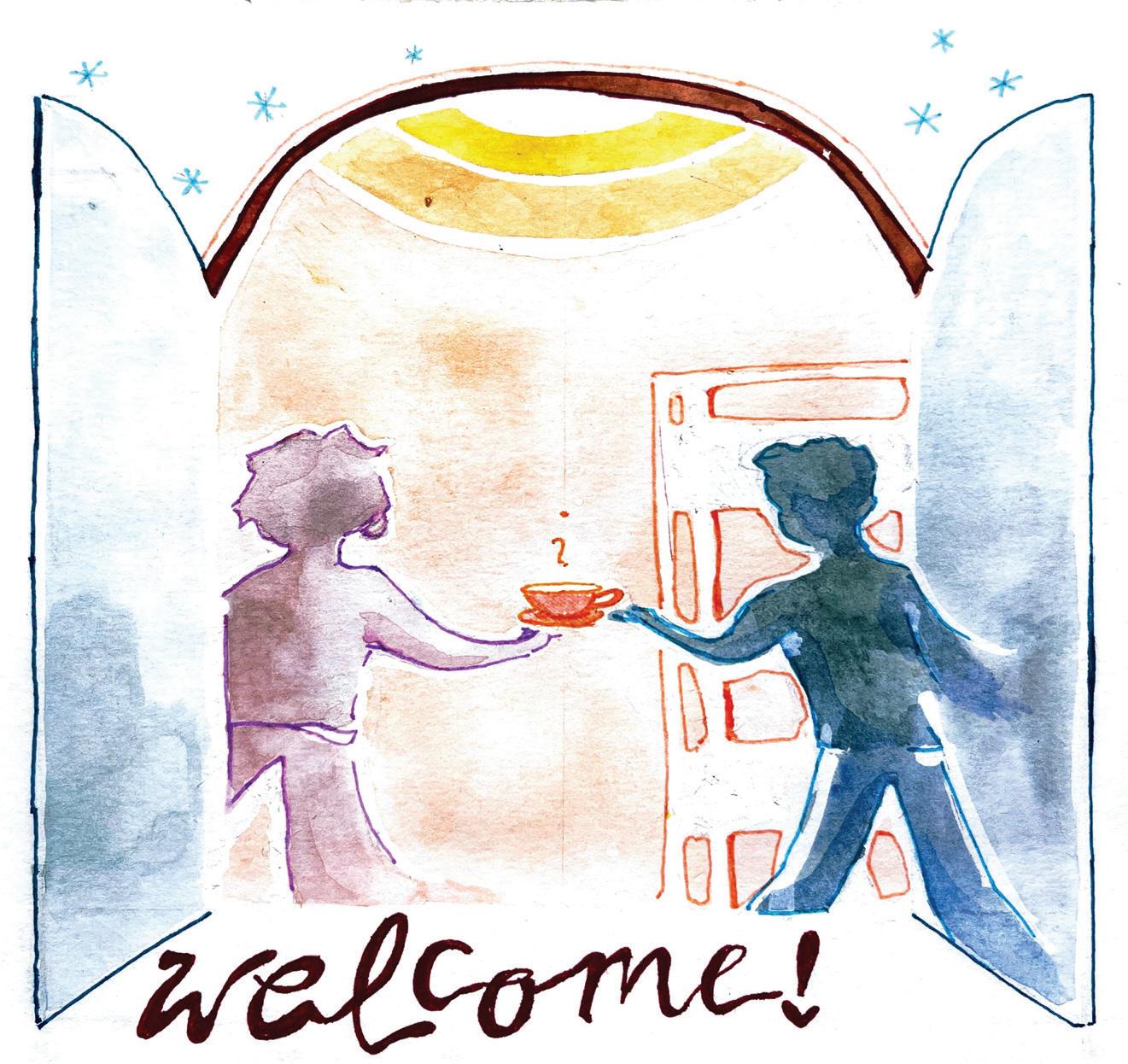
still calls me daddy — she knows nothing about daddy, and she never will,” Crawford said. He hasn’t been in touch with his daughter for a while. “I’m going to go and phone her, maybe today because I’ve got the money. I might just put a pound or two toward a phone box and phone her. I think she needs to speak to her daddy and know where he is so she can relax.”
While I was talking to Crawford, a woman dropped a few pounds in his bucket. He called out, “Thank you so much ma’am; stay warm; have a good night.” Then, he turned to me.“I like to think I’ve still got my manners… Sometimes people are rude to me, but I close my ears to them.” With this money, Crawford pays for his shopping, electricity, heating, and payphones — he doesn’t have a smartphone.
During our interview, a man stopped on the pavement to take a photo of Crawford — without asking permission.
Community Development, a local housing support group that gives out food deliveries and discounted furniture to people in need.
When someone is experiencing homelessness, this is often symptomatic of other issues, Smith told me: like genderbased violence, mental health struggles, or substance abuse. People misunderstand that — Smith criticised local press coverage “calling people ‘junkies,’ talking about ‘the other.’ They’re not the other [...] I know there are some people who would just like to drive them into the [River] Eden or the North Sea or whatever, but they’re part of our community.”
Scotland is one of the few countries in the world that classifies housing as a human right. Anyone at risk of losing their house can seek support from their local Housing Office, who will then refer them to organisations like Storehouse, a St Andrews food bank, or Starter Packs, a Dundee and Angus charity that gives free
“She knows nothing about daddy, and she never will.”
household goods to people who need them.
Starter Packs administrator Fiona Fox told me about one man her charity had helped. “This is a guy who’s lost everything,” Fox said. “He lost his family through addiction, his job, all the rest of it.” Whenever she’d see him, he looked “worse for wear.” But, after a couple of years helping him out, Fox remembered seeing him come into Starter Packs looking noticeably healthier and wanting to make his own donation. “That was an ‘oh my goodness’ moment,” Fox said. “The support he’d gotten in the beginning had come back full circle.”
She also spoke about a couple who were living out of their car. Once, the couple had had everything — “and when I say everything, they were at the top of their game. They were doing really well with their work, and financially they had holidays, cars, everything you could imagine people would wish for.” But one bad financial choice took everything from them.
Well-off people “can’t imagine what it’s like to have to worry about where the next meal is coming from,” Fox told me. “They can’t imagine that because they’re not in that situation… It’s just about being considerate and not judging.”
Hannah Cheek, who works for Dundee and Angus Food Bank, agreed with Fox.
“If you’ve not got savings [...] it doesn’t take much before you suddenly realise, ‘Oh wait, I actually can’t afford to put food on the table this month.’”
Back among Crawford and his teddies, I asked what he saw for his future. “With hopefully the help of the right people, I will go up again,” he told me. “I shall rise; I shall be somebody again. I will not be doing what I’m doing currently.”
To help fight the housing crisis, students can join St Candrews, a society which collects for food banks.
Illustration
by Lucy Maitland-Lewis
“We’re a Society with Secrets” Coffee chats, ritual, and a raffle with the Freemasons
MRUNMAYI KAMERKAR Features Writer
“The scaffolding on South Street. Twenty past six. I’ll meet you there.” Euan Cameron, Worshipful Senior Warden of St Andrews’ Freemason Lodge, was dressed head to toe in black tie attire, with a bottle of wine in one hand and a wooden briefcase in the other. Wine? “I’m not an alcoholic, we just run a raffle every week,” Cameron said. “It’s part of the charity work we do.” Briefcase? Most of my questions were entertained that night. Asking about the contents of the briefcase was not.
This was my second meeting with Cameron — my second encounter with the charity, pomp, and mystery of the Freemasons. I found him on Facebook: after a quick call, we met for coffee with Alan Lockhart, Past Master of Lodge St Andrews 25, the local branch of Freemasonry. Do Freemasons run the world? Does Freemasonry entail animal sacrifice? And most importantly, “How do you get in? Where is the door?” Commenters on Cameron’s Facebook wanted to know and so did I.
A quick Google search will tell you the Freemasons are one of the world’s oldest fraternities — a social and charitable organisation that originated in the guilds of stonemasons. A longer internet deep-dive will tell you that they’ve been associated with all kinds of rumours. World domination, flat-earthers, assassinations, and shadow governments — name a conspiracy and the Freemasons have likely been tied to it.
Lockhart was keen to clarify. “We don’t ride goats. And we’re not connected to the Illuminati.”
He told me he always finds books on Freemasonry in the “wrong” bookshop sections. “I always have a laugh when I see them in the ‘Occult’ section.”
has raised over a million pounds for Prostate Scotland. Still, some charities have refused to take Freemason money.
The main aim of Freemasonry, Lockhart explained, is to “make good men better”. Prospective applicants need three things: a clean record, high standards (“not a
“There’s nothing shameful about being a Freemason.”

the same,” Cameron said. “I enjoy women’s company as well, don’t get me wrong — but I enjoy the male bonding side of it.”
“Men need men’s company. Women are probably exactly the same.”
Lockhart stressed Freemasonry is first and foremost a “safe space for men.” It’s a chance to “meet a range of people from all walks of life and give back to the community through charity,” he said. Between the lodges based in Scotland, Freemasonry
The Freemasons have two sister groups for women: the Order of the Eastern Star and the Order of Women Freemasons. However, neither has a lodge in St Andrews.
For men, joining the Freemasons starts with a coffee chat, followed by an application form. Applications are read out during meetings and then voted upon. Many people join out of curiosity. Some will find that it isn’t the place for them and leave after a few weeks. “For me, it’s changed my outlook on life totally, for the good,” added Cameron. It’s a “rubber stamp on your character”.
With a page full of notes and Lockhart’s business card, I left our first meeting
back to 1598. Porter added that it was this history that drew him to Freemasonry. “We’re just custodians of the lodge at the moment,” he said. “This is something that has been here for hundreds of years and hopefully will still be here for hundreds of years.”
The group’s rituals go back to when their membership was majority medieval stonemasons. To make sure they were exercising their minds in addition to the manual labour of their daily tasks, they used to memorise sections of writing and scripture to recite “word for word” before their fellow workers. “There’s a kind of tradition in that. You take pride in being able to learn long pieces of ritual and being able to put meaning into it as well,” said Porter. history goes beyond ritual and is
embedded all across the town. Freemasons built the St Andrews Castle — in the Victorian times they laid the cornerstone of important buildings. Porter showed me a photo of the Freemasons’ Provincial Grand Master of Fife and Kinross laying the foundation of what is today the St Andrews Town Hall with the first stone. “You can see all the Freemasons gathered around at the laying of this foundation.”
The organisation has met in various buildings around town. If you look just near Zizzi’s, you’ll find their logo: the square and compass. At the top of Greenside Place is a white house with the symbol as well.
Cameron was born and raised in St Andrews — he recalled how surprised he was walking into the lodge for the first time.
“Oh, didn’t realise you were a Freemason, didn’t realise you were a Freemason.”
These days, though, some members are open about their masonic ties. “If anybody asks me, I’m quite happy to tell them,” Cameron said. “There’s nothing shameful about being a Freemason.”
“Oh, didn’t realise you were a Freemason, didn’t realise you were a Freemason.”
Porter was more hesitant. “If someone were to ask me about it I would, but some people are quite opinionated about it, and so I wouldn’t necessarily bring it up just in case it offended people.”
“We’re a society with secrets, not a secret society,” Cameron told me. These secrets are used to indicate levels of proficiency in the masonic craft. Today, they convey different levels of recognition. Porter pointed to a pin on his sash — each symbol signifies a different rank in the hierarchy. This pecking order is mostly ceremonial, though. Porter and Cameron emphasised the strong sense of brotherhood.
“Once we go through that door, we’re all the same,” Cameron said. “You know, we’re all equal, whether you’re a millionaire or you clean the streets. And some of them are millionaires.”
Illustration by holly ward
Gull-ageddon
A bird’s eye view of St Andrews’ seagull problem
GRACIE JONES Features Writer
One gull encounter left a first-year with a “scar”; local shops have pleaded with the University to conduct seagull research; East Sands’ Cheesy Toast Shack has sold £5000 worth of ‘seagull insurance’ since they launched the service in September. How scared of St Andrews’ seagulls should you be?
If you ask students this, you’ll get a barrage of harrowing tales about the feathered fiends. After hearing my fill of scary stories, I felt we should go back to this town’s medieval roots and tote around a sword to swipe at the “evil food stealers.”
How seriously should we be taking Gullageddon? I talked to ornithologist Professor Will Cresswell, St Andrew’s very own birdman, to find out.
In 2017, the businesses of St Andrews
and is still stunned by the incident.
After a long day in the main library, Walby got a hard-earned cookie from Northpoint Cafe and took a stroll along The
“Do you go out and shoot them? No, you go and educate them!”
Scores. But, as she reached the statue of Tom Morris, she heard a mysterious flapping. “All of a sudden I see this seagull following me [...] then he gets really close to my head, and I’m like, what the hell?” Several other gulls began to crowd around her. “All of them start[ed] to close in on me, and I was like,
character […] [as] a problem with gulls.” “People have no appreciation of risk,” Cresswell added — which makes bird attacks loom larger in the public mind than they do in reality. For example, Kate CarterLarg of the Cheesy Toast Shack said that they’ve only had about fifty claims made on their seagull insurance, despite five grand worth of sales. “It’s really not like gullageddon out there,” said Cresswell. “I suspect that what we have in St Andrews is.. a [small] number of super specialist gulls that were fed as youngsters [...] clearly, if there was a massive problem, everybody would be being attacked all of the time.”
However, that doesn’t stop former victims of the gulls from holding a grudge. “Honestly, it kind of spurred a hatred in me for birds in general,” said Walby. After her experience with gulls, Walby now declares that she doesn’t like any birds — especially seagulls. “I’m all for conservation and animals and protecting them, but why do you have to come for me? Not a fan of seagulls, not a fan of the people that feed them.”
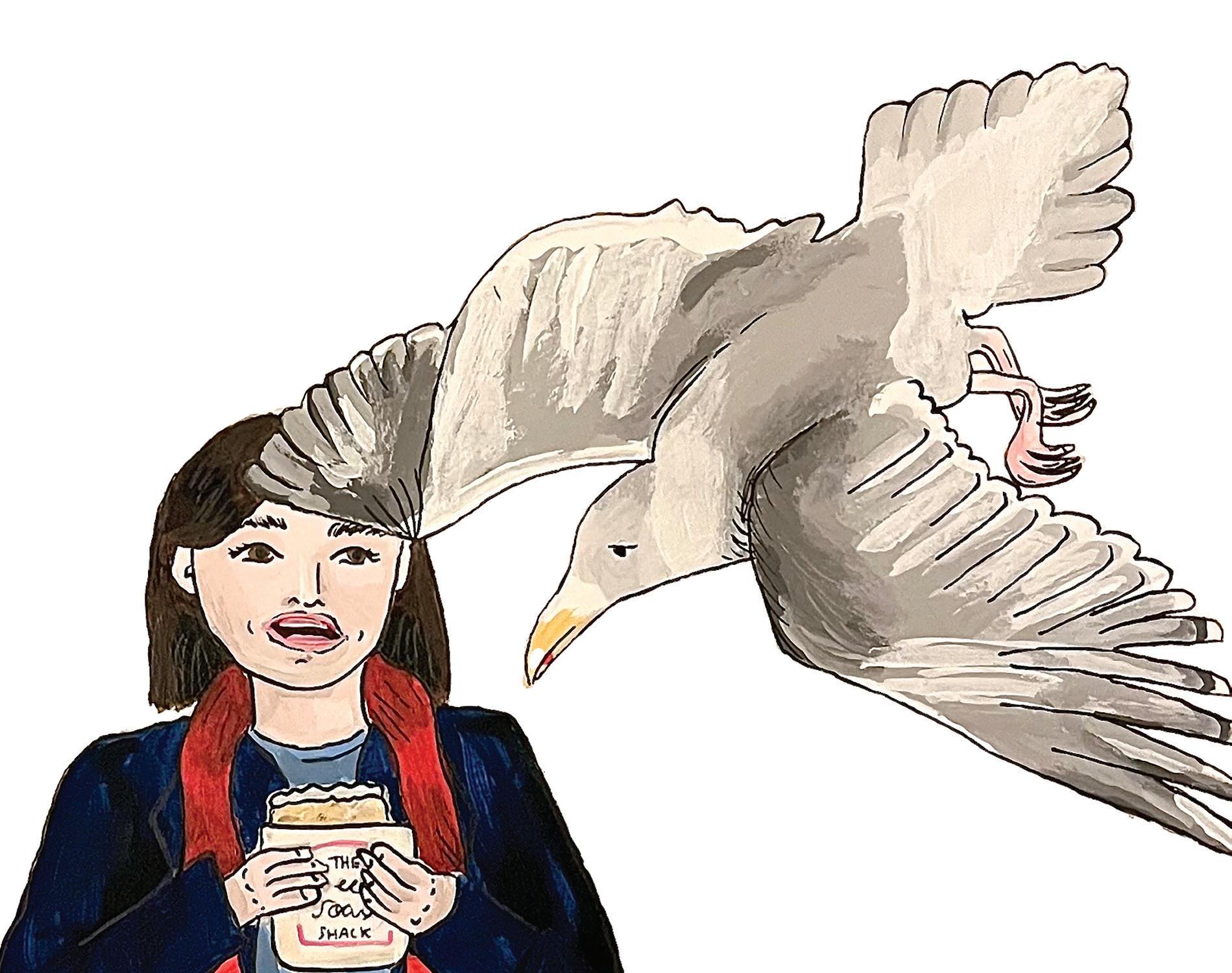
chuck a chip out and they train up the gulls to expect it,” Cresswell says. “So, is it actually surprising that these trained gulls, every so often... come down and get it [themselves]?”
With this in mind, the gulls’ thievery might not seem surprising, but it sure is shocking if you’re the one to get your croissant whisked away. Walby was robbed by gulls last Wednesday
don’t pat them on the back of the wings and say well done, we go ‘Oh my god!’”
Cresswell thinks St Andrews’ relationship with seagulls is a good example of a larger reckoning between humans and nature.
“It’s the human condition to complain about animals when they have characteristics that are just a tiny bit like ourselves, [...] and I get very frustrated with people that are manifesting some part of human failure of
Her final sentiment, at least, is one Cresswell can wholeheartedly agree with. “They’re career criminals, but we created them,” he said. “That’s not fair at all… they’re just being like humans, really.”
“The gulls are here, and yes they can cause a problem, but what do you do? …do you go out and shoot them? No, you go and educate them! You try to give them something more meaningful,” he said. If no one fed the gulls, there wouldn’t be a problem. and let live, advises. “It tells people than anything… they want somebody to blame or to complain at. I guess maybe it’s a good thing they’re going at seagulls because if they weren’t going at seagulls they’d be aiming at sectors of human society.”
Regardless, Walby’s newfound fear of seagulls isn’t going anywhere. “I mean, I love animals, but birds, I don’t really f**k with you.”
Trouble in Pitch Perfect Paradise? Inside Acapella At St Andrews by Celia
Irving
Despite the hordes of Americans, St Andrews lacks sororities and fraternities. But what it lacks in Greek life it makes up for in acapella. The Other Guys (TOG), The Accidentals, The Hummingbirds, The Alleycats, BELLS, The Rich Teas, and The Vocal Bandits make up the University’s vibrant acapella scene. TOG is the only all-male group, while the Hummingbirds and Alleycats are allgirls. They may harmonise on stage, but are the arrangements flawless behind the scenes? Or does singing in a lower octave come with a higher place in the hierarchy? cont. online
Meet Me Halfway: Questions for the Centre of our Political Scene by Ciara Wheeler
“Oh, they hate us.” Third-year Georges Toulouse laughed, leaning back in his chair with his half-finished coffee. “We’re seen as rather limp, we’re not as defined. I’ve never heard someone here say ‘Oh, you’re a centrist? That’s great!’”
“People who aren’t particularly in the political sphere, they talk about [Centrism] with a lot of disdain,” third-year Buster Van der Geest told me. He poured more Earl Grey into his teacup and took a sip cont. online
A Visit to Topping & Co with a First Year Published Poet by Sophie Rose Jenkins
“This is good,” says Cecelia Allentuck, pointing to a copy of Satoshi Yagisawa’s Days at the Morisaki Bookshop. We’re standing in the fiction section of Topping & Co. at 9am on a Tuesday to chat about languages, university, and I’ll See You Tomorrow, her book of poetry that was recently featured in an event at her local Barnes and Noble, an American bookstore chain. She’s sold almost 400 copies in six months, and has already been featured in Massachusetts newspapers — but her move across the world is her next big adventure. cont. online
Illustration by Isabella Abbott
St Andrews’ Most Eccentric Sport
A royal ride-along with the Real Tennis Club
of the St Andrews Real Tennis Club.
PETER NAPIER Features Writer
My opponent whacks the ball over the net into my side of the court. I’m not sure if I’m meant to return it and my indecision quickly proves fatal. The ball bounces once, twice, and eventually rolls to a stop, undisturbed by my racquet. “Did I just win?” my opponent asks. I’m not completely sure.
“If I were to design a sport that I think nobody would enjoy learning to play, it would probably be real tennis.”
To the uninitiated, this might sound like a somewhat pathetic tennis match. But this isn’t the sort you play in the sports centre. Our racquets are wonky, the ball is a heavy, handcrafted cork sphere, and the two sides of the court are entirely different from one another. Though it’s scored the same as ‘normal’ tennis — points go from ‘love’ to ‘40’ — a well-placed shot through a hole in a wall or a hit to a bell in the corner will instantly bag you a point. Our court is a bit more up-market than the sports centre — we’re playing on the grounds of an 800-yearold palace, on the oldest tennis court in the world. Welcome to the world of ‘real tennis’.
Real tennis has its origins in twelfthcentury France when the ball was slapped with a gloved hand instead of a racquet. The game spread across the royal courts of Western Europe and peaked in popularity during the sixteenth and seventeenth centuries.
As Europe modernised, the medieval sport was eclipsed by its far more accessible competitor, lawn tennis. As of 2025, there are only 45 real tennis courts left, over half of which are in the UK and none of which are exactly alike.
But St Andreans shouldn’t lose hope yet. A short drive out of town sits Falkland Palace, first constructed under King James V’s orders in 1538, and the only remaining court in Scotland.
“If I were to design a sport that I think nobody would enjoy learning to play, it would probably be real tennis,” said Kenneth Huang, the fourth-year captain
Though the club isn’t affiliated with the University, something Huang attributes to not wanting members to pay “130 quid for a facility that we don’t use,” its links with St Andrews students are arguably far longer-lasting than any other club.
“The first iteration of the club was back in like the 1400s and the 1500s,” Huang told me. “Back then the University had two courts. One where the current St Leonard’s pitches are and another where the Saint [the South Street bar, not the world-class student paper ] is currently.”
Huang points me to a 1571 passage from the diary of St Andrews student James Melville. In this, he complains that his father Andrew Melville — of prefabricated concrete hall fame — hadn’t given him enough sporting kit. He writes that though he had “bow” and “arrose” for “archerie”, and “glub and bals” for “goff”, he lacked the appropriate equipment for a game of “catchpull” — now known as real tennis.
Such concerns remained pressing right into the twentieth century, with the club surviving the global downturn in real tennis mania and only shut down. It was only with the outbreak of the First World War that it met its end, alongside many of its members. “They didn’t make it back
“They didn’t make it back and the club died with them.”
palatial glamour was forgotten, replaced by black stone walls more Barbican than Buckingham. Only the icy February sky

and the club died with them,” Huang said.
The club wasn’t dead for long, relatively speaking. In the mid-2010s, a group of students, armed with a newly-created Instagram account and access to the Falkland Court, decided to resurrect the club. Though Huang told me they faced some difficulty during the Covid-19 pandemic, by 2023 they were firmly established, even travelling to Cambridge to compete in the Inter-University Cup.
It was with these real tennis enthusiasts that I set out on the 40-minute journey to Falkland Palace in order to experience the real thing. After escaping Guardbridge roadworks purgatory, we arrived at the rear entrance of the palace and parked next to the towering building that housed the court.
Ever wary of the fate of French King Charles VIII, who met his end after hitting his head on a real tennis court’s doorframe, we ducked under a wooden barrier and entered the enclosure. The
among us over whether he had died or simply got bored. “I suppose he was quite old,” said Hinds. Discounting the rules, playing the game itself is deceptively difficult. I fancied myself a passable tennis player, but when it came to hitting the ball, the bounce of the cork and cloth balls was a weak imitation of any modern tennis ball. I was left wildly swinging at the
“I was left wildly swinging at the air above, as if trying to swat a medival fly.”
air above as if trying to swat a medieval fly. When I did get a hit over the drooping net, the club’s more experienced players promptly sent it back my way with a sharp
crack of racquet against cork. “There’s a lot of people in the club right now who have a lot of bruises from me,” Huang said. After this quick warm-up, we venture onto the topic of rules. The first covered were the ways to score. Apart from the conventional double bounce, you can also score by hitting the ball into several areas and targets on the opponent’s side. Unique to Falkland, these targets included a number of small openings in the back wall of the court, known as lunes. However, this also meant the ball risked being lost in the garden outside the court. This introduced a unique sporting situation where winning a point would incur a charge of £8.50. For those who eventually understand the game, a “huge network” awaits. Even small and far-flung clubs like St Andrews get “substantial support” from the UK’s governing body. “Anything we need is taken care of,” said Huang. who is currently considering using the funding they receive to purchase “a club car” that would ferry them to Falkland. Huang hasn’t let these networks go to waste. He told me of his time apprenticing for a professional player on a court in Newcastle, where he now spends four days a week. “I rotate between friends’ couches, maybe the occasional hotel.”
All this serves as Huang’s preparation for a prestigious fellowship, which allows qualified young people to apprentice at one of the US courts. “Your accommodation is usually dealt with, and they give you a monthly stipend on top of whatever you earn at the club.” Not a bad deal for a sport he reckons has “only twenty” players across the US younger than 25.
Yet despite all the glory and glamour, Huang remains aware of his place in the real tennis food chain. “I don’t think I could beat the sixteenth-century dudes,” he said. “I can’t even beat some of the 80-year-old guys at Falkland.”
Illustration by Elizabeth
Lang
Puzzles

Start Your Engines!

Crossword by Greta Shope
ACROSS
1. X minus II
5. Surrounded by 10. Nadirs
14. Merit
15. “_______ Virgin” (Madonna hit)
16. Opera showstopper
17. Manchester forward Diallo
18. One manning a canoe, maybe 19. Wing of an orphanage, or one who sleeps there
20. Hotel chain founded in San Antonio
22. #10
24. Former Cubs star Sammy
25. One who rides the rails
26. “Big Energy” rapper
28. Give in, on the schoolyard perhaps
32. Super
33. Canadian border town ____ Ste. Marie
34. Early email provider
35. Sticky
36. Rush
37. Nurses
38. Eur. nation bordering Germany and Switzerland
39. Tool you might take for a spin?
40. Indulgence
41. Meryl Streep showstopper, or the movie in which she sings it!
43. #55
44. Similar (to)
45. Bon ____ (good evening, in Grenoble)
46. Prince Eric’s love
48. Sat back
52. Coloured part of the eye
53. Indigenous to the Caribbean
55. Part of a backsplash, maybe
56. 52-down synonym
57. Lo que viene después de verano
58. #31
59. Airline that might fly to Tel Aviv
60. Relating to newborns
61. Series that begins in March, or what 22, 43, 58-across and 5, 10, 36, 45, and 49 correspond to
Anagrams: Actors’ Last Names
EDITOR: ALEX LE SAGE
by Iris Hubbard by Julia Emery
by Alex Le Sage
Make as many words as possible! Rules: Words must have at least 4 letters and must contain the center letter. Letters can be used multiple times. Scoring: 4 letters words are worth 1 point each. Longer words are worth 1 point per letter. Each puzzle has at least one word which includes all the letters and gives you seven bonus points.
Word Search
DOWN
1. Venison
2. _____ Killer (true crime Netflix series)
3. See 23-down
4. Banking or Agrigulture, to name a few 5 #14
6. Sporty Mazda
7. Pods common in Cajun cooking
8. Formerly, as written on a savethe-date
9. Gothic carving that may give a chill
10. #30
11. Many a language exam 12 Sly
13. Blue
21. Any inkling
23. Border, as 3-Down does with Turkey and Jordan
25. ______ Couture
26. Cry, in Córdoba
27. First-string
28. Alexander nickname
29. Stones used for a burial mound
30. Jennifer or Mario
31. Other
32. Uni. in MI
33. Delicate dress material
36. #44

37. ________ St. Louis, Lindbergh’s custom flyer
39. Baikal or Erie
40. Take to the seas
42. Brosnahan’s comedic superstar
43. “Neat!”
45. #12 (fmr.)
46. Disappearing sea
47. Latvian capital
48. Demonstration
49. #27, informally
50. Musk who was recently revealed as a father of 13
51. Narrow valley
52. Synonym of 56- across 54. ______ moment’s notic
AVATAR AVENGERS BATMAN CASTAWAY ET FROZEN GLADIATOR HARRYPOTTER JAWS MINIONS SPIDERMAN STARWARS TITANIC TOPGUN
by Julia Emery
Illustration by Hannah Beggerow

EDITOR: ALDEN ARNOLD
Houses of Colour: The Doors of St Andrews

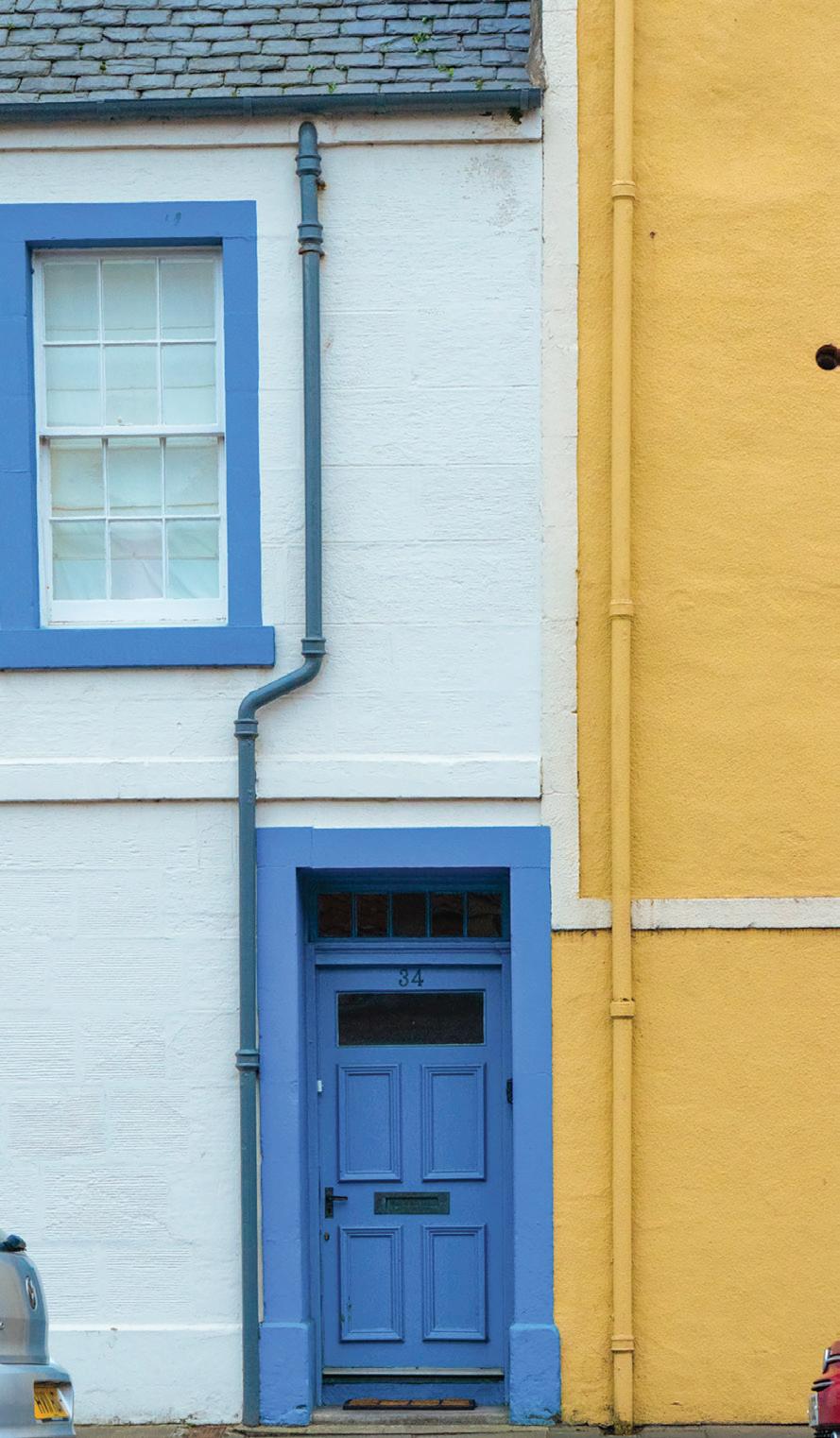


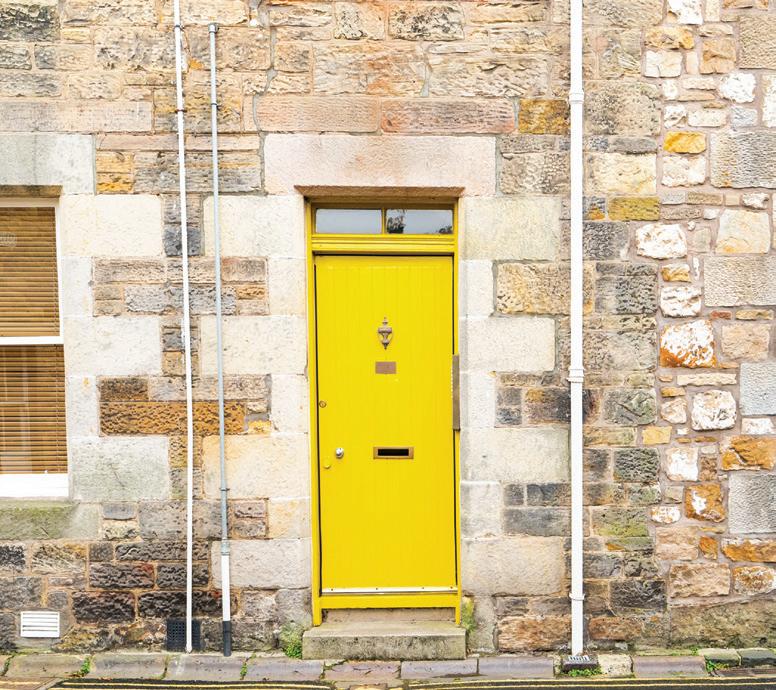
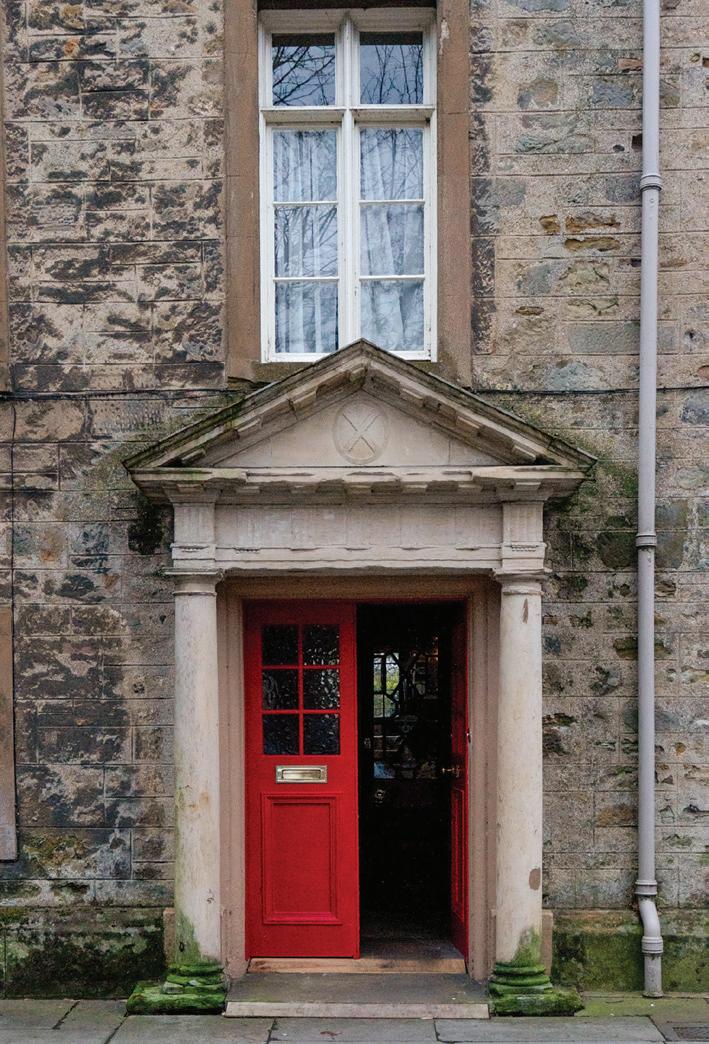



TRICIA MERONE Photographer
HEATHER WALLACE Photographer
Keep Our Beaches Clean
Pick up 19kgs of rubbish with Marine Society
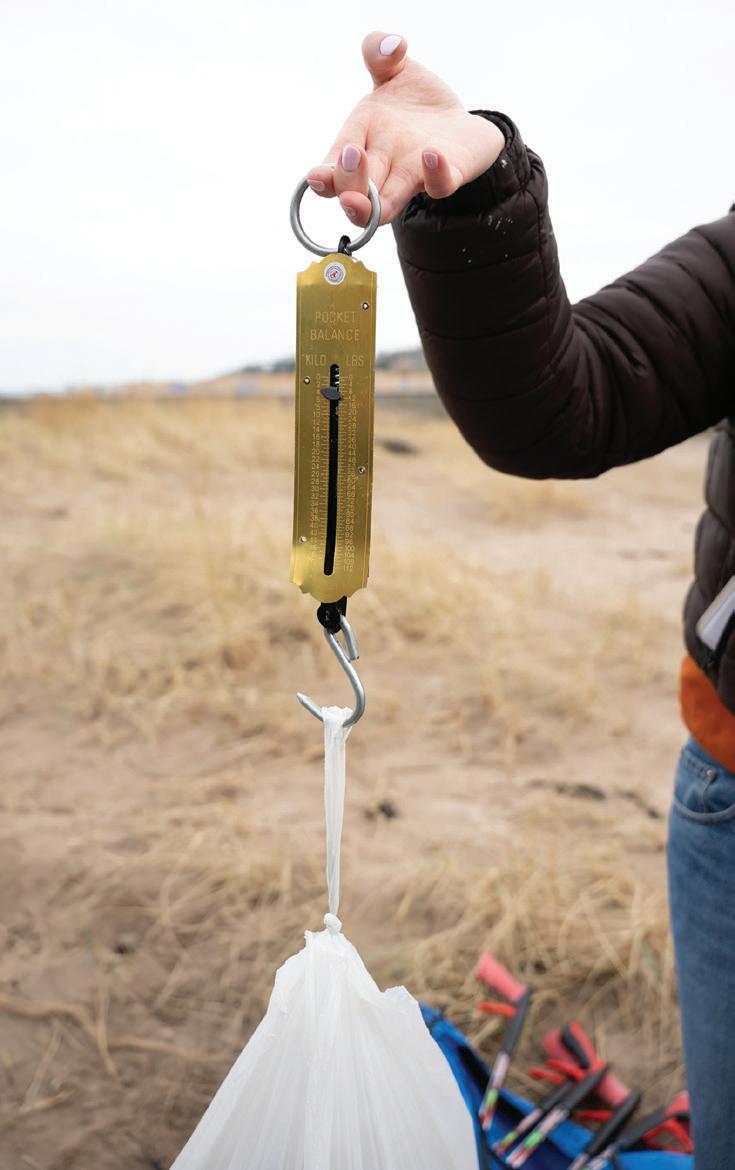
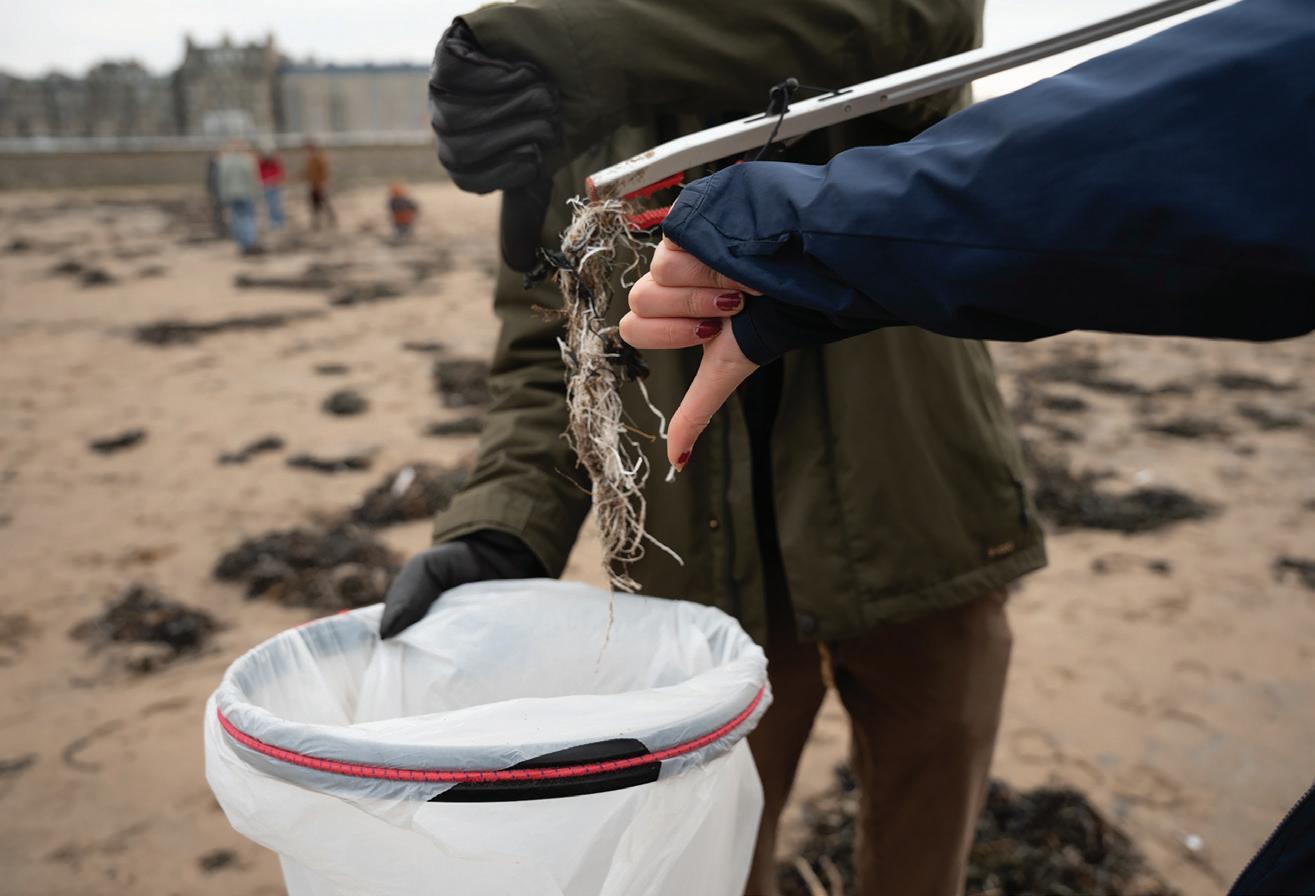
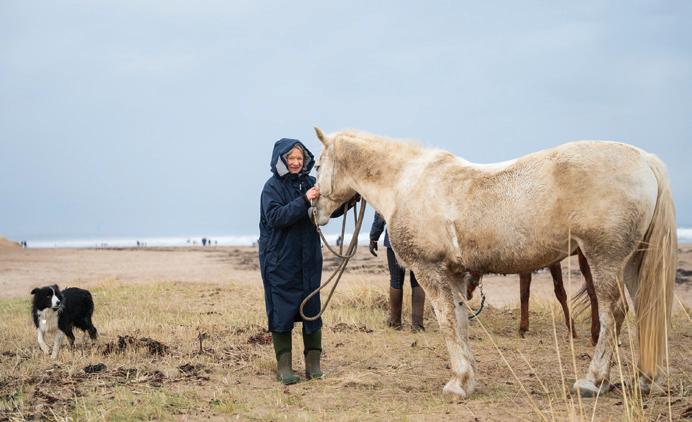
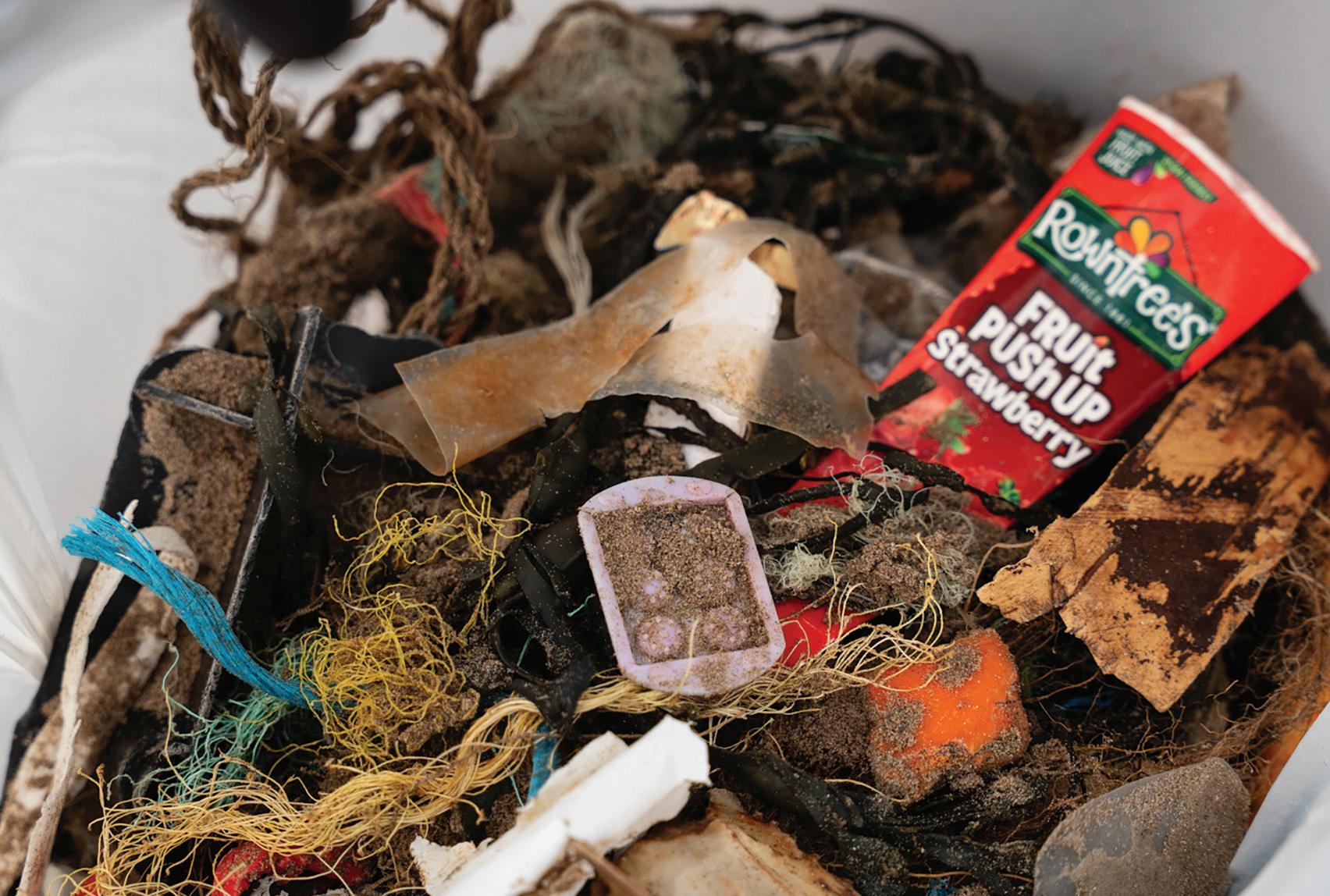
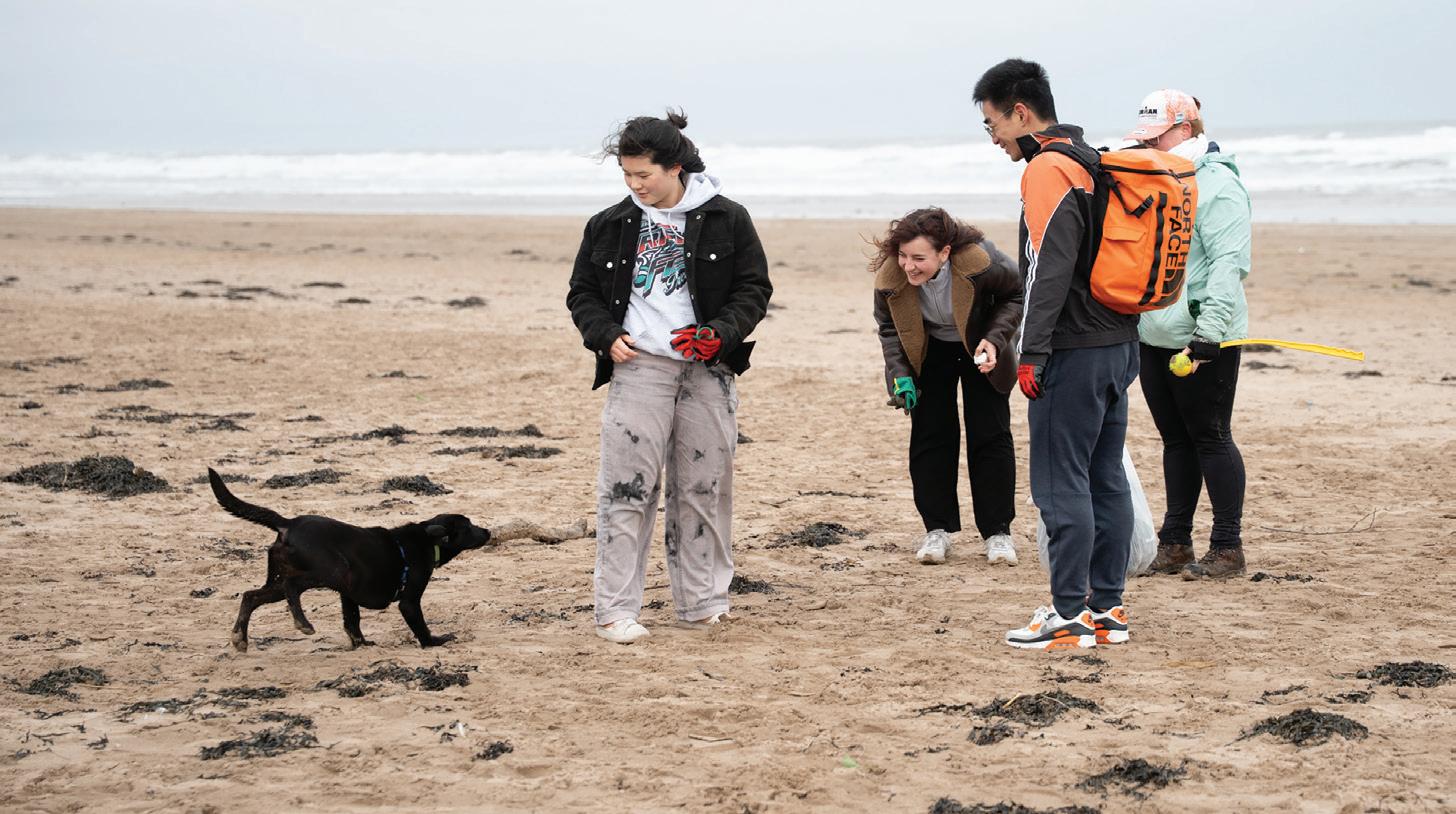
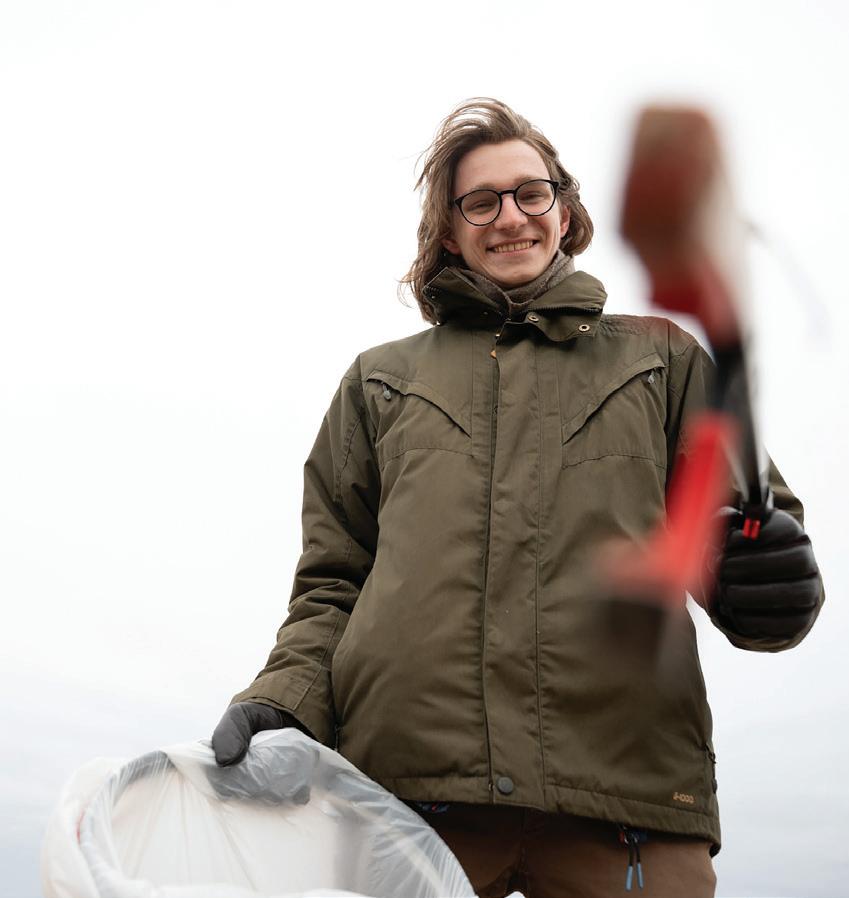
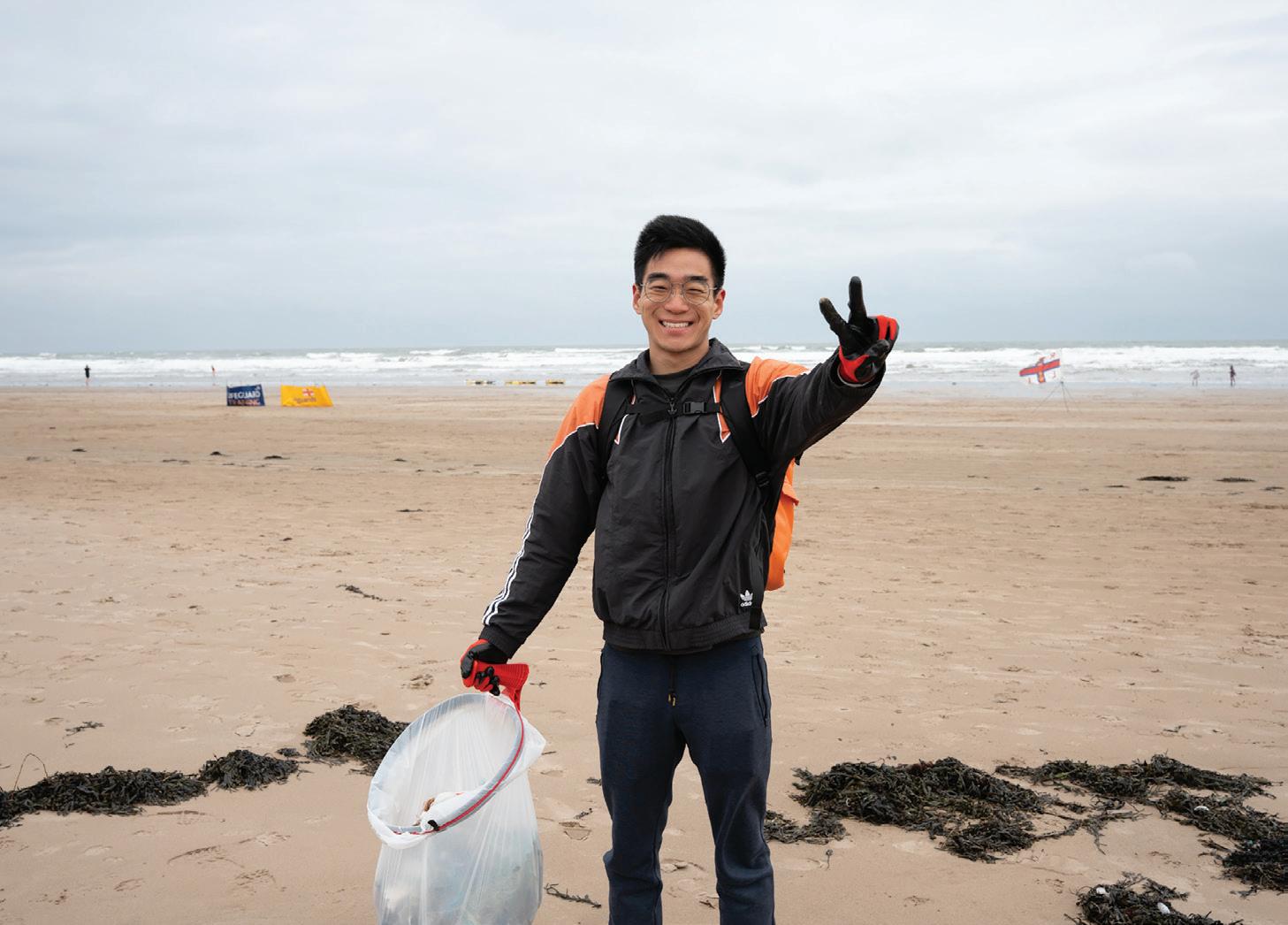
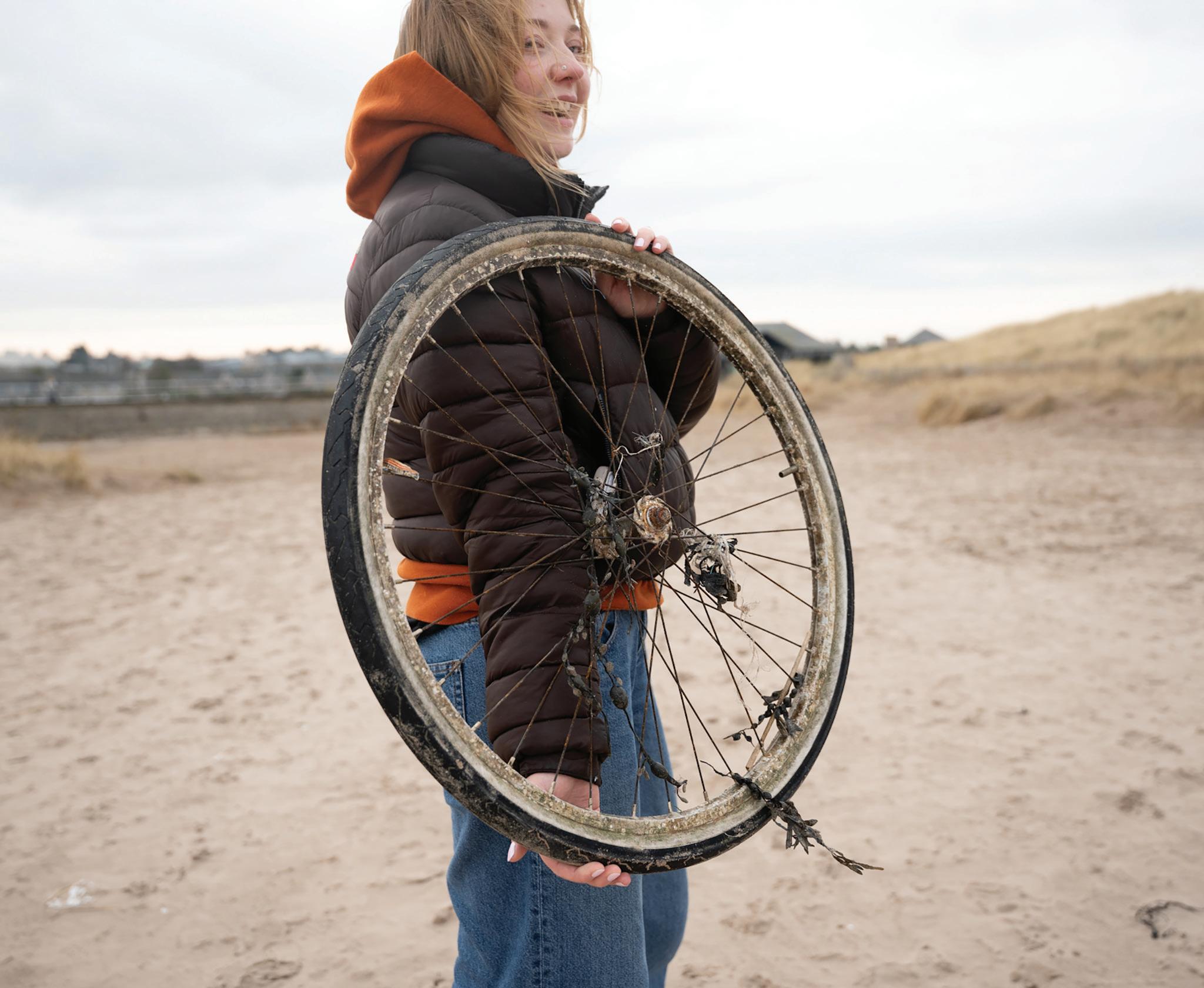
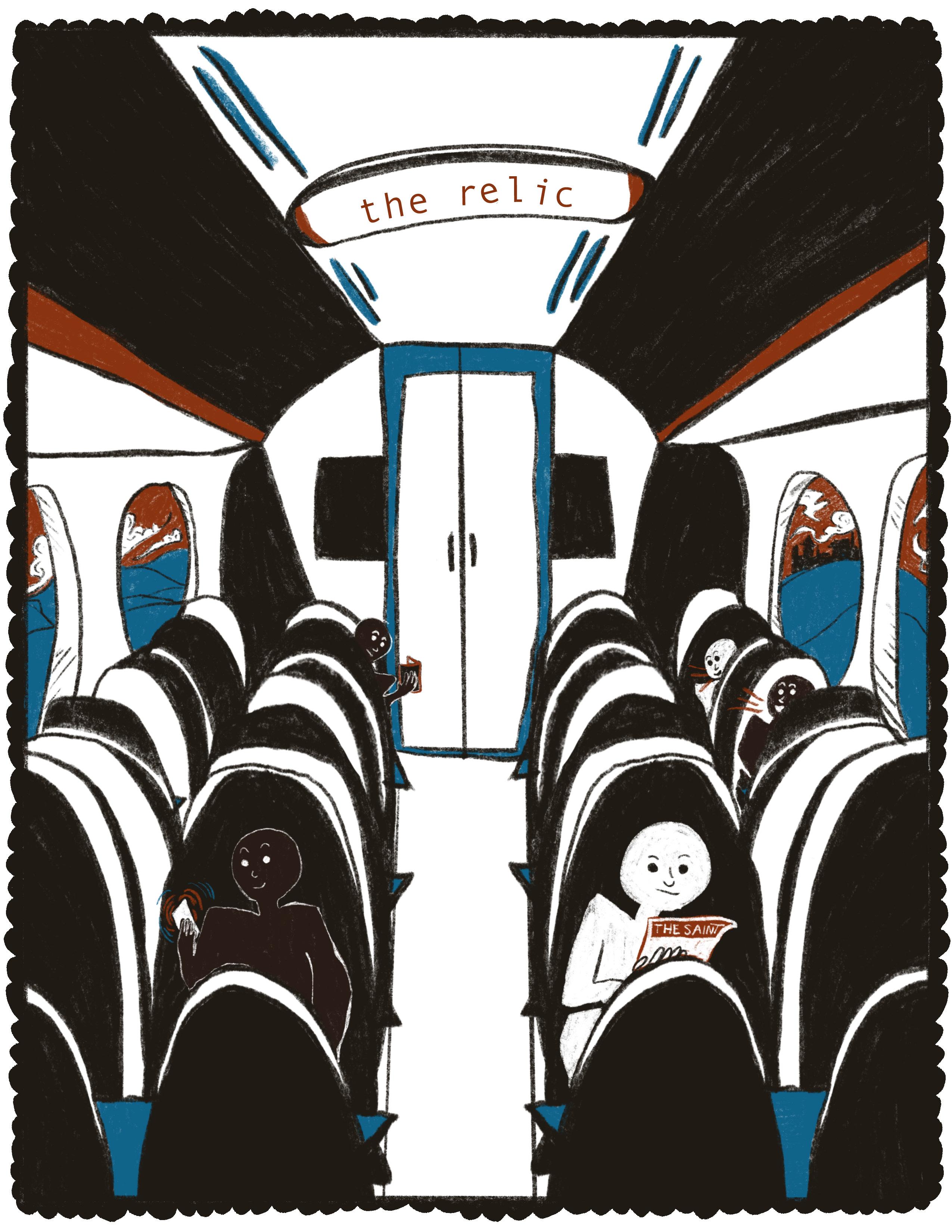
EDITOR:ARNAZMALLICK
Triple Threat: An Explanation of ‘Witchiness’
EMMA INGRAM-JOHNSON
Relic Writer
‘Witching hour’ is a common phrase in my household — three daughters under one roof often devolves into chaos. Usually, this critique comes from outsiders — we speak in incomplete tongues and cackle late into the night, utterly wicked, foreign to visitors. Thus began my interest in witches. However, I think the aversion to my beloved ‘witching hour’ runs deeper than surface-level fear. I turn to literature to understand this — beginning with Shakespeare’s iconoclastic, cauldron-hovering, ‘toil and trouble’-ing sisters, with whom I identify enormously.
The shock-waves of the witches in Macbeth reach disparate corners of the literary canon: from Terry Pratchett’s Wyrd Sisters to the fairies in A Midsummer Night’s Dream, cutting back to the twentieth century in Margaret Atwood’s use of witches in almost all of her novels and essays, most notably in Cat’s Eye. Incessantly, we return to the motif of three women or girls, and spectators cannot help but be drawn in. What spell is being cast here?
Perhaps it is a perverse desire for the abnormal or an acknowledgement that bonds between women are best represented by a coven. Most convincingly, it reflects
restriction in the portrayal of feminine characters, figures, and emotions. It is a risk to present a feminine character with any kind of power or superior knowledge, particularly where this trope is most recognisable, in seventeenth century England. The voice of a singular potent, often polemical, woman is not necessarily difficult to locate in literature (see Margery Kempe and the Wife of Bath’s Tale), limited though they may be by their male writers, groups of women are almost exclusively ridiculed or made malevolent so that they remain far from organised revolt.
The witches in Macbeth, although early examples of this, are not actually prototypic. Shakespeare draws upon Holinshed’s Chronicles of England, Ireland and Scotland for historical context. The ‘weird sisters’ encountered by ‘Makbeth’ and ‘Banquho’ are ‘goddesses of destiny’,
‘endowed with knowledge of prophecy’. This knowledge is key to the witches’ presentation and characterisation — but it is not what is taken with the audience when they leave the Globe.
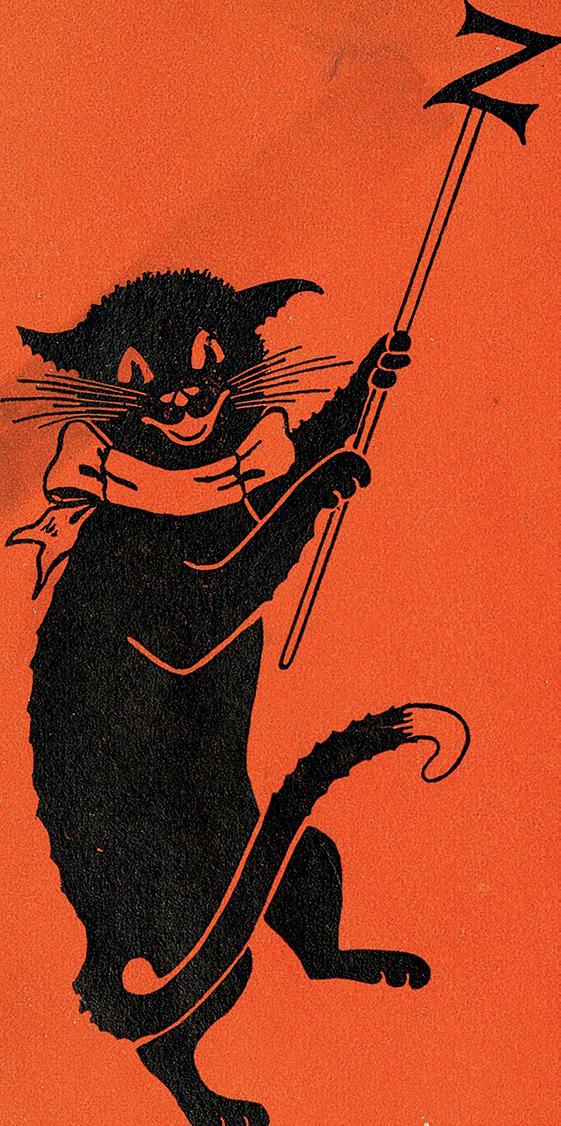
The feeling that lingers is one of terror and unease. Lest the volume of women on stage spook Shakespeare’s contemporary (male) audience, the witches are made subjects of distrust and fear. The belief that women held supernatural knowledge threatened to topple society’s order: how is it that women have the power to create new life, to seduce men with their wiles, to predict the world turning? Something malign must be afoot.
Shakespeare’s ‘weïrd sisters’ are terrifying in performance not only because of their foresight but also their rhyme. To a modern audience, the couplets the sisters speak in are unfamiliar and hypnotic. An RSC production I saw at the Barbican in
2018 involved primary school-age children playing the witches, invoking the audience’s repulsion. It put me in mind of the fossil sisters, a quasi-foil for the witches in their Christian simplicity. The girls make a ‘solemn vow’ in Streatfeild’s ballet-based novel, ‘hand in hand’ (just as the ‘weïrd sisters’ are in Act IV of Macbeth) and rhyme in their promise to not let their merits be the claim of the men in their respective lineages. The girls promise to strive for autonomy and to further their knowledge, thinking of the future; they are prophesying. Streatfeild invokes the image of the witches, fortuitously highlighting the contrasting emotions the audience feels towards each trio. For the witches, their malice and misconduct are emphasised; for the dancing sisters, their sisterly search for power and knowledge shines on in radiant beams. Women working together becomes inherently dangerous to male hegemony. Indeed, this presentation has been used to justify keeping women from positions of power or, in a medieval mode, from allowing them to form valuable networks of spoken word ‘spells’ and advice. Women cannot escape the associations that are attached to the image of the three witches. Personally? I attempt to ensure that the triple threat thunders on.
The Midnight Paintings of Dr Seuss
SOREN RASMUSSEN Relic Writer
To say that Theodor Seuss Geisel has impacted contemporary culture is a gross understatement. He’s more synonymous with rhyme than Shakespeare. His stories and characters are cultural touchstones for multiple generations of readers — and his imaginative, idiosyncratic illustrations have made his artistic style among the most iconic of all time. Yet, shockingly little has been made of perhaps his most personal and distinct works: his paintings. Created at night and in spare leisure hours throughout his career, the so-called ‘Secret Art’ or ‘Midnight Paintings’ of Dr Seuss were not revealed to the public until 1995, four years after the artist’s death. They display all the typical Seussian elements — preternatural creatures, impractical architecture, and, of course, cats — but wildly unlike his child-oriented illustrations. They’re structurally complex, highly detailed, and reveal a level of technical ability and artistic maturity seen nowhere else in his wider work. He succeeds at a variety of styles, from the claustrophobic modernism of Cat Detective in the Wrong Part of Town
(a personal favourite), to an incredible abstraction of a church in Archbishop Katz, to the surreal Art Deco of Stag at Eve. All his colourful whimsy and invention, that ethereal atmosphere that has fostered kid’s imaginations for decades, runs wild without subordination to story or meter, creating a singular space for himself in the medium. So for an artist this culturally salient, why, after 30 years, has so little been said of these works? Why are they still so unknown?
One reason is merely the collision of antithetical worlds. Seuss’s young audiences have no practical use for fine art as they do for phonic picture books, and the fine art world takes itself too seriously to let him come frolicking in with his cats in hats and assume standing beside a ‘serious’ artist. It’s not easy to argue that a work called Venetian Cat Singing Oh Solo Meow deserves much more than a polite chuckle. Regardless what the titles may be, however, it’s their signature that holds them back. Dr Seuss is simply not a name to pronounce with a straight face. How can one
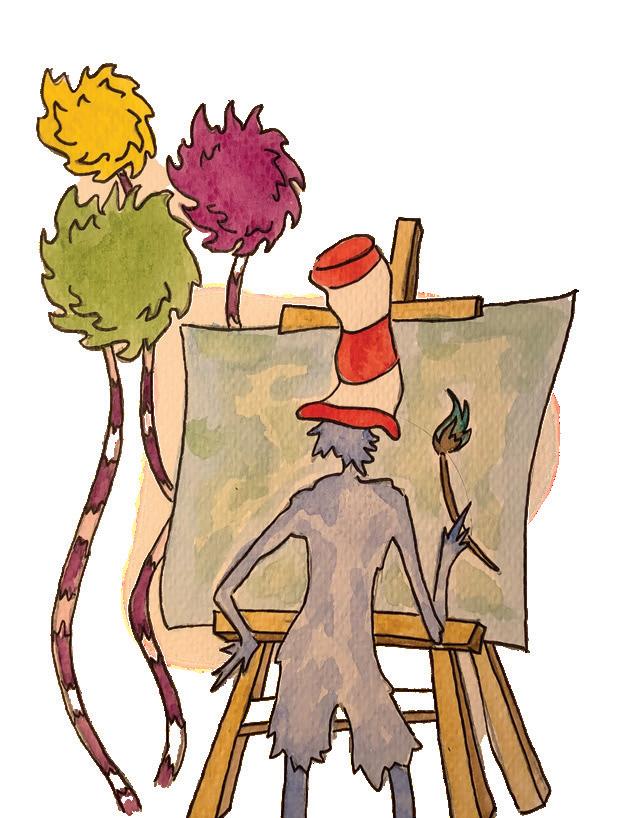
reconcile the man who painted these works with the man who rhymed ‘wocket’ with ‘pocket’? The bits of press the paintings have received attempt a marketable solution: he was two people. Highlighting only his dark, existential canvases, they tell a Jekyll & Hyde narrative, turning Seuss into a werewolf of suppressed emotions that would only emerge in the darkness: a cat smoking becomes an alter ego, a black background becomes a subconscious abyss. And while it’s an easy story to sell with his darker works, satisfying our romantic desire to build any artist into a mysterious, unknowable persona, it cannot explain the remainder of his art that is missing such tormented psychology. Must these sides be reconciled, though? Can we ignore his farcical reputation to consider these works as themselves? For Seuss, separating art from artist is unfortunately well-trodden ground: in
Image from Wikimedia Commons Illustration by Amelia Freeden
2021, six of his books were discontinued for racist caricatures and stereotypes. This brought his wider legacy into serious question, but oddly changed very little for his paintings; they were already drowning under the weight of their signature. This obsession with authorship runs far beyond Seuss, of course. The fine art world is an industry of names with works attached, not the other way around. Yes, it’s important to credit the hand behind the brush - and often the story behind an artwork can further its beauty — but there’s more to art than personal narrative: not every painting is a self-portrait. Great art can speak for itself, and it’s worth letting Seuss’s canvases try. There is one Dr Seuss canvas that has escaped his signature. In the corner of his Green Cat with Lights, stark yellow letters read Stroogo Von M. It was a rare canvas he displayed to the public in the entryway to his home. “That’s my Stroogo Von M.,” he would say when visitors asked, hoping to receive an honest opinion free from the influence of authorship. On more than one occasion, it’s said that a guest replied, “Oh yes, I’ve heard of Stroogo Von M.”
Adventures with Topping & Co.
Looking for your next read? The Saint and Topping & Co. have come together to save the day. Find below the best adventure stories, all books are available locally in store.
BOOKSELLER PICKS
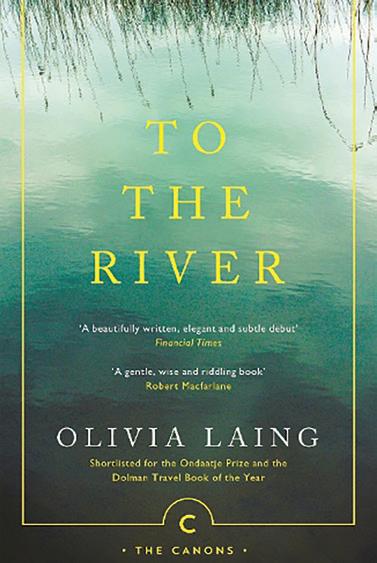

Behind The Cure’s Success
ALEXIA HEASLEY Relic Writer
Ruby Recommends To the River by
Olivia Laing
This is a book of meanders, in all senses of the word. We follow Laing along the banks of the River Ouse, Sussex, the water in which Virginia Woolf drowned herself in 1941. Before her death, she had become fixated upon this landscape. Sixty years later, a harried and heartsore Laing picks up the baton. From source to sea, we are guided by her winding internal monologue, picking up histories out of the water. Fairy tales, Dante, battles and floods and dinosaur bones are some of what she finds beneath the surface.
Laing writes as though flora and fauna were her first language. Where she describes nature her voice shimmers away into dragonfly wings and pollen clouds. Wherever you find yourself over reading week, this book will have you wandering and wondering.

Murray Recommends Into the Wild by Jon Krakauer
“I don’t want to know what time it is. I don’t want to know what day it is or where I am. None of that matters.” Into the Wild speaks to the innate urge to reject modern society and return to nature. It follows Christopher McCandless, who embarks on an adventure to find freedom, wisdom, and solace far from the trappings of modern society. As he abandons his identity, wealth, and security, McCandless ventures into the American wilderness with little more than his convictions. Through his encounters along the road, we are filled with hope for the good in this world, while also being grounded by the very real dangers of both modern society and the desolate wilderness. This heart-wrenching journey serves as a haunting reminder of the fine line between idealism and reality, echoing the yearning in all of us for something more profound than the confines of civilization.
STAFF PICK

Claudia Recommends The Doll People by Ann M. Martin and Laura Godwin
My most nostalgic childhood book, one that has continued to bring me joy in adulthood, is the timeless novel The Doll People by Ann M. Martin and Laura Godwin. The story follows the secret lives of a Victorian porcelain doll set that has been passed down through generations of girls in the Palmer family. Now owned by Kate Palmer, Annabelle, with her painted green hair, is tired of being cooped up in the dollhouse. Accompanied by a friend, she embarks on an adventure to find her missing Auntie Doll. There is something so enchanting about exploring the crevices of a house from a doll’s perspective and dodging their biggest enemy, the Palmers’ cat. Although a children’s book, the story’s blissful plot, along with Brian Selznick’s vivacious illustrations, makes this novel jubilant for any age.
The Cure has been around for so long that the members should have retired, started attending weekly bingo sessions, and become obliging participants in middleaged life. Yet, 47 years on from its founding in 1978, the band continues to release music and perform with the same unmistakable sound that makes them seem now both a little too old and a little too cool for their own good. Robert Smith’s voice rings so clear in the 2024 album, Songs Of A Lost World, that it has been widely compared to the 1989 album, Disintegration, the band’s magnum opus. Between these two releases, the band has defied the unofficial rule that a rock band should implode, break up, or make excessive use of the word “reunion” to avoid fading into the dust-ridden hall of fame. But with seventeen million monthly listeners and a sold-out world tour in the last two years, the Cure remains relevant and beloved by its fans. The enduring popularity of the band owes a lot to its familiar sound. Fans expect instrumental degradation when a band has been around for so long, but Robert Smith’s voice cuts right through the years, unfaltering. It inspires a new comfort that perhaps not everything is as transient as we expect it to be, defying the existential lyricism he so often sings about. When asked about his secret to the voice of immortal youth, he simply shrugs, laughs, and professes his own confusion at the fact. Having never given up on their sound, The Cure remains true to a stylised fusion of new wave instrumentals and gothic rock lyricism. It is not only Robert Smith’s voice that remains the same, but his image too. He appears on stage looking impossibly pale, with smeared lipstick, dishevelled hair, and black clothing donned just the same as when he first debuted the look in the ‘70s. It feels like bumping into someone from school years down the line, and while all the trends around us have changed a hundred times over, they are still wearing the same clothes they always wore with a childlike smile that has not been worn down by age. You feel almost inclined to thank them for reminding you of what once was, for not changing when everything else did. Smith
prompts the same reaction, creating a relationship between himself and his fans that can be relied upon. The Cure creates a feeling of reciprocity with its fans, rather than a service. Through their intellectual lyricism, the band relies on their listeners to understand music beyond its surface-level offerings. One of their earliest singles, ‘Killing an Arab’ (1979), takes its story from the absurdist writings of Albert Camus’ L’Étranger. In providing something beyond mindless lyrics, the music encourages an intellectual sphere of engagement, a compliment to the listeners. In the same manner, the production of Disintegration challenged the Nietzschean ideal of transcending despair through art. In sharing their music, they provide a comfort detached from the nihilist assumption of despair. the Cure’s music became something that people could turn to in a state of melancholy; not for escapism, but for empathy. The range between the joyous tones of ‘Friday I’m in Love’ and the surreal fear induced by ‘Lullaby’ seems an insight into the complexity of being human, a soundtrack to life.
In a recent interview with Stephen Thompson, Robert Smith declared that, with no children to impose it upon, he has no concern for legacy. In classic existentialist fashion, he states, “That’s what I do, it’s just there. And how it will end is how it will end.” His efforts to live in the moment and produce music that does the same encourages his listeners to reproduce the sentiment. His music will always remain familiar because it is at the same time a product of his earliest album and everything we are experiencing in the present day. While hope for more music may have dwindled in the sixteen-year gap between 4:13 Dream (2008) and Songs Of A Lost World (2024), the vitality of Robert Smith seems as mighty as ever. So when he cries out ‘This is the end!” in the recent album’s opening track, I advise not to take this to heart.

HANNAH SHIBLAQ Deputy Editor-in-Chief
There’s a common phrase which says that we exist as mosaics of everyone we’ve ever loved. In my case, ‘everyone’ transcends the bounds of reality and onto film screens and bookshelves, straight into the Land of Make Believe, from where, even at 21, I still haven’t managed to depart. Yes, I consume media, but media consumes me in return. I guess you could say that I’ve never enjoyed it to a normal extent. My devotion comes from within and manifests without: where some look to entertainment solely for entertainment’s sake, I instead see the opportunity for self-reinvention. Rather than choosing the road not taken, I will almost always opt to follow in the faulty footsteps of my favourite fictional characters. I’d say that while I excel beyond mere moderate enjoyment (albeit lacking the enthusiasm required to reach ‘stan’ status) I’ve always been relatively discreet about this part of my life. It’s no surprise as to why: when you’re a woman who enjoys movies, television shows, bands, and/or book series, you automatically and will forever be known as a fan-girl — never just a fan. This gendered additive comes equipped with hefty stereotypes, suggesting not only that ‘hysterical’ behaviour is expected of female
Fan-Girl and Proud Confessions of a (para)socialite
fans, but also that their preferred media is both unintellectual and unimportant. Just for once, I would like to enjoy Twilight without some Letterboxd pro user insisting that The Lighthouse should be regarded as the pinnacle of Robert Pattinson’s career.
As far as I was always concerned, fandom had no place beyond my computer screen and imagination. My friends and I didn’t discuss the topic until months into knowing one another. It was only at my mention of the word “ship” — not in reference to a maritime mode of transportation but to my favoruite fictional couple — they rightfully recognised me as one of their own: a fellow harbourer of edits and ePubs. One of my friends ran a relatively successful fan account equipped with her own watermark. Another had cultivated years’ worth of friendship via a group chat of mutual fans on X. All of us were well-versed in troped alternate universes, knew the distinction between “canon” and “fanon,” and had passed our
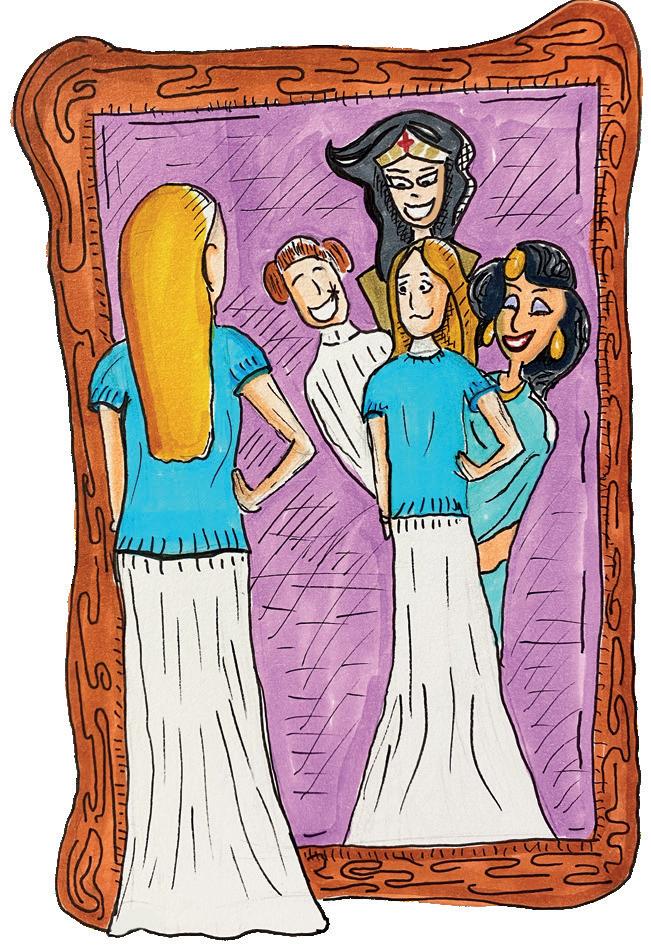
adolescence shamelessly enraptured by the Internet’s best-kept secret. There was (and still is) an empowerment in fandom’s privacy: from the safe confines of your bedroom, exchanging ideas with those just as whimsically wired, you can be as unapologetically ludicrous as possible. Consider a twelve year-old who wants to be an author when she grows up. She can test the waters by writing about her two favourite characters without crossing the threshold into the competitive, political realm of the publishing industry. She may grow up to be the next New York Times best-selling author, whose own works may even inspire another twelve-year old to make their start just as she once did. The cycle continues, reaffirming that anything is possible, and fandom reigns omnipotent. So, if you’re anything like me, the unconventional “tall child” byproduct of unsupervised perusals on Tumblr and Ao3,
I challenge you to embrace it. You hail from a long line of story-telling aficionados. If Dante can take a walk through hell with Virgil, then who’s to say that you won’t get adopted by One Direction? And while your life is not guaranteed the safety cushion of fade-toblack cuts and rolling credits, sure to work itself out with scripted resolutions to last season’s cliff-hangers, that’s precisely why real life is just as adventurous and magical. Even if fanfiction isn’t for you, consider its principle: borrow characters (or, in this case, their characteristics), and make your own story. If your favourite fictional confidants can tumble down rabbit holes and trek down yellow-brick roads, you can take a risk or two — even if you’re unsure what your rising action will amount to or what stage in the Hero’s Journey you’ve reached. I dyed my hair pink in the name of Lady Bird McPherson and bought a fur-lined coat for Penny Lane. I’ve chalked up my facial expressions to my ten Fleabag rewatches and attribute my music taste to John Hughes films. I’m even a student journalist (and consequently writing this very article) because Rory Gilmore was Editor of The Yale Daily News. But I did not choose to attend St Andrews because I read The Secret History — that decision I attribute more to my failed attempts at shifting to Hogwarts.
Illustration by Calum Mayor
The Vic’s Third Rebrand: The Downfall
ANNA-MARIE REGNER Relic Writer
In my time at St Andrews, I’ve seen The Vic undergo three rebrands—and I’ve only been here for a year and a half. That’s a lot of reinvention for one establishment in such a short time. The Vic holds a certain notoriety in our little town. Once regarded as ‘the only club’ in St Andrews, it was a defining feature of many a fresher experience. Not quite adored, yet somehow enduring, The Vic has survived an impressive 140 years since its opening in 1884 as ‘The Victoria Café’, a name it has recently reverted to. This latest rebrand has generated an unimpressed buzz around town, so I decided to check it out myself.
We arrived to find it rather empty and slid into one of the new American diner-esque booths as a waiter came to take our orders. I desperately scoured the menu for a vanilla milkshake only to find that, despite the makeover, The Vic remained a pub-by-day, club-by-night establishment. Disgruntled, I ordered a Sprite and a chip butty. However, I wasn’t the only one left unimpressed. The general consensus among staff was that the rebrand was anything but positive. While The Vic is attempting to position
itself as more of a daytime restaurant, it simply doesn’t fit. The Vic relied on student club nights and bar revenue for the bulk of its income, and while food sales have increased, drink revenue has plummeted— hence the desperate lure of £1 mojitos. More concerning is the growing disconnect between The Vic and the student population, with tensions worsening over time.
It seems they’ve taken the classic ‘throw it against the wall and see what sticks’ approach—or in their case, slap on some new paint, change the sign, and hope for the best. The result? An eclectic mix of styles that don’t make sense, with one employee likening the bright orange interior to ‘Popeyes.’
And yet, despite everything, The Vic has lasted decades, outliving countless other establishments. According to alumni, the town has changed immensely while The Vic has remained a constant. It never stood out— it was just a pub, occasionally hosting karaoke nights. These days, most of us frequent The Central, Molly’s, Aikman’s, The Dunny, or The Rule, but St Andrews’ nightlife was once a very different scene. Some now-defunct venues include The Lizard Lounge, a cocktail bar-lounge; Ogstons, which was once on
Queens Gardens before becoming a boutique hotel on North Street; and Ma Bells, more commonly referred to as Yah Bells due to its
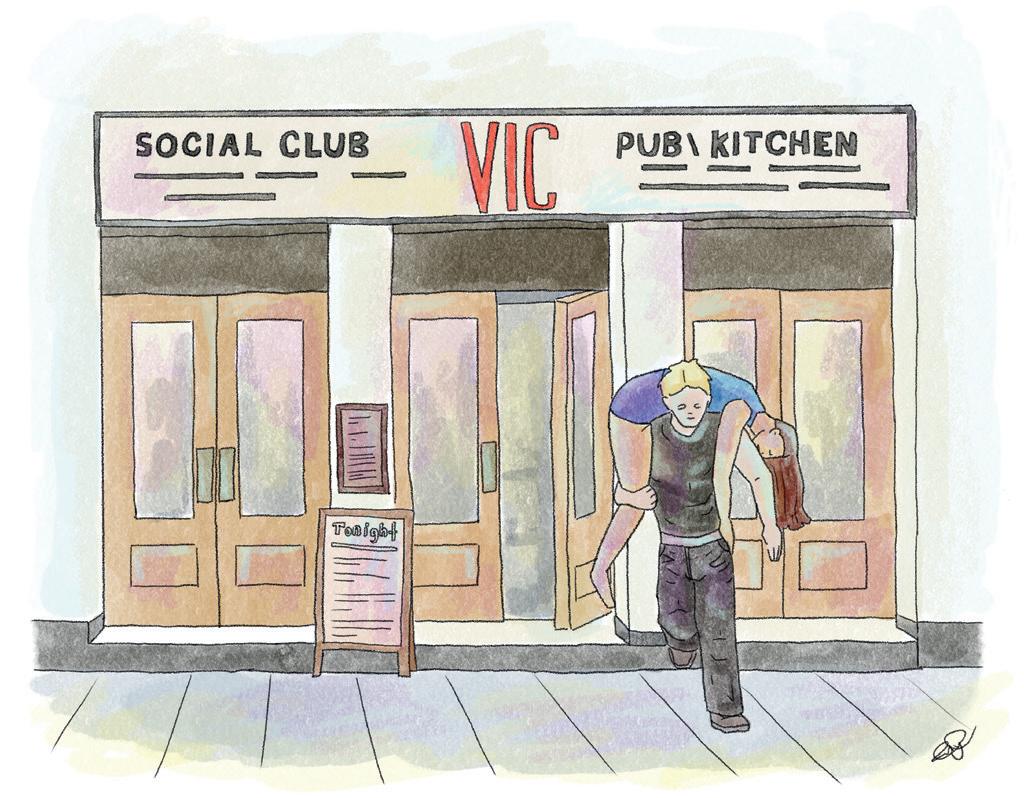
reputation as a Kate Kennedy Club haunt. The problem with The Vic seems to be a growing disconnect between its management and its actual operation. These changes don’t reflect the needs of the student body or the local community and it signals a much larger problem — a shift toward commercialization and tourist-oriented priorities. The Vic was
once a space for smaller music collectives to host events, offering a more intimate club setting than 601. And with the closing of the Picture House last year in favor of a celebrity owned sports bar — catering to the golf tourism clientele — it feels like yet another student space has been taken away from us. Our community spaces are under duress and our little town is at risk of falling victim to capitalist priorities. Many pubs and establishments have come and gone in St Andrews, and though rarely a favourite, The Vic has endured. But with plummeting drink sales, worsening student relations, and growing disinterest, how much longer can this town’s constant last? I suppose we’ll have to wait and see—will we next see another rebrand, or a permanent closure?
Illustration by Ruby Pitman
In Conversation with Ryan Van Winkle
An interview with the Artistic Director of StAnza Poetry Festival
ARNAZ MALLICK
The Relic Editor
The first words I exchanged with Ryan Van Winkle, the Artistic Director of the StAnza Poetry Festival, had little to do with the St Andrews-based poetry festival. He instead asked me about our newspaper. “You guys are still doing print? And do people actually pick it up?” Every other Thursday, I told him. “That’s a great feeling,” he said, then began talking about how he started in journalism before venturing into poetry.
Over the years, the StAnza poetry festival has maintained a focus on the interdisciplinary nature of poetry, highlighting the importance of sense, hearing, and feeling. Upon my asking why, Van Winkle said: “Emphasising feeling is one of the primary things you can get out of poetry, a strong feeling. You’re not turning to poetry for a narrative, necessarily, you’re turning to it for something else. And I think one of the things that people turn to it for is that punch-you-in-the-gut feeling, that makes your hairs on the back of your neck stick up. It doesn’t happen every time. I don’t want to lie to anybody and say that you’ll feel this in every poem you read. But when a poem hits you, it really hits you.”
“I
“I think it’s just an interesting way to play with space and different formats of delivering poetry, besides just putting a person on a microphone, and letting them stand there and talk to an audience.”
“But certain poems come out and grab you at certain times, you know? A lot of it is about timing. I’m partly trying to create opportunities for people to be in a different headspace. With concerts, for example, you spend a load of money to go see something, you’re in a venue, and then suddenly you’re doing your grocery list, or thinking, ‘I gotta call my mom.’ So I just want to try, during a poetry reading, to give something else, another stimulus to keep you in the room.”
I asked Van Winkle which events in the festival he would most recommend.
“Oh, you can’t make me do that! Which article in your newspaper would you most recommend?” I kept quiet, refraining from telling him that I have my favourites, and am perhaps not as kind-hearted as he is.
“They’re all great, they’re all my babies. There’s a ‘Poetry as Protest’ event, which is fantastic, it’ll be taking place on the street and then some poets will all be reading a protest poem of their own on any subject matter, and reading a poetry protest poem from history that they gravitated towards. We’re going to set it up outside on the street
so people can listen in a public setting.”
“There’s RJ Hunter’s masterpiece, the Stupid Sexy Poem Show. I think it’s just a tour de force. I saw it in Edinburgh, it’s done a Fringe run. It’s a very, very good piece of performance poetry, it’s a one-woman show. It hits all it does, everything it says in the title — it is funny, and it’s sexy, and it’s also incredibly poignant. It’s a different way of presenting poetry than people might have seen before. It feels more raucous and engaged.”
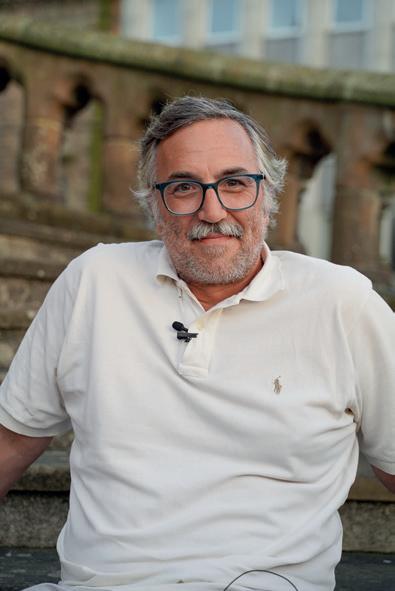
“If you’re interested in some fantastic Scottish poetry, you can check out Jackie Kay and Hannah Lavery, who are going to be on stage together. Our newest Scottish Makar, our poet laureate Peter Mackay and Jen Hadfield are going to be on stage talking to each other.”
“Sorry, did you say Peter Mackay will be part of the festival?” I asked.
“Yeah. Hometown hero.”
Van Winkle responded.
“He was my English tutor last year.”
“He’s good, right? He’s a good friend, and what a great choice for our poet laureate [Makar]. His poems are fantastic. You want
to put people like Peter in a room where they could just be chatting and break down a little bit of the formality. You know, I certainly spend a lot of time with poets, and maybe there’s a bit of a reputation around poetry, but they just like hanging around and having a chat, and laughing, just like anyone else. I think Peter is a great person to do that with, and I’m sure you know that from studying with him.”
As a last question, I asked Van Winkle what has been the most rewarding part of organising the festival?
Van Winkle didn’t hesitate. “Oh, finishing it. The end. The end of it is the most rewarding because then I can sleep.”
“Well, one of the most rewarding things is the audience. I’ll bump into somebody after an event, or I’ll hear them talking, and we’ll have a chat. Watching that happen, watching those connections get made between poet and audience. That, for me, is really the award, and the true, true delight of putting a festival together. Putting people together through art. It keeps me coming back to creating things like this.”
Just Want to See People Dancing on Tables”
Signpost: a new direction for live music in St Andrews
LAURENCE HEPWORTH Relic Writer
When I start our conversation by asking Ashvin Gupta what his title within Signpost is, he replies, “Signpost doesn’t really do titles.” We eventually settle on ‘co-founder’, but not until after he’s gone to great pains to stress that his and fellow co-founder Sage Purdon’s magazine/live music events brainchild is, first and foremost, a project led by a group of friends. It becomes increasingly clear as we chat that this easy-going ethos bedrocks everything that Signpost does.
We talk a few days after FS’ Skin show, for which a ticket would have set you back the dearer end of £100. On the flipside, this new venture, currently most notable for its organising of live music events (at Aikman’s and the Rule on Mondays and Fridays, respectively), offers a rather different proposition. The success of any of its gigs might be judged by how many tabletops metamorphosed into dancefloors, and the overall aim is to, wherever possible, benefit all parties involved with the concerts. This means that all the gigs are free
to get into. Ashvin (a third-year IR and History student) recalls feeling priced out of some social events during his first year in St Andrews. He tells me that Signpost is about eliminating the barriers to entertainment in a town where the options for whiling away an evening typically run expensive. “Every single time we do an event, it’s [a feeling of], how badly will the account be hurt if we don’t charge?”
But it’s not just about the audiences: when I quiz Ashvin on whether he thinks they should share in bar takings (since it’s their acts that are bringing more people through the door), he says no. “We’re just helping them out.” Signpost are also championing a
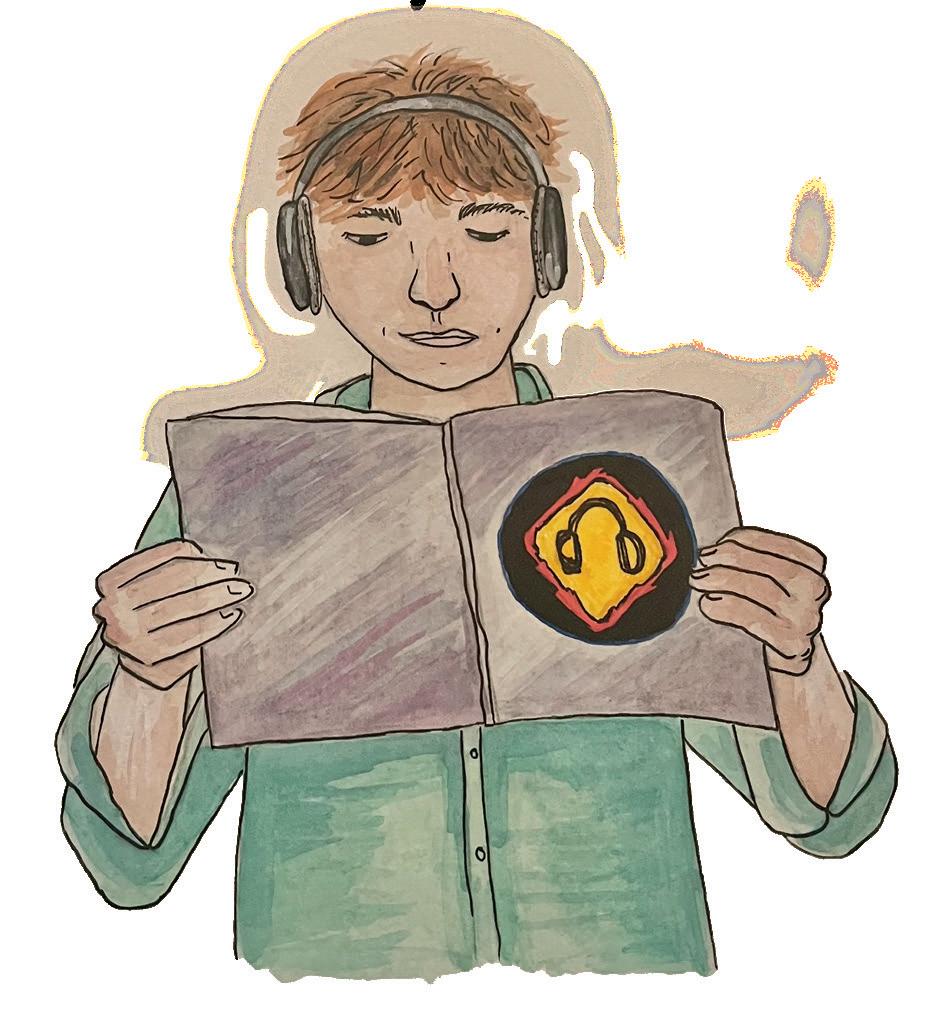
bevy of new bands, using their relationships with local businesses to help these groups secure gigs they otherwise wouldn’t. This scrupulousness is being rewarded: venues have reached out asking to be considered as hosts for upcoming gigs; and music management companies have been in touch offering the services of their clients. Indeed, this is how Signpost’s biggest coup came about, when, back in November, they were awarded the rights to market Welly (who at Reading festival 2024)’s performance Union’s 601. Ashvin describes this gig by far the biggest they have been involved with — as having been an instructive glimpse into the mechanics behind organising and running a larger-scale concert.
Signpost’s first six months has not been without snags, however. Ashvin relates a memory of being politely hollered at, whilst
he was speaking to a venue owner, by a band member who judged the PA system to be wanting. There was also the question of a not-insignificant fine in response to some more guerilla marketing tactics. But it’s a proposition that seems to be gaining traction. On the horizon is the ‘Battle Of The Bands’ event which will see groups from hosting Dundee, St Andrews, Strathclyde, and Stirling riffing it out for glory on 21 March. Early April will mark a first for Signpost in the shape of an ‘end of the world’-themed print magazine available for purchase. It’s hard not to draw a comparison between what Haus has done for the clubbing scene in St Andrews and what Signpost is doing for live music. Ultimately, the project is about bringing people together and having good times in an accessible way.
Ashvin says there’s a certain feel he’s going for with these events. He recalls being at a May Ball afterparty and seeing, amidst the carousing, one especially exuberant group: they were boogieing atop a dining table and decanting refreshments directly into onlooker’s gullets. “I thought, if I can have an event that influences people to do that, I would walk away very happy.”
Illustration by Isabella Abbott
Photo Provided by StAnza
AIDAN MONKS
Relic Writer
Last year, following the tenth anniversary of his sudden death, Philip Seymour Hoffman was heralded by The Independent as the greatest actor of the 21st century. This is not to say that virtuosic work — three of my personal favourites being Scottie in Boogie Nights (1997), Rusty Zimmerman in Flawless (1998), and Allen in Happiness (1998) — didn’t feature amongst his nineties corpus, but that his impact as an artist began to gradually bloom after the turn of the millennium. Hoffman had cemented his reputation as one of his generation’s most transformative performers, partially due to his trenchant commitment to privacy to make his on-screen personas more believable, but primarily down to his famously wide-reaching skillset. Having trained in acting at Tisch, Hoffman went on to work primarily in New York theatre (and delicatessens) while making incremental ripples upon the indie film scene, for example in the early works of Paul Thomas Anderson, with the occasional blockbuster like Scent of a Woman (1992) — otherwise known as ‘the one where Al Pacino goes “Hooah!”’ — entertained along the way. One tends to give pause when faced with the strange case of comparing an actor’s
Capote at Twenty
performance style across theatre and film as mediums, however, it is largely accepted that the best actors in cinema have served their sentences on stage, having trained somewhat formally and/or academically. Hoffman always preferred the stage, serving as Co-Artistic Director of the off-Broadway LAByrinth Theater Company, of which he had been an active member since 1995, where he produced and directed several productions including Stephen Adly Guirgis’ The Last Days of Judas Iscariot; his final stage part was the tapestried Willy Loman in Arthur Miller’s masterpiece, Death of a Salesman. Clearly, Hoffman was at home in leading parts on stage, more so than on screen, where his reputation remains as an esteemed character actor in supporting or featured roles — the exceptions being the divisive Synecdoche, New York (2007) and Hoffman’s Oscarwinning titular turn in Bennett Miller’s Capote, which turns 20 years old on February 24, 2025. By contrast, Truman Capote oscillated to the places he could be seen. As the film
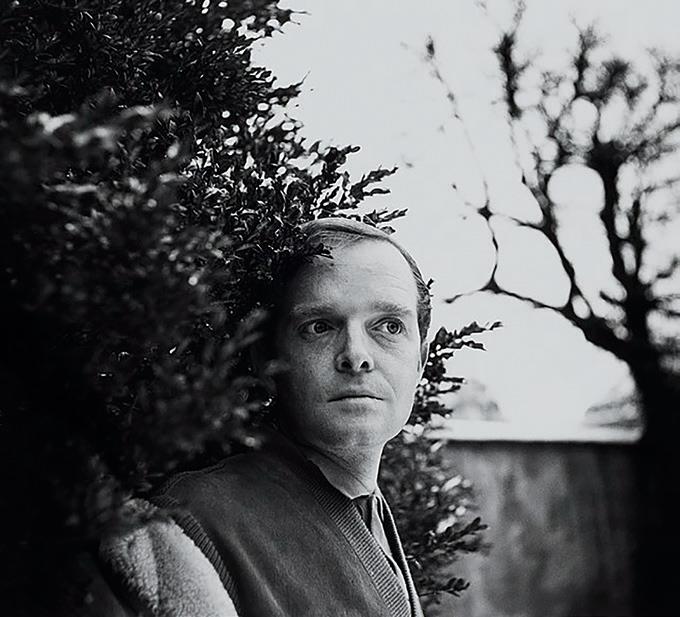
Capote exhibits, the writer was as much a showboating denizen of East Coast cafe society as he was a fine troubled observer of everyday life. Having achieved a whirlwind of acclaim at twenty-one with his poignant and surrealist character study, ‘Miriam’, the Southern author went on to achieve national recognition for his novella Breakfast at Tiffany’s — later adapted into the iconic Audrey Hepburn movie — and notoriety for his novel Other Voices, Other Rooms. By the time the Clutter family murders occurred in 1959, Capote was already relatively famous, a sought-after contributor to major publications like Holiday Magazine and The New Yorker which ran his book about the murders, In Cold Blood, as a four-part serial throughout 1965. Capote frequently described it as the first ‘non-fiction novel’, which he believed to be the genesis of a new form altogether: if it wasn’t, then it was the beginning of mainstream true crime as we know it today. Tom Wolfe, who influentially dubbed the movement to
which Capote belongs ‘New Journalism’, observed the authenticity of Capote’s approach to detailing the crime itself, building tension with elusiveness until the final display of barbarism; the importation of fictional formalities into the journalistic domain, so to speak. Capote cited In Cold Blood as the book he was always meant to write — though he personally preferred the flourishes of his early texts — and, as the 2005 film hauntingly states before the credits roll, he never finished another.
Watching Hoffman embody Truman Capote on the verge of his most acclaimed, successful, and immortal piece of work with the wisdom of hindsight, especially knowing that Hoffman would go on to win the Academy Award for Best Actor and consolidate his reputation as not only a character actor but a sometime leading man, teeters on the verge of ghostlike poetics. It is fitting. The film tells the story of In Cold Blood with severity and an adroit sense of finitude, which is precisely how delving back into the oeuvre of the late Hoffman, possibly the greatest actor of the century of which heonly experienced fourteen years, feels. His performance as Truman Capote is truly as mesmeric as it’s made out to be, lucid with the instinct and clarity of an artist inaugurating a tragically short-lived later style.
Image frm Wikimedia Commons
Culture Culture: The Origins of Cheese
REESE ABROMAVAGE
Relic Writer
My daily commute to and from town typically takes place on South Street, and thus I am required to pass I.J. Mellis at least twice a day. Recently, I have noticed that it is nearly impossible for me to avert my eyes from the glorious blocks and wheels stacked on the counter as I walk by the storefront, the perpetually open door tempting me with pungent wafts of cheese. I can’t remember a time when I didn’t love cheese, and now that I am responsible for cooking most of my meals, I can’t think of many recipes that wouldn’t benefit from a dusting of microplaned parmesan or a crumble of feta. Attempting to locate the origins of this love, I could consider my sympathy for the Stinky Cheese Man — a bedtime story character with a bacon smile and olives for eyes who was ridiculed for his odour in the children’s book The Stinky Cheese Man and Other Fairly Stupid Tales written by Jon Scieszka. Entertaining this possibility is amusing, but I likely love cheese so much because it was introduced in my diet early, and like many other humans, my appetite has fastened itself to cheese’s craveable qualities. Both mammalian milk and cheese contain
casein, which is a phosphoprotein that breaks down into casomorphin compounds when these dairy products are digested, releasing dopamine when attached to receptors in the brain. Along with casein’s effect on the human brain, the high fat content of cheese increases dopamine, activating feelings of pleasure, and this combination explains why cheese is so widely enjoyed and craved. In a mozzarella making class I took over winter break, I learned that the addition of rennet — an enzyme found in the stomach linings of some ruminant animals — to milk causes the casein to separate from the whey, resulting in a protein-rich curd that, when strained, can either be eaten on its own or pressed into cheese. To produce 100g of cheese, ten times the amount of milk is needed, which means that cheese contains a higher concentration of casein than milk, making cheese more craveable than its dairy parent. Not only does casein lend itself to
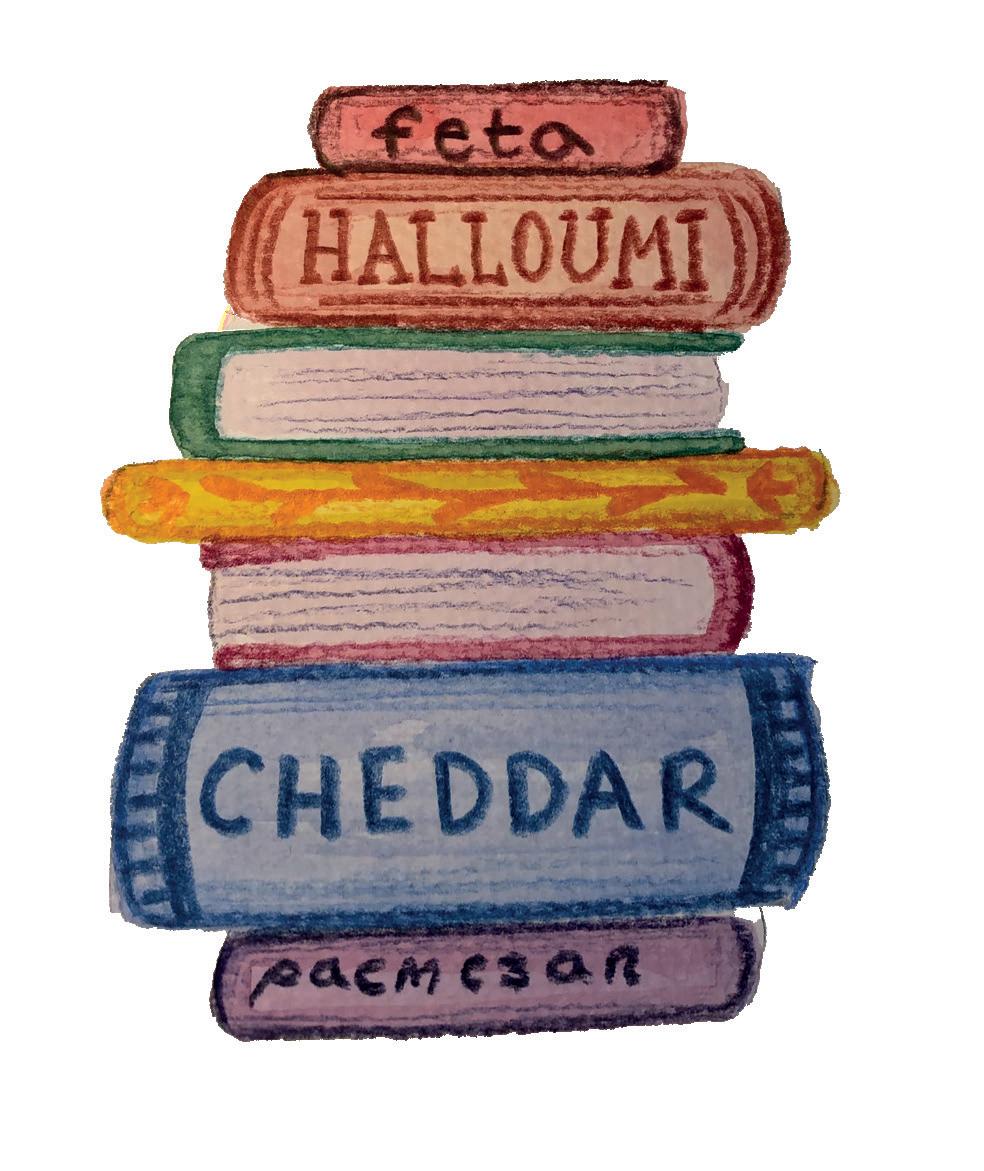
the addictive quality of cheese, but it also provides information about the etymological history of the word cheese which is derived from the Latin word caseus Although many of the cheeses that we enjoy today were created in the Middle Ages, evidence suggests that cheesemaking may have originated nearly eight thousand years ago. The curdling process we use today mimics the process discovered by humans who stored milk in ruminant animals’ stomachs for preservation. However, the creation of cheese has transformed from a practice to an art, pervading social and political environments from Ancient Rome onwards. Monks in Europe experimented with local bacteria, creating new cheeses in their monasteries, eventually giving way to the first factory
dedicated to the production of cheese in Switzerland in the nineteenth century. Returning to representations of cheese in the media, I’m sure most readers are familiar with the scene from Ratatouille in which Remy combines a bite of cheese with that of a strawberry, finding himself in a moment of culinary bliss represented by an array of colors swirling around his head. Many cheese boards at social gatherings offer the same possibility to conjure excitement, and the pairings of craveable cheeses with fresh fruits and cured meats allow cheese board eaters the ability to easily discover flavour combinations. This presentation of meats originated in fifteenth century France with charcutiers, who took pride in the display of the cured meats sold in their shops, eventually leading to the addition of a cheese course at formal dinners. Subsequently, charcuterie boards, as a form of informal dining, increased in popularity as cocktail parties began to take the place of formal dinners in the United States in the 20th century. And now, as I cast habitual glances at I.J. Mellis, my dreams of constructing an elaborate cheese board delight me as my subconscious recognises the scientific and historical culture enriched in the creation and consumption of cheese.
Illustration by Amelia Freeden

EDITOR: OLGA ALONSO BLANCO
St Andrews Musical Society Works 9 to 5
Putting ‘the Community’ into Community Theatre
AMELIA BEATTIE Events Writer
I don’t trust people who don’t like musicals — a bold statement, I know, albeit an honest one. There are plenty of arguments to be made for the significance of the genre as a diverse space, political medium, and inclusive community. I would argue further that it is also an accurate litmus test for how much fun someone is willing to let themselves have. With that in mind, on 19 February, I attended St Andrews Musical Society’s (SAMS) production of 9 to 5 the Musical at the Byre Theatre.
The production, running from Tuesday 18-22 February, came amidst an unusual dry spell of student-led theater at the Byre. Tickets were priced according to a pay-what-you-can system between £16 and £20. Whilst this system does make the production more accessible to some, it is still beyond the limit of what most students will be persuaded to part with.
With only the vaguest idea of the plot as being related to Dolly Parton, I truly had no idea what to expect. In fact, I was swept away by the truly baffling and breakneck plot of the show.
The performance began, rather surreally,
with a disembodied Dolly introducing a chorus of disgruntled office colleagues. The costuming and set department worked wonders to lay the scene of an end-of-itstether late ‘70s corporate world, complete with prehistoric looking xerox machines and enough flares to put ABBA to shame.
Kendra Laird opened the show as protagonist Violet Newstead with all the gumption as somebody who’s had their
Skene’s Doralee had all the drawling, bighaired, southern charm of Dolly herself. Nee brought the Backwoods Barbie to life as she swaggered the boards in stilettos with a sense of genuine heart and camp.
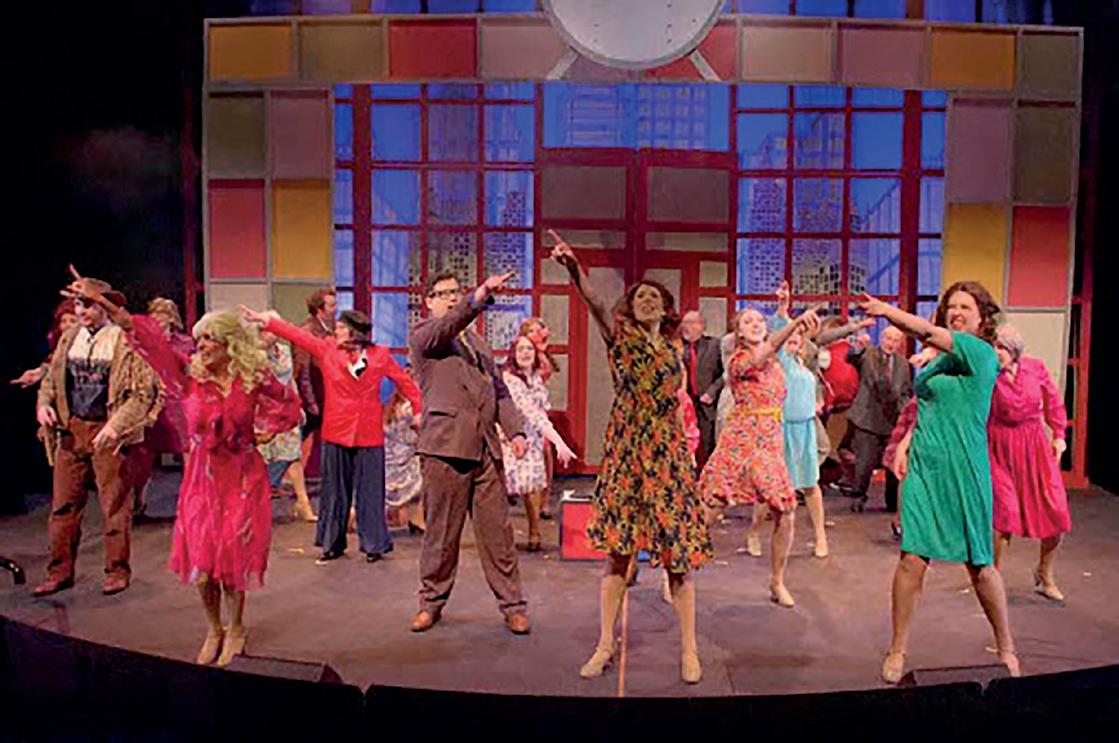
morning cup of ambition (I couldn’t help myself, sorry). Rachel Nee played Judy, with a charming new-girl nervousness that was both sympathetic and hilarious. Hannah
Noteworthy supporting performances were put in for the show’s antagonists by Mitch Scott-Bell and Carrie Cairney. ScottBell plays the despicable Franklin Hart with all the greasy sleaze of the worst ‘70s slick-back. Cairney stunned in her role as Roz, in only her second ever performance with SAMS, packing a powerhouse voice and undeniable stage presence. With the trio at the helm, the plot took off at a giddy pace. Often this swiftness could be weighed down by the production’s large ensemble cast. However, Claire Rioch’s intricate direction made for an immersive feel that had both warmth and depth. I found myself distracted at times
by the hilarity of the actions happening in the background. Every subtle eye-roll or stupefied reaction made it abundantly clear just how much fun every single person on that stage was having, and it was contagious! One could forgive the lack of commitment to some of the American accents.
The diversity of the cast, drawn together from across many age groups and walks of life, was an inspiring reminder of the necessity of spaces like this, ones that foster a sense of community and give back to it with genuine pleasure. SAMS has been doing this for generations, with a prolific performance history dating back almost 80 years. The cast has welcomed seasoned veterans of the company as well as relative newcomers, such as Cairney, who found their place centre stage. Whilst the etiquette of singing along at the theatre is not a hill this article is willing to die on, if you can resist to at least clapping along to an anthemic Dolly Parton tune, then your willpower scares me! So, to any adamant musical haters, I dare you to catch a well-produced production of 9 to 5 the Musical and watch out that you don’t start to actually enjoy yourself.
Photo by John Stewart
Something Different Seven Minutes in Heaven: Speed Faithing at the Chaplaincy
MRUNMAYI KAMERKAR Features Writer
Between a day full of classes in a week full of events, I found myself navigating the St Andrews Chaplaincy looking for Speed Faithing, an event hosted by Interfaith St Andrews. I walked into a lounge set up with two rows of chairs facing one another and thought I might be in the wrong place. At the end of the line sat Tom Rippon and Arielle Friedlander, Campus Leaders for Interfaith St Andrews, who greeted me with a smile and wave. The hour passed with the line of chairs going largely undisturbed. Yet, in between four attendees, we had our own little Speed Faithing square of stories, thoughts, and questions.
Speed Faithing is a space to discuss religious and philosophical beliefs in
short conversations. You discuss your personal connections to faiths of every sort and learn about those of someone else.
“It’s more about starting conversations than finishing them,” explained Rippon.
A testament to this mission, every time his timer went off, it was set against intense chatter. We passed the hour with slots of seven-minute conversations prompted by slips of paper with guiding faith-based questions.
“We wanted a range of questions. It’s important that people can come to it from any background,” explained Friedlander.
As someone who grew up with an atheist background, my exposure to religion was tied to cultural practices. Yet, I found I had things to say, explore, and ask each time I turned to the next person. Each question was picked “to find the right balance
between the doctrinal, the theological, and the practical”, Rippon explained.
Speed Faithing is designed to centre the individual. Abandoning any expectations of individuals speaking on behalf of their communities, it’s rooted in a principle of “taking people on their own terms”, and respecting how they define themselves. As everyone got comfortable with a cup of tea from the accompanying snack table, Rippon stressed the importance of letting people explain their faith without making assumptions as to what they might entail.
Our conversations centred around attendees’ personal connections with faith: for one person this meant journaling about the first flower blooming; for another, this meant exploring services across different Christian denominations. Between just us four, we shared
perspectives from connections to Judaism, Christianity, Paganism, and Hinduism.
The society’s first event of the semester, Speed Faithing captured the value of interfaith work in St Andrews. As Friedlander explained, “this town is very religiously interested,” but it takes time to see “exactly how big the tapestry really is”. Albeit within a small group, Speed Faithing started important conversations. To Rippon, the greatest value of these conversations lay in helping attendees learn to navigate but also explore difference.
“I thought the quality of the conversation was fantastic. [With] every new person you talk to you, find yourself even answering the same question slightly differently because you’re relating on different things. I had a lovely conversation about prayer and poetry — I wasn’t expecting that.”
Forget the Pub — It’s Time for St Andrews Cocktail Week!
ILARIA FRECCIA & ANA-LUCIA CHALMERS
Deputy Editor-in-Chief & Sci-Tech Editor
Last Thursday, we were lucky enough to get a sneak peek into St Andrews Cocktail Week. Running from 14 to 23 March, a Cocktail Week wristband (which can be bought for £10 at standrewscocktailweek.co.uk) provides the wearer unlimited access to hundreds of discounted cocktails and huge food discounts at 28 different St Andrews venues.
We started at Forgans, where we were presented with their Cocktail Week Drinks menu. For £5 each, it included three drinks. The Strawberry Fizz is made with strawberry rum, gin with a hint of coconut, and prosecco. The Raspberry Bramble is made with vanilla vodka, Chambord, London Essence raspberry rose soda, and prosecco. Finally, the Irish Goodbye was made to be a twist on an espresso martini, made with Jameson black barrel Irish whiskey, espresso, and caramel. The flavours were new and exploratory, yet still reminiscent of familiar cocktails.
The next stop was Dune, where we enjoyed a delicious Honey Lavender Martini, which featured their homemade lavender syrup, and the Aviation, which was made with gin, maraschino liqueur, lemon juice, and créme de violet. The martini was
perfectly balanced with the sweetness of the honey and the lightness of the lavender. The Aviation was a sweeter, more floral cocktail, but it balanced well with the citrusy bitterness of the lemon juice. Dune’s Cocktail Week drinks range from £5 to £15. As you sip your cocktails and enjoy the view, add on some of their famous nibbles like their famous octopus hot dog, creamy and salty crab croquettes, buttery smooth trout pastrami with créme fraiche and rye crisps, and oysters. Despite the floral nature of our cocktails, each of these nibbles complimented them perfectly and served to make a highly enjoyable (and absolutely delicious) experience.
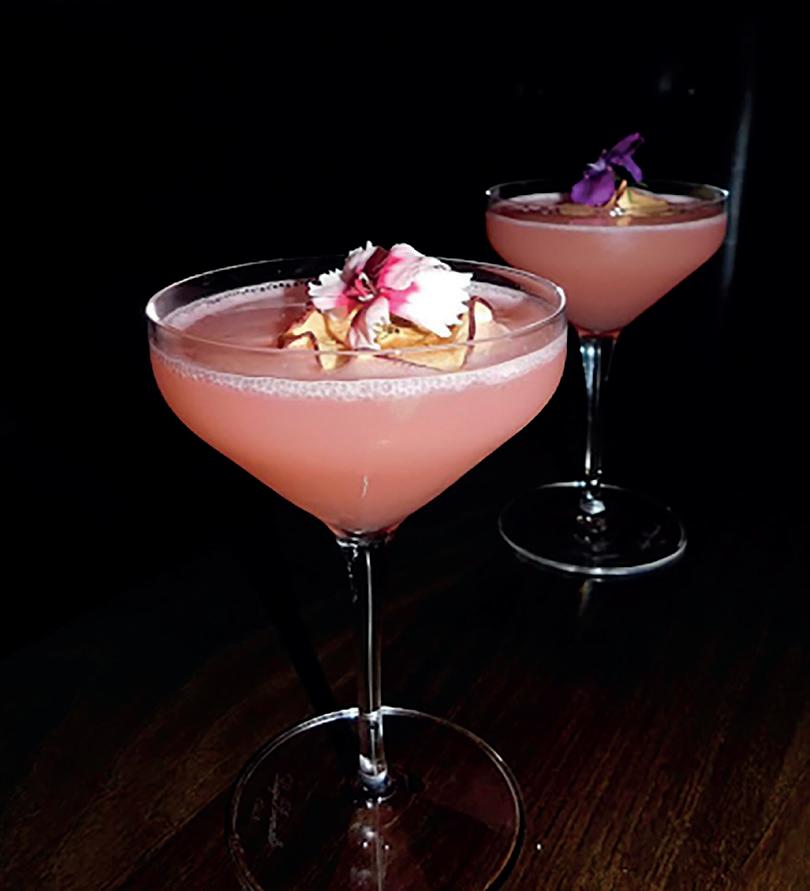
After Dune, we made our way over to One Under, where we had the chance to watch them make their two new Cocktail Week cocktails. The Tartan Clover (£5 with
a wristband) was one of the most intriguing drinks of the night. A tribute to Scotland, it was made with Jameson black barrel whiskey (an Irish brand, but included in honour of the Six Nations), a specially made Tennent’s syrup, lime juice, and ginger beer. This drink was reminiscent of a mule, but the Tennent’s syrup added a pleasant hoppiness. Their second cocktail, the Jalisco Bramble (£7) is made from tequila, dry vermouth, briottet crème de mure, lemon juice, simple syrup, and topped with an olive. A spin on a classic bramble and martini, the taste of the tequila was cut by a pleasant sweetness and slight acidity from the lemon juice.
The next stop was The Physician, The Adamson’s cocktail bar. We sampled the Pharmacy, an existing cocktail on their menu and one of several that will
be offered for £5 to £7 during Cocktail Week. Made with gin, Passoa, apple, vanilla, and lemon, this cocktail felt like a combination of a pornstar martini and a cosmopolitan. The Adamson and Hatch will also be holding several Cocktail Week deals, so certainly make sure to stop by. Our last stop of the night was at Rogue, where we sampled their Jalapeño Popper cocktails. Rimmed with pop rocks that sizzled and snapped as we sipped, and topped with a slice of pepper, this drink was a unique twist on a spicy margarita that got better as we kept sipping. Slightly sweeter than a typical margarita, this had the perfect burn-the-back-of-your-throat kick without being overpoweringly spicy. Balanced and creative, this surprised us by being one of our favourite drinks of the night.
If the last five minutes of your time that you’ve spent thinking about all the delicious cocktails St Andrews has to offer hasn’t convinced you to try out St Andrews Cocktail Week, let this — most of these cocktails are cheaper than a pint at the pub. And even better, there are food deals too! Forget your Tesco meal deal and dine on oysters and bonbons as you sip a luxury, handcrafted cocktail. You’ll have a great time — I know we did.
This article is kindly sponsored by St Andrews Cocktail Week.
Photo by Ilaria Freccia
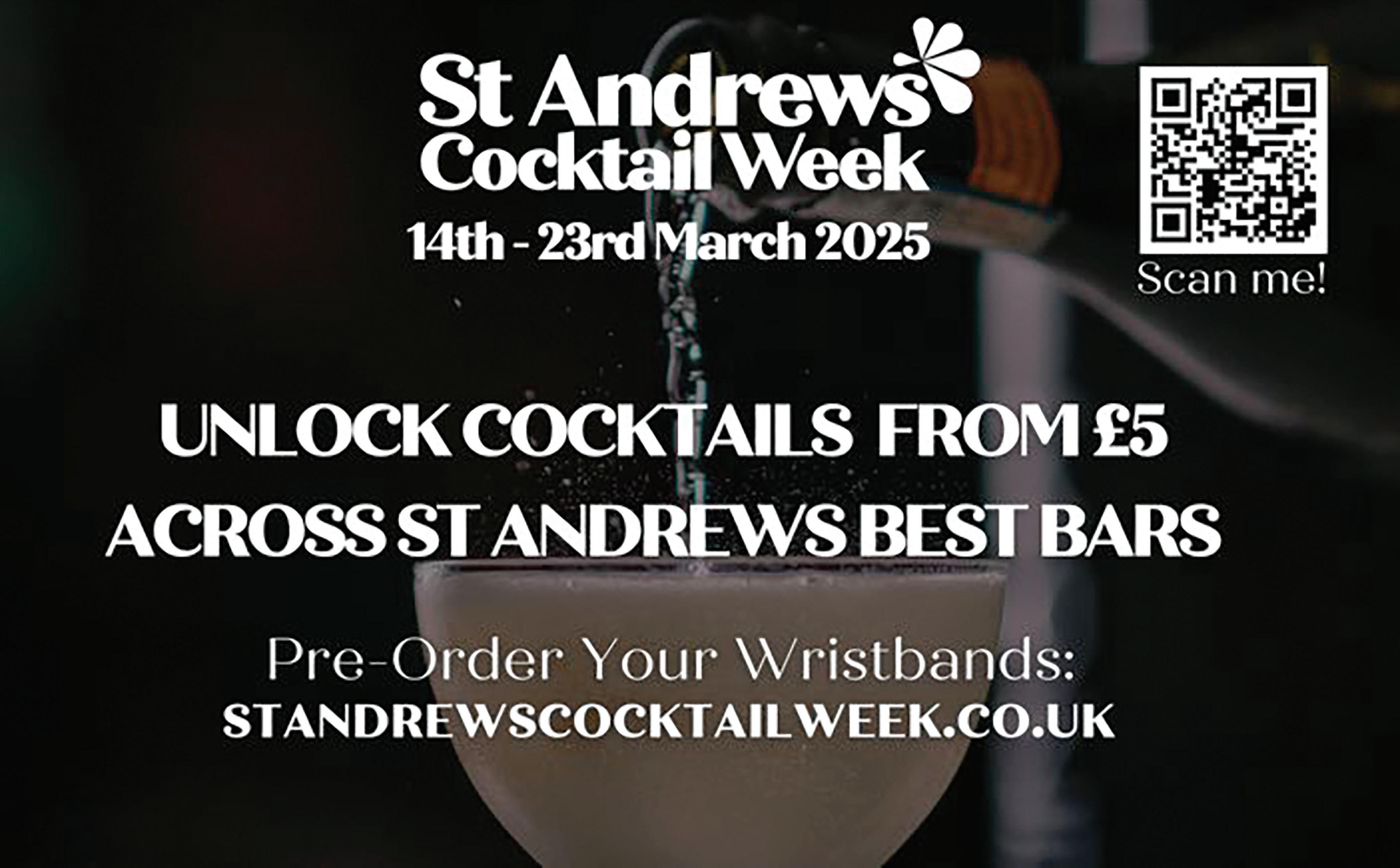
Sci-Tech
ALICIA SVENSSON Sci-Tech Writer

EDITOR: ANA-LUCIA CHALMERS
Hair and Nanoparticles
The unlikely heroes of oil-spill cleanup
Oil spills are one of the major ways that we pollute the planet, with around 706 million gallons of oil entering oceans every year. Oil spills can cause sealife to inhale toxins, become smothered, contract hypothermia, or drown. These are only the immediate consequences and do not include the lasting effects of crude oil derivatives that form with time. Traditional clean-up methods focus on containing the area and then use different methods to collect the oil from the surface of the water. Some new methods have recently been developed in this field, such as the use of nano-materials and human hair. But before we can talk about the new, we must talk about the traditional ways of dealing with oil spills. Some of the most common methods involve the use of skimmers, sorbents, and burning. Skimmers are dependent on oil boomers, which contain the oil spill to a specific area; however, boomers are confined to smaller
spills and are sensitive to changing tides. The skimmers are then attached to boats and skim the surface of the water to collect the oil. The downside of skimmers is that when there is debris present, it can clog the machine. Sorbents are also effective for smaller clean-ups as they absorb the oil, but can only hold a certain amount of it. Some organic sorbents also absorb water, and will eventually sink. The final method is burning, which is primarily used when the removal of oil is critical. The downside of this is that fumes are created by the burning oils, and its success is affected by waves and wind. These methods are tried and tested, but there is a need for more effective and speedy techniques. One of these techniques utilises nanoparticles, which can alter the binding ability of solids to liquids and can be used to separate shorelines and oil. This makes it easier to contain the harmful substance. Nanoparticles have also been used to form long fibres that create a gellike network that floats on the surface of the
water and can be collected by boats. Magnetic nanoparticles have also been used as alternative sorbents. Together with magnets, these have a higher absorption ability and last longer than traditional sorbents. Another promising new sorbent is human

spills and also in booms for ocean spills. The traditional way of cleaning up land spills is with mats made from polypropylene,
which is a non-biodegradable plastic. This creates an unfortunate loop where more oil needs to be drilled to clean up the oil spilt from drilling. Matter of Trust is an organisation that produces these mats and booms out of donated hair and fur. Although they may not be as successful as nanoparticles, they are produced using renewable resources and are cost-effective. These are only two alternative ways of oil clean-up that have recently been researched. This is still an active field that needs to be researched and developed for large-scale use. Nanotechnology is a relatively new area of research that has potential, both independently and also in combination with bio-based solutions, such as hair sorbents. The biggest hindrance to effective oil spill clean-up is the lack of funding dedicated to developing new clean-up techniques. With more awareness, we can help resolve this issue and protect our oceans for future generations.
Time Travel: From SciFi to Reality
BHANI KAUR Sci-Tech Writer
Time has always fascinated humanity — we think of it as a river flowing inexorably forward, carrying us from the past to the future. But what if time is not as rigid as it seems? What if, under the right conditions, we could bend it, slow it down, or even travel through it? Modern physics, built upon Albert Einstein’s revolutionary theories, has transformed time travel from science fiction speculation into a legitimate field of scientific study. While we are not building DeLoreans or TARDISes, the science behind time travel reveals a universe far stranger and more flexible than we once imagined. Einstein’s theory of relativity revolutionised our understanding of time. He showed us that time is not a fixed, universal constant. Instead, it is relative, changing depending on how fast you’re moving or how close you are to a massive object like a black hole. This phenomenon, known as time dilation, has been
experimentally confirmed and forms the basis for our understanding of time travel. Believe it or not, time travel to the future is possible — it is happening right now. Thanks to time dilation, astronauts on the International Space Station age slightly slower than people on Earth. While the difference is minimal — just microseconds over months — it proves the phenomenon is real. To make time travel to the future more dramatic, you would need one of two things: either travel at extremely high speeds or get close to a massive object. As you approach the speed of light, time slows down relative to those moving slower. A trip at near-light speed could allow you to experience just a few years while decades or centuries pass on Earth. Intense gravitational forces, like those near black holes, slow time dramatically — minutes spent there could equal years elsewhere. The catch? This kind of time travel only works in one direction: forward. Paradoxes like the Grandfather and the Information Paradox suggest that nature might have built-in safeguards to prevent backward time travel.
Scientists have identified three theoretical ways we might travel through time, though all remain far beyond our current technology. One possibility is wormholes — tunnels in space that could connect two distant points, potentially even different periods, like a shortcut through the fabric of spacetime. Another is Closed Timelike Curves, which could exist in rotating black holes. Spacetime becomes so twisted that it loops back on itself, potentially allowing travel to the past. Finally, cosmic strings — hypothetical threads of incredibly dense matter that could warp spacetime so severely that they might create paths back in time. While these ideas are mathematically possible, they would require technologies and energy sources far more advanced than we can currently build. The hurdles to overcome are significant. Creating a wormhole or manipulating spacetime requires more energy than our solar system contains. We have no evidence that exotic matter with negative energy exists; it may violate the known laws of physics. Many physicists, including Stephen Hawking, believe nature
prevents time travel to avoid paradoxes. His Chronology Protection Conjecture suggests that the laws of physics inherently protect the timeline from being altered. While time travel remains a distant dream, studying it has led to profound insights into the nature of spacetime, gravity, and the universe. Experiments with atomic clocks on satellites have confirmed time dilation, and ongoing research into black holes and quantum mechanics continues to push the boundaries of our understanding. We might one day discover a loophole in the laws of physics that makes time travel possible. Time travel to the future is already happening — thanks to the quirks of relativity — but travelling to the past is a much harder nut to crack. While math allows for it, practical challenges and paradoxes suggest that nature might have other plans. For now, time travel remains a tantalising possibility that keeps scientists and dreamers alike looking to the stars (and the clock) for answers.
Illustration by Janya Malkani
LOGAN SIBBALD Sci-Tech Writer
In the blackness of a hospital ward, lit only by brief flashes from various whirring machines, the brightness of your phone burns the backs of your eyes. Blinking only when you catch glimpses of rogue hairs on the pillow where your scrolling hand rests, a lycra-doned, hair-slicked, rose-cheeked influencer on the other side of the screen holds a fifteen-millilitre juice shot in one hand, and a couple of goji berries in the other, promising to give you your life back. This was the reality for followers of Belle Gibson — an Australian wellness scammer who falsely claimed to have cured her own brain cancer, and a plethora of other fictional health issues, through diet. Last month, Netflix released the six-part docudrama Apple Cider Vinegar, which chronicles Gibson’s deception and insidious impact. Force-feeding her viewer’s misinformation, Gibson caused some of society’s most vulnerable individuals — cancer patients — to forgo life-saving treatments, including chemotherapy and radiotherapy, for fad diets and pseudo-scientific practices. Gerson therapy — which was also promoted by fellow Australian wellness influencer Jessica Ainscough, who the inspiration for the character Milla Blake in the Netflix series — is one of the absurd dietary practices that Gibson encouraged. This scientifically
Health is Wealth?
The dangers of wellness culture
unfounded regime, which is specifically targeted towards advanced cancer patients and based upon the falsity that cancer is caused by disrupted metabolism, consists of a diet of thirteen freshly juiced fruit and vegetable drinks, and five coffee enemas, per day. Not only does this method have no scientific evidence to support its claims, but it has been deemed ‘very harmful’ by Cancer Research UK and ultimately led to Ainscough’s, and her mother’s, death from epithelioid sarcoma and breast cancer in 2015 and 2013, respectively. With the advent of social media, the popularity of alternative medicine practices and unconventional remedies has dramatically increased, perpetuated by so-called ‘health and wellness’ gurus. This is particularly harmful to people already suffering from life-threatening conditions, with cancer patients who forgo conventional treatment for alternative medicine two and a half times more likely to die, according to data analyses published in the Journal of the National Cancer Institute in 2017. Influencers, and the toxic online
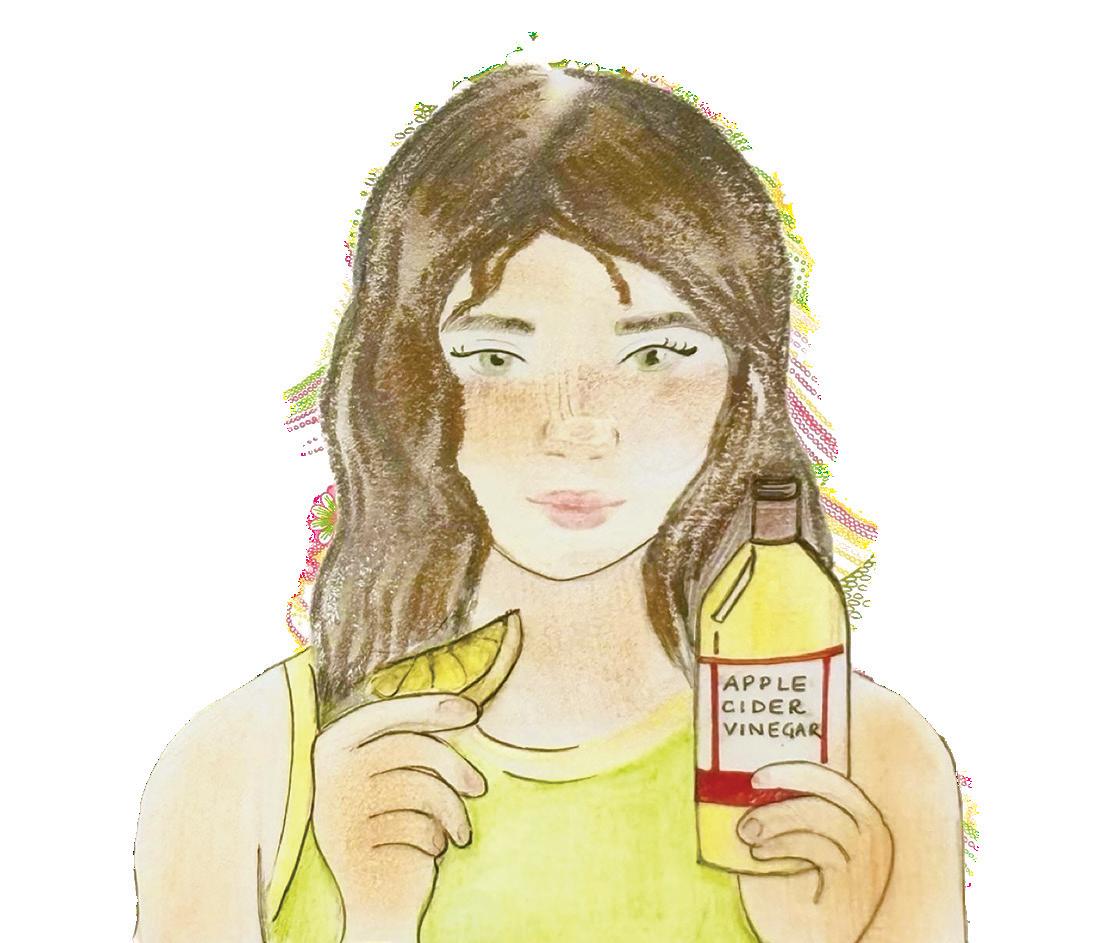
communities they lead, propagate a culture which promotes certain foods and dietary practices that are perceived as being healthy, like drinking celery juice, and demonises others based on misconstrued information — like criticising people for not separating the egg white from the yolk on the basis that it contains additional cholesterol. However, scientific scrutiny of these promotions tells a contradictory story. While juicing celery removes all the healthy plant fibre, essentially reducing it to green water, whole eggs (that is, including the yolk) provide all
nine essential amino acids, as well as choline (a nutrient important for brain health and muscle control) and vitamin D, which supports bone health. Ignoring any real scientific evidence, cultural health trends have changed over the years to fit society’s toxic beauty standards – particularly those that are imposed on women and young girls — from the grapefruit diet which was popularised
Drink It, Then Wear It
in the 1970s as a method to lose weight, to the ketogenic diet of recent years. These toxic trends are pervasive and have a festering online presence. It was only last year that Steven Bartlett, Dragon’s Den entrepreneur, had a guest on his Diary of a CEO podcast who claimed that a ketogenic diet could be used to treat cancer and deemed chemotherapy and radiotherapy ‘medieval cures’. A subsequent BBC investigation highlighted Bartlett’s dissemination of dangerous health misinformation to a vast number of listeners, with his podcast being ranked number one in the UK in 2024. The basis of how online health trends develop and grow in popularity is a combination of insecurity, pressure, and expectation. It is this buzzword-fuelled promotion of seemingly tangible cures which convinces us to tap the ad for bovine colostrum, raw milk, or lion’s mane. In the case of cancer patients, however, including those who suffered under the influence of Belle Gibson, the main factor in their departure from Western medicine is one thing and one thing only — hope. When your hair has fallen out and the very marrow of your bones ache, promises of all-natural cures or ‘You Haven’t Tried This Yet!’ schemes offer a flicker of light in a space of insurmountable darkness. While they are presented as quick-fix elixirs, these magical potions will leave you with, at the very least, an awfully sour taste in your mouth.
Illustration by Janya Malkani
How a startup is turning beer into leather
MATTEO VERATELLI Sci-Tech Writer
It was a day like any other in South London. Flocks of people were whiling away in local pubs, and in one of those, two men, unbeknownst to each other, were about to meet and come up with an idea that would revolutionise the tanning industry.
Brett Cotten, a Cambridge Biotechnology graduate, and Edward “TJ” Mitchell, an Oxford Inorganic Chemistry PhD, were just there to enjoy a beer with some friends. Both vegetarian, the two new friends began thinking about a way to replace polluting leather with a new environmentally friendly and cruelty-free alternative. The idea came through a quick look at the area they were in: Bermondsey. Former hide tanning centre of the City of London, the district is now better known for the ‘beer mile’, a stretch of road
dotted with more than 20 breweries, a variety of taprooms, and even more pubs. There, more than 1,000 tonnes of spent grain (the waste product of brewing beer) are produced yearly; a leftover that is increasingly difficult to eliminate, tallying over 20% of the entire beer production. Most of it is repurposed as animal feed, but a significant amount is instead burnt or sent to landfills at an extra cost for the producers.
Cotten and Mitchell spotted the opportunity and began experimenting in TJ’s kitchen, using free waste from the local breweries. Their intuition proved successful, and in 2022 the duo launched Arda Biomaterials, a start-up producing ‘New Grain’, an animal and plastic-free alternative to leather.
The production process is simple. The proteins contained in the spent grain are separated by stirring, and through a chemical process are turned into compact strings. These are then poured into different trays based on
the desired texture and, after a day of rest, the material is ready to be peeled off. In addition to its customisable texture, New Grain’s colour and smell can also be altered. It has been observed that the colour can be chosen by picking different kinds of beer, with Guinness producing a darker black, whilst lagers make for a more brownish hue.
The product obtained is less environmentally impactful, and Mitchell claims it is significantly cheaper to produce in scale, allowing for a greener alternative to traditional leather making.
Indeed, leather is currently the source of eighteen percent of global industrial water pollution and is the main contributor to the textile industry, which produces one-tenth of the world’s gas emissions. Tanning is one of the main driving factors for deforestation, and traditional techniques require great quantities of water and generate significant levels of chemical pollution.
All of this, however, could be avoided. In a press release for Arda Biomaterials in June of
2023, Cotten noted that “leather isn’t a by-product of the meat industry, but instead an important coproduct that carries important value,” and states that “ten percent of the world’s spent grain would be enough for the global demand for leather.”
On top of leather-like material made from beer, many other companies have been researching ways to produce sustainable replacements for natural hide. Fruits, fungi, and even cacti have been among the candidates, but most still contain plastics or only have a small percentage of biological material.
That is why Arda Biomaterials has arisen as the most promising candidate, and having just secured a 1.1 million pound investment, the future looks bright for the young London start-up. With production starting this year, it might not take long before people will not only drink beer but also wear it.
Sport

EDITOR: MAHALEY WISE
Will Our University Sports Ever Catch Up?
PATRICK MAITLAND Sport Writer
It’s hard to admit, but some things are undeniable: the US has got college sports down to a tee. 100,000 people, students, and locals alike, staggering half-cut into a stadium, is a far cry from what we have in the UK. It certainly wouldn’t be simple, but could we match what they’ve got across the pond? After all, no one quite mixes drinking and sports like the British. There are several factors to consider before we get our hopes up. Firstly, the level of competition among US colleges is incomparable to that between UK unis. Division I athletes in America are touted to become the finest players in their respective sports, while here it’s generally accepted that the best of the best don’t take the higher education route at all. This is largely due to the contrasting league systems of the two countries. The UK has long been praised for its grassroots approach to sports, incorporating a top-to-bottom league system in sports like football, which means that any team can reach the top level. What that means for aspiring players is that, if you’re good enough, there will be somewhere for you to find your feet and make a name for yourself. If you’re trying to go pro in football and you’re reading this as a student, I’m sorry to tell you that your chances aren’t looking good. Sports like American football and basketball in the States do things differently, using a closed franchise system. As opposed to having multiple leagues where talent can lie, teams typically look at
the draft for the future and rarely elsewhere. Of the thousands of American players to grace the floor in the NBA, just 41 have gone prep-to-pro (skipping college). Clearly then, if you want to go to the NFL or NBA, your best chance is through college. Having the brightest prospects filter through college will naturally attract bigger crowds, as opposed to the mass of five-person mass expected at the average Sunday League game here. If the UK scene the same following as in the US, this level of competition needs to improve.
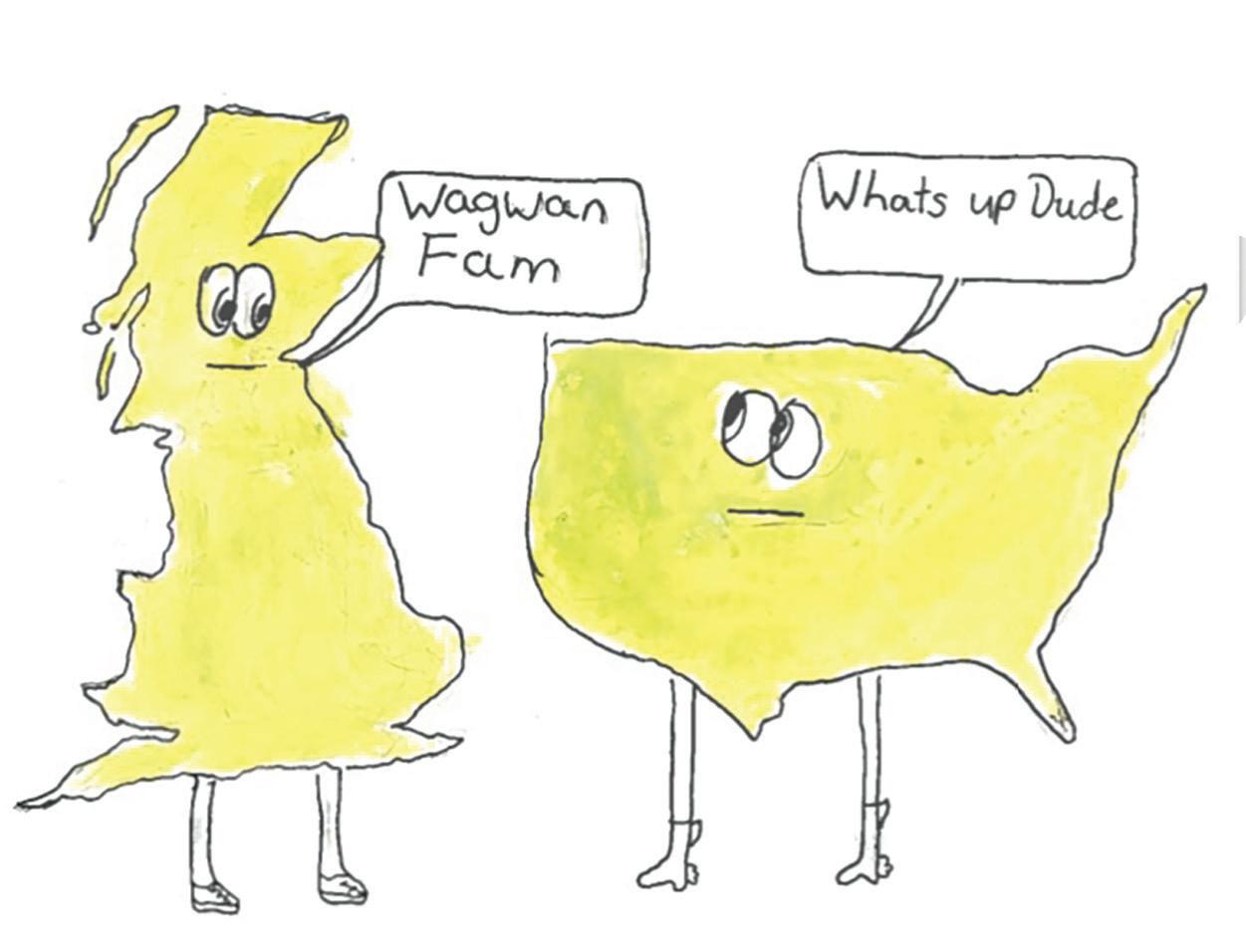
Another aspect that is completely different overseas is the media attention. College sports in the States are broadcast internationally through ESPN and Paramount+, attracting huge audiences worldwide. For example, the NCAA (National College Athletics Association) 2021 Men’s Basketball Tournament garnered an audience of 10.1 million. The only UK university sporting event to come
Football v Football
by Anne-Carter Riggs
In preparation for my intensive study of the sport I know as ‘soccer’, I decided to chat with someone who I know to have an unfound passion for it. Mason, known as @thecoysboy on Instagram, has become the American voice for the Tottenham Hotspur football club. Being both a football fanatic as well as an American, I thought it would be interesting to get his advice and outlook on the sport. I did not understand the pathway he had taken to becoming a football fan, and he did say it was not without its controversy. “A big sense of the motivation I had for it was the stigma against Americans when it comes to talking about this damn sport. Our UK counterparts often look down on us […] I’m on a mission to prove that some Americans “know ball.” Mason, in his 90 minutes (divided into 90-second videos), outlines the wild outcomes of each Tottenham Hotspur game. Often, Mason travels to one of the 150 Hotspurassociated bars in America, chatting with the other fans of
that close is the Oxbridge Boat Race, which had an audience of 4.1 million in the same year. Being shown on TV every year, this race is in itself an enormous outlier, with most uni sports relying on independent university broadcasts to pull in numbers. This problem could only be remedied by corporations like the BBC bringing competitions like BUCS into the mainstream, which currently seems unlikely. The US model also helps turn athletes into celebrities whose
consequent popularity turns more eyes on their sports. Even uneducated sports fans will know the names of Zion Williamson and Lamar Jackson who rose to fame with their performances at college level, but there has not been a single star to come out of British universities in the last five years. The cycle of producing talent and making them famous is what has served college teams so well, and the UK would do well to follow suit should they ever want to rival the US.
Finally, there is the simple issue of funding holding the Brits back. It’s not immediately apparent where UK universities — many of
the Tottenham team. It is his goal to visit all of them on one big road trip, watching a game and interviewing the people there. As he points out, “[The interviews] legitimise their own fandom to them. @Thecoysboy was my senior project, and I wrote a 30page research essay on sports fandom and how fandom is not a pathology, it is human.” One of his most viewed videos, pinned on his page, is one where he tells his Spurs story and how he became a fan of the team. “I love reading through the comments because it just encouraged so many other people to reach out,” he said. “What I want to prove is that every story is of equal importance.” Talking with him, the differentiation of the fandom to American sports became clearer. People love football, and it unites many strangers from all ages under a football club’s

which are already strapped for cash — would find the additional resources to revolutionise their sports programmes and hand out hundreds of new scholarships. Even if they were to, it would be a major gamble with limited potential upsides. Despite the popularity of college teams in America, many colleges make no profit at all from their sporting endeavours due to the cost of full-ride offers and upkeep of facilities. Thus the reluctance from UK universities to invest so heavily in their sports programmes is understandable. What keeps most colleges in the green is the attendance numbers, with the average college American football game in the SEC assembling roughly 77,000 fans. When you consider that the average premier league game has 44,000 spectators, it is unfathomable for university sport to ever reach the same level in the UK as it has in the US. The sheer scale of America and its population makes its college system viable. For reference, there are two stadiums in England capable of hosting a game of such magnitude, namely Wembley (90,000 seats) and Twickenham (82,000). Perhaps we should look at upsizing our elite sports leagues before beginning transformations on a university level. In reality, weekend tailgates and sold-out sporting venues are but a pipeline dream in the UK, and it’s not really something worth getting our hopes up for. The UK just doesn’t have the space or the population for sporting events to rival those in the US. Unless something drastic changes, we’ll just have to enjoy what we’ve got for the time being.
Illustration by Calum Mayor
triumphs and defeats: “You’re instantly best friends with all these locals around you who you don’t know, but you know what club they’re rooting for, and that’s enough.” When asking for advice on learning more, he said simply, “You’ve got a lot at your fingertips.” And, finally, he advised me to go to a Rangers game — or that of any other historic team — as the number of fans in the stadiun is often so great that you cannot hear anything over their cheering. It has been encouraging to see such a passion for the sport create deep seeded communities, but also a bit daunting because I have yet to choose a team. Hopefully it will not be too difficult, but we shall see.
Holloway
Illustration by Isabelle
ISOBEL LISHER Sport Writer
Stirrup the Conversations
Horse racing is a sporting event steeped in British history, well known for its lively grandstands, colourful jockeys, and, of course, the fastest horses in the country. And when it comes to student day at Musselburgh, there is much to be excited about, especially that extra twenty quid that came home in my pocket after experiencing some beginners’ luck on the bets. Although, amongst the drinking and socialising, are the horses really the main event?
Horse racing itself is on the extreme end of the sporting spectrum: the fate of the winner comes down to speed, strategy, and safety of both the horse and its rider. There are typically two race types — flat or jump racing — over a selection of distances from five furlongs (roughly 1000 meters) to two miles. Though when watching
thoroughbreds pacing it around the track, the longer distances hardly look far. It can also be extremely dangerous, with the chance of seeing a fallen jockey or horse extremely high over the period of a day’s races. Ambulances follow the track while races take place for precautionary measures; this is the only sport in the world where this occurs. The intensities of this sport are
who had the winning stride when I had a jockey’s name and colourway to shout for?
That leads me to the financial aspect of the races. With big prize money to win, it is not surprising that glamorous and prestigious events are put on annually in the British racing calendar, say the Royal Ascot, Derby, or Cheltenham Festival. And with the aforementioned potential winnings, to be won there certainly is a strong financial charm to the races. For many popular sports in British media, one could easily bet amongst friends or in a betting shop, but to be at a sporting event when betting booths everywhere makes the races unique. Within seconds, the favourite can change, making hte mental maths a sport within themselves —
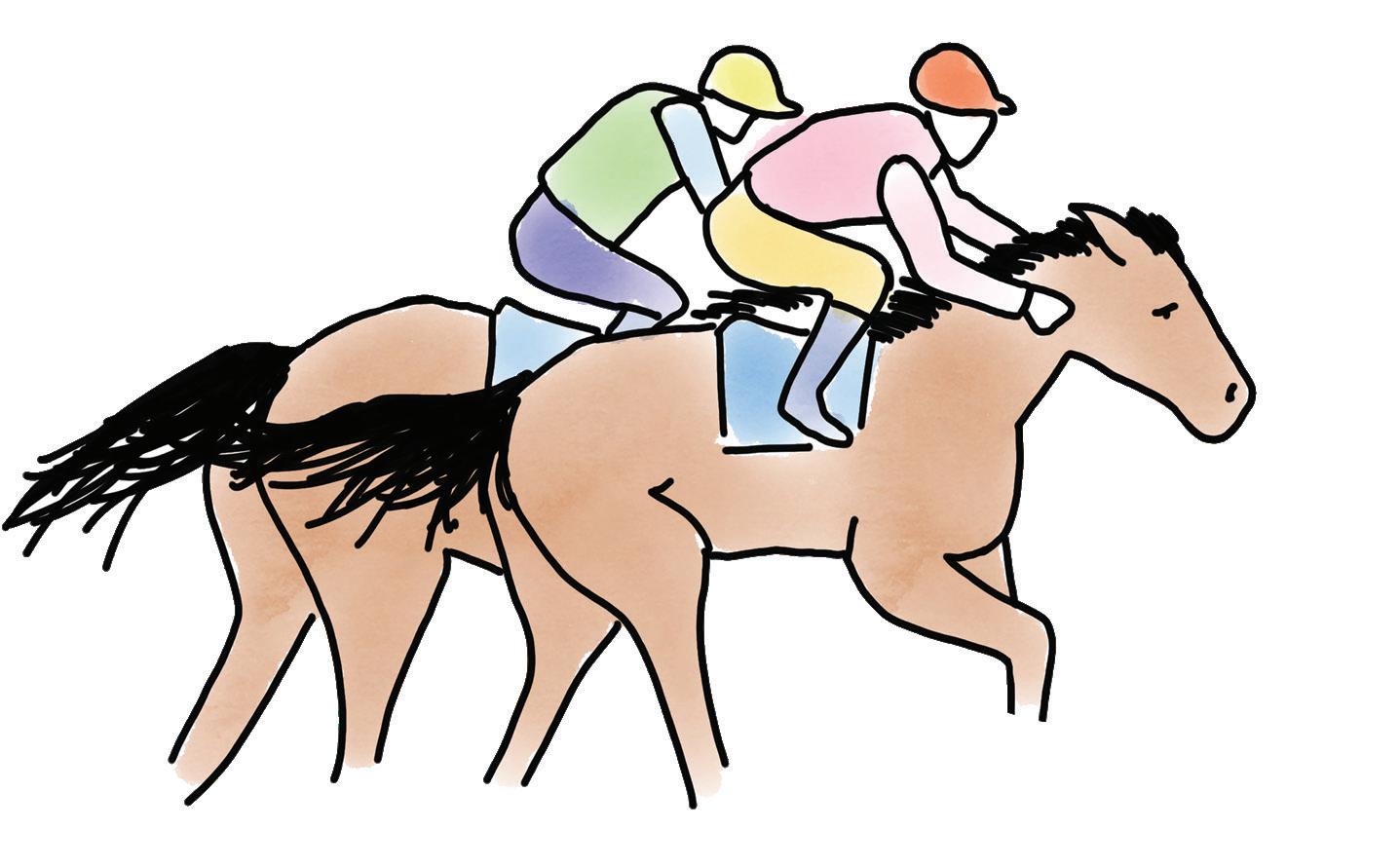
even for the most seasoned experts. For students, however, it may seem hard to believe that a sport which revolves so much around money is so popular across the country. Winning can obviously bring some extra cheer to the day, but it is the adrenaline, megaphones, pace of the horses, and day guaranteed free from the library that makes it the event that it is. Trying to distinguish your friends from the sea of other university students in tweed (just like a more chic convention, but slightly more tasteful), may be the most stressful aspect of the event. However, the student experience does not take away from the sport, rather it keeps its elevated presence in British media, especially as it is currently the second most popular spectator sport in the country. It is most definitely an athletic spectacle which has a rich history of being a surreal and extraordinary event, promising a fun day with no long faces in sight and plenty to laugh about.
Illustration by Alice O’Sullivan
Rowing at St Andrews: An Inside Look
SASHA WOLF Sport Writer
It’s no secret that sports are integral to the lives of many St Andrews students, whether you’re an official school athlete, joined a leisurely sports society just for fun, or are spotted every Wednesday at Sinners. The beauty of St Andrews is that you can take sports as seriously or unseriously as you desire. If you’re on the senior men’s rowing team, that means dedicating significant time to your sport. The senior team is the most advanced rowing team at St Andrews and the sport of rowing, also referred to as crew, is one of the most physically demanding sports on the human body. Just one stroke requires nearly 86 per cent of total muscle use. The senior men’s team at St Andrews practices six days a week, for multiple hours each day. First-year rower Cameron Joyce explained how the team schedule operates, his start with rowing at St Andrews, and how he balances his academic and athletic responsibilities.
The senior men’s team trains in different ways throughout the week, but they consistently have early mornings. They start with hour-long morning lifts on Mondays and Fridays, from 6:30-7:30 am. They also
have erg practices on Mondays, Tuesdays, and Thursdays, which consist of working out on a machine called an ergometer. The ergometer simulates the motions of rowing on water, so the participant can practice their rowing skills indoors. Joyce humorously informed me that ergs are “a rower’s worst nightmare!” Wednesdays are for water sessions, which begin at 1:15pm and wrap up around 5 or 6pm. Fridays are for independent training; rowers can spend the one-hour period choosing how they want to work out. On Saturdays, their practices start at 7am and end at 3pm. During peak racing season (between March and early July), the team trains from 6:30am to 2pm. The team is also unique because they do not assign specific rowers to certain positions. “Because of the way our team works, no one necessarily has a specific position in the boat. We are constantly switching it up,” Joyce mentioned. Joyce like the rest of his teammates, has previous experience with the sport. He began his rowing career in high school. He rowed for four years at Malvern Preparatory School and Conshohocken Rowing Club, both in his home state of Pennsylvania. He knew that St Andrews had a good rowing programme and sent his stats to the St Andrews rowing coaches before matriculating. By doing so,
he was able to secure a spot on the senior men’s team before he even arrived. After five months on the team, Joyce is happy with his decision. “It’s been a really good experience with great team morale,” he reflected. He is most proud of his victory at the Aberdeen Head of the River race, where he placed first in the men’s open quad. In July, he and the team will compete to qualify one of their mens 8+ teams for the Henley Royal Regatta. Thewy will participate in a 2,000-metre race referred to as a sprint race and a 5,000-metre race referred to as a head race. “I’m a little nervous,” Joyce admitted. Balancing academics with extra curricular
“It’s been a really good experience with great team morale.”
activities and a social life takes intentional skill and planning. I asked Joyce how he manages his studies of Economics and Geography with the demanding schedule. “If you miss a practice for a lecture or tutorial, you can just email the coaches and tell them when you’ll make up the time,” he explained.
Sundays are “off days” for the team, and can be used for makeup practices. “The men’s and women’s teams also offer different erg times, so if you can’t attend the 5[pm] erg, you can attend the 6[pm] erg instead,” he said. He doesn’t feel like his busy schedule hinders his social life either. “You spend so much time with the team and have socials every week, but there’s still time outside of sports to get together with other friends and attend different events,” he observed. There are many ways for students and athletes to get involved with rowing. Despite the intensity and difficulty of the sport, prior experience is not required to join. A trial period is held before teams are officially made, so if you show promise in form and speed you can start your career as a member of the senior team. St Andrews also has both a men’s and women’s novice team specifically intended for those new to the sport. If you aren’t an athlete, don’t fret! Just like many of our lovely sports teams, rowing hosts socials every Wednesday. There is no excuse to miss out!

